



























Serial entrepreneur Manoj Bhargava, creator of the hyper-successful 5-Hour Energy drink and multiple life-enhancing enterprises in Farmington Hills, is now betting big on delivering unfiltered news to the masses.































Serial entrepreneur Manoj Bhargava, creator of the hyper-successful 5-Hour Energy drink and multiple life-enhancing enterprises in Farmington Hills, is now betting big on delivering unfiltered news to the masses.

















Old National Bank has arrived in the Motor City.


















When it comes to hosting memorable meetings, MotorCity Casino Hotel means business. In addition to 67,500 fully renovated square feet of innovative meeting space, 400 perfectly appointed rooms, and a high-powered level of hospitality, MotorCity promises an unparalleled collection of spa, dining, music, and gaming experiences. So for your next meeting, make pleasure the first order of business. Learn more at MotorCityCasino.com












































This competition is the brainchild of Larry Gaynor, Founder & CEO of TNG Worldwide, entrepreneur, and author of TAKE A CHANCE!
101 Entrepreneurial Lessons for Making it Big. It provides a platform for entrepreneurs to showcase their ideas and gain recognition for their hard work and creativity, and serves as an inspiration to more people to pursue their dreams.

This competition is open to businesses from Michigan, offering them a fair and equal chance to shine. With its mission to encourage and promote exceptional talent within the state, TAKE A CHANCE! provides a level playing field for aspiring entrepreneurs to showcase their game-changing ideas and define the future of Michigan’s business landscape.


A panel of successful entrepreneurs will evaluate applications in six categories. The competition will take place September 6th, 2024 at the Gem Theater in Detroit. Michigan’s community will unite to celebrate the achievements of the entrepreneurs who will compete. In addition to the prize money, winners will be featured in local media and business publications, and more.
Application Deadline: May 31, 2024 at 11:59PM ET









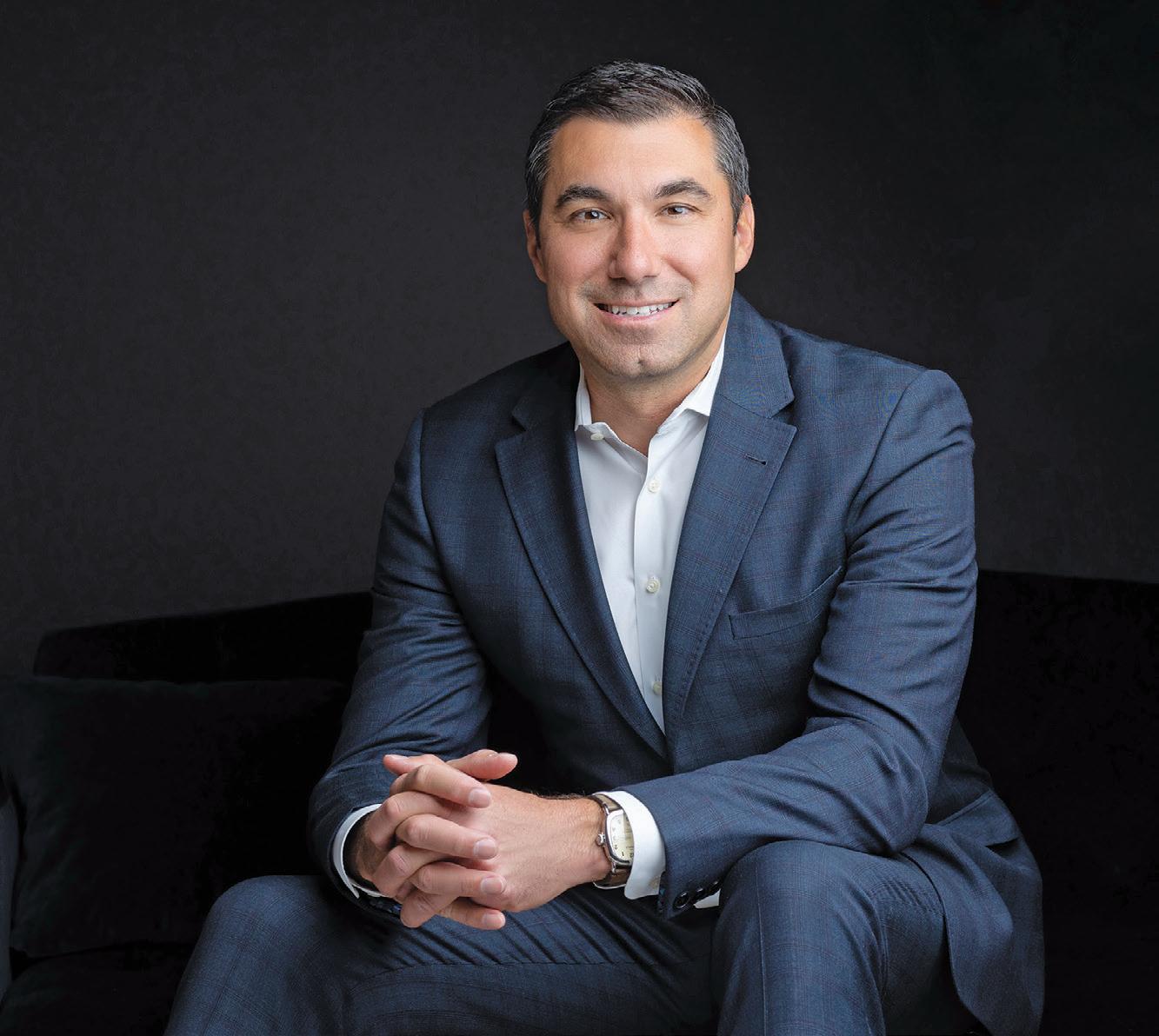




One-of-a-kind networking opportunities and compelling business content across a wide range of industries and topics await you at the DBusiness Breakfast Series.
DBusiness magazine’s event series are bi-monthly panel discussions and award shows.
2023 topics presented have included: Top Corporate Culture Awards, Commercial Real Estate Awards, 30 in Their Thirties Award Show and Powered by Women.
May 21st, 2024
30 in Their Thirties
August 2024
Powered by Women
September 5th, 2024
Detroit 500 Soiree
For more information and tickets to upcoming events:







Foreword
20 LETTER FROM THE EDITOR
20 READERS' LETTERS
22 CONTRIBUTORS
Commentary
26 ALTERNATING CURRENT
If the domestic auto industry didn’t have enough to worry about fulfilling government mandates for electric vehicles that are expensive relative to gas-powered offerings, take too long to charge, and rely on battery minerals largely controlled by foreign entities, now comes a wave of cheap imports from China.
26 CALIFORNIA WOES
California has adopted a tax-and-spend plan that no state should follow, especially Michigan.
26 ROBOTS RISE
To offset the recently negotiated boost in wages, look for the automotive companies to install more robots on new and existing production floors, offer fewer vehicle options, build more cars and trucks on common platforms, and work to reduce supplier and material costs.
28 COMPENDIUM
How outsiders view Detroit.
The Ticker
32 TARGET AUDIENCE
Opening an office in Royal Oak, Sabio Holdings Inc. works to drive sales in the digital age. By R.J. King
33 POINT OF CONTACT
Restoration 1 in Belleville advances its operation by hiring veterans. By Tim Keenan
33 ELEVATED RESEARCH
Airspace Experience Technologies Inc. in Detroit announced at the 2024 CES show in Las Vegas that it has signed an Other Transaction Prototype contract agreement with AFWERX. By Jim Stickford
34 FUTURES BET
With their recent union strike settled, how will Detroit’s three casinos perform? By Dan Calabrese
34 PDA Q&A
Bill Wild, president and CEO, Midwest Independent Retailers Association, West Bloomfield. By R.J. King
03-04.24

36 BON APPÉTIT
A new brasserie in the Book Tower in downtown Detroit embraces the city’s French roots. By R.J. King
36 OUTDOOR LIVING
Homeowners are looking to utilize their outdoor spaces for multiple purposes and in all kinds of weather, according to a new report from Deckorators, a Grand Rapids-based outdoor products provider. By Jim Stickford 74
Exec Life
70 A LA CARTE
Celebrity chefs, culinary students, and charities inspire a one-of-a-kind gourmet dinner. By R.J. King
72 RETURN ON INVESTMENT
Port of Call: South Lyon native Vinny Pyle brokers yachts throughout Florida, but he’s also found success operating complementary businesses in the Great Lakes State. By Tom Murray
74 PRODUCTION RUN
Baking Bonanza: Metropolitan Baking Co. in Hamtramck continues to expand, focusing on national growth. By Tim Keenan
78 PATENTS AND INVENTIONS
Fiber Founder: Credited with filing 36 patents, Okemos native Donald B. Keck and two other scientists introduced fiber optic cables that paved the way for the internet.
By Norm Sinclair
80 OPINION
Scaling EVs: The importance of quality assurance in navigating the EV landscape. By Keith Buckley
82 THE CIRCUIT
86 FROM THE TOP
Top Undergraduate Business Schools in Metro Detroit in 2024, Top Graduate Business Schools in Metro Detroit in 2024, Top 10 Mortgage Lenders in Michigan, Top 20 Home Builders in Metro Detroit, Top Circuit Court Judges.
90 CLOSING BELL
Margin of Freedom: William Lambert, a Black tailor in Detroit, tapped his entrepreneurial spirit to advance the Underground Railroad. By Ronald Ahrens
Our party pics from exclusive events. ON THE COVER Photograph by Jenny Risher



Fresh from a $23 million transformation all of our meeting and event spaces have been thoughtfully redesigned to suit any of your event needs from an intimate board meeting to a sophisticated celebration and everything in between. Experience all new guestrooms and suites, dine at Sullivan’s, our brand new Steakhouse and experience everything the city has to offer right at your doorstep. Connect with one of our meeting specialists today at 313-442-1616 or visit westinbookcadillac.com


As Detroit prepares to host the NFL Draft from April 25-27, more than 55 million viewers are expected to tune into the television broadcast, and an estimated 300,000-plus people will be in attendance.
the NFL Draft, there’s a great opportunity to channel more positive energy into our shortcomings.
Let’s start with education. Charter and private schools are doing a commendable job of preparing students for college, but union-controlled public schools are struggling and continue to earn low marks in national student test scores and graduation rates.
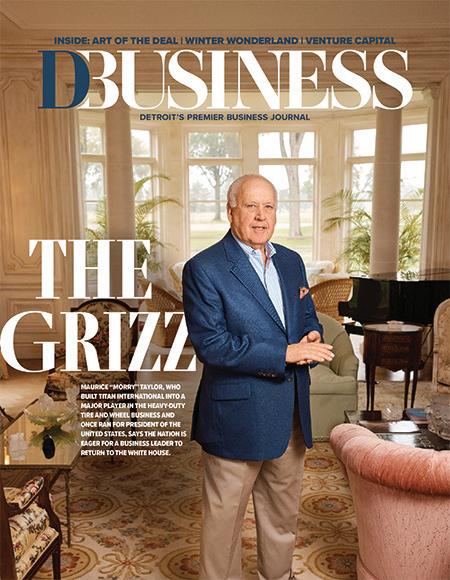
e main event will be held just east of Campus Martius Park in the Monroe Block, with related activities located along Woodward Avenue and spreading into Hart Plaza, which will host the NFL Draft Experience. Other gathering places throughout the city could enjoy audio and video feeds of the draft, as well.

While it’s easy to think throwing more money at public schools will solve the problem, as Gov. Gretchen Whitmer has long advocated, the real work of preparing students for the next level comes from focusing on individual needs.


Hotels, restaurants, and service providers across the region will reap the bene ts of the extravaganza — last year’s draft in Kansas City generated an estimated $164.3 million in economic activity. We could surpass that mark with a stretch of good weather and the fact that so many major cities are located within a 500-mile radius of Detroit.
Eager to host more events, Visit Detroit, the Detroit Sports Commission, the Downtown Detroit Partnership, and related government agencies have scored some recent victories like being awarded the 2027 NCAA Men’s Final Four basketball championship, which will be held April 3-5 at Ford Field.
e timing couldn’t be better. Downtown Detroit is vastly improved, thanks in large part to billions of dollars invested by Dan Gilbert and others. In turn, the neighboring enclaves of Corktown, Midtown, and Lafayette Park are undergoing major transformations.
But what happens when all the visitors leave, the red carpets get rolled up, and things return to “normal?” With so much time in between hosting a big game, a large conference, or an occasion like
Not every student can read, write, or understand all the sciences in the same way. More individual tutoring better identi es and addresses a student’s shortcomings, versus the one-size- ts-all curriculum the school unions embrace. e good news is there are plenty of retired professionals who could serve — and would be willing to serve — as tutors and mentors.
Next up is reversing the state’s population loss. Michigan can learn from states like Florida, Texas, and Tennessee, which attract more people due to low tax structures and the delivery of e cient government services. Businesses also are drawn to states and regions with a high percentage of college graduates.
Rather than working to lower taxes and making Michigan more competitive with other states, Whitmer and her team rely on o ering enormous tax breaks and incentives to lure new businesses. It’s like handing out life preservers instead of xing a ship that’s taking on water.
Because the infrastructure is now in place, Detroit is better able to pull in major events that generate millions of dollars in spending. If government leaders could roll up their sleeves and make the state more competitive, we could produce more college graduates, boost the population, and induce billions of dollars in new investment.
R.J. KingI applaud your recent editorial in the November-December 2023 issue of DBusiness for its basis of fact rather than being driven by emotion or political motivation. It’s refreshing to see someone responsible for reporting news to the public actually disclose the facts and (then) allow the readers to make up their own minds. While the information pointed to a serious problem and a lack of true leadership in our state, it allowed me to process the information and apply it in my own way. I hope, under your guidance, DBusiness will strive to be a fact-based reporting mechanism void of political, personal, and social media influences so we may all become better informed.
Hans W. Briedeni Grosse PointeI just finished reading your January-February 2024 issue, and honestly believe it’s one of your best ever. I particularly enjoyed the article re: Morry Taylor (a very longtime friend dating back more than 40 years), but also enjoyed reading about several other highly relevant topics, including “Crisis Mode” on page 23, “Compendium” on page 24, “Art of the Deal” on page 42, and “Angle of Attack” on page 74. I didn’t miss anything in between, but especially enjoyed the referenced articles. Kudos. Ron Lamparter Sterling Heights

they
the
pitfalls, to resolve high-stakes litigation and to craft contracts they can sign... with confidence.
your business differently. Get the Plunkett Cooney perspective.

Ronald Ahrens has been a regular contributor to DBusiness since 2007. His first story was about General Motors executive Bunkie Knudsen’s diaries. His first Closing Bell column ran in May/June of that year. Since then, he has contributed stories on topics ranging from Michigan’s cannabis industry to his January/February 2024 feature on Cathy Koch, president and CEO of K-Tec Systems Inc. in Ferndale. He has won several Alliance of Area Business Publishers awards for his work. In this issue, he welcomes five new members to the Century Club, and in Closing Bell he tells the story of William Lambert, a tailor and leader of the Underground Railroad.
Tom Murray has been a regular contributor to DBusiness for several years. He began his career in print, then made an unplanned turn to broadcast television, where he was an award-winning anchor and reporter for three decades, covering everything from sports to fine wine and true crime. His work for DBusiness is a return to his early aspirations in the business world: As a kid growing up in his native New York City, Murray’s regular summer job through high school and college was on the floor of the stock exchange. In this issue, he’s the author of the Return on Investment feature about South Lyon’s Vinnie Pyle, who brokers yachts in Florida.


Jenny Risher is a Birmingham-based freelance advertising and editorial photographer with nearly 20 years of experience. She specializes in automotive, pets, lifestyle, fashion, and portrait work. A graduate of the College for Creative Studies in Detroit, Risher also attended the Parsons School of Design/The New School in New York. She has published a book of her work, “Heart Soul Detroit,” which features portraits of 50 prominent Detroiters including Iggy Pop, Smokey Robinson, Jack White, Dr. Jack Kevorkian, Lily Tomlin, and others. In this issue, she photographed Manoj Bhargava for the cover story.
Jill Berry
PRODUCTION ARTIST Jonathan Boedecker
ADVERTISING COORDINATOR Amanda Kozlowski
GRAPHIC DESIGNER Jim Bibart
HOUR CITY STUDIOS
VIDEO PRODUCER Nicole Toporowski
VIDEOGRAPHER Heather Moody
DIGITAL
DIRECTOR OF DIGITAL STRATEGY Travis Cleveland
DIGITAL DEVELOPMENT MANAGER Matt Cappo
SR. DIGITAL DEVELOPMENT SPECIALIST Luanne Lim
DIGITAL DEVELOPMENT SPECIALISTS Jim Bowser, Connor McDonald
DIGITAL MEDIA ASSISTANT Robyn Banks IT
IT DIRECTOR Jeremy Leland
CIRCULATION
DIRECTOR OF AUDIENCE DEVELOPMENT Geralyn Wilson
CIRCULATION MANAGER Riley Meyers
CIRCULATION COORDINATORS David Benvenuto, Susan Combs, Cathy Krajenke, Rachel Moulden, Michele Wold
MARKETING AND EVENTS
MARKETING AND EVENTS MANAGER Jodie Svagr
MARKETING AND EVENTS COORDINATOR Jaime Presnail
COMMUNICATIONS AND PR Regan Blissett
MARKET RESEARCH
MARKETING RESEARCH DIRECTOR Sofia Shevin
MARKETING RESEARCH COORDINATORS Alyssa Fueri, Kristin Mingo
MARKETING RESEARCH SALES COORDINATOR Alex Thompson
MARKETING RESEARCH SALES ASSISTANT Theresa Lowery
GRAPHIC DESIGNER Kendra Okamoto
MARKETING RESEARCH INTERNS Natalie Brown, Caroline Johnson, Kelly Pham
BUSINESS CEO Stefan Wanczyk
PRESIDENT John Balardo
DIRECTOR OF BUSINESS OPERATIONS Kathie Gorecki
ASSISTANT OFFICE MANAGER Natasha Bajju
SENIOR ACCOUNTING ASSOCIATE Andrew Kotzian
ACCOUNTING ASSOCIATES Kate Manley, Austin Schmelzle
DISTRIBUTION Target Distribution, Troy




























































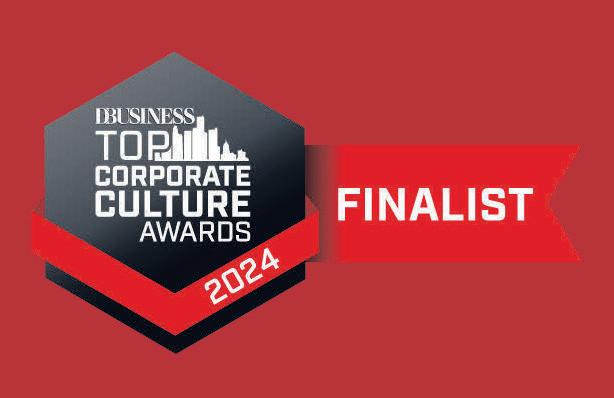

YANG
JAMES

I THINK THE ANALYSIS THAT WE ARE GOING TO SAVE THE PLANET WITH ELECTRIC CARS IS NONSENSE.”
— THE LATE SERGIO MARCHIONNE
53 THOUSAND
f the domestic auto industry didn’t have enough to worry about fulfilling government mandates for electric vehicles that are expensive relative to gas-powered offerings, take too long to charge, and rely on battery minerals largely controlled by foreign entities, now comes a wave of cheap imports from China.
Consider the average cost of an EV built in America is around $53,000, compared to $34,000 for a car with an internal combustion engine. In Europe, however, where Chinese automakers are now entering the marketplace with EVs, the price for a BYD Atto 3 SUV is roughly $43,000, while the MG5 EV has a starting price of $38,500. And that’s with an import tariff of 10 percent.
To keep Chinese EVs from the U.S. marketplace, President Joe Biden and his administration made sure the legislation for “Buy America” tax credits excluded imported vehicles. In turn, President Donald Trump instituted a 25 percent tax on Chinese EV imports. But those barriers might not be enough.
Already, China’s BYD could soon surpass Tesla as the largest producer of EVs in the world. Eager to maintain its leading manufacturing position and avoid U.S. tariffs, BYD and its domestic rival MG are making plans to build cheap EVs in Mexico. Chery, another Chinese EV producer, has already started building a plant south of the U.S. border.
At the same time, Polestar, which produces luxury EVs in partnership with China’s Geely and its Volvo unit, plans to start production of battery-powered vehicles in South Carolina later this year. The effort would allow the automaker to avoid the U.S. tariff. If successful, it’s only a matter of time before Polestar starts offering cheaper EVs to local consumers.
CALIFORNIA HAS adopted a game plan that no state should follow, especially Michigan. Last year Gov. Gretchen Whitmer and the then Democratcontrolled House and Senate put the state in peril by revoking Michigan’s Right to Work legislation, along with propping up failing public schools and passing a measure whereby taxpayers cover union dues for state workers.
What’s more, Michigan — which, under Gov. Rick Snyder, saw the state rank in the top 10 among multiple economic development measures — is now in the middle of the pack or lower. In five years of the Whitmer administration, the state is one of the worst for infrastructure, it has lost overall population, and its poverty level is on the rise.
At least the state hasn’t followed the path of California, a progressive enclave also controlled by Democrats that can’t seem to rightsize its workforce, keep its cities clean and safe, or prevent its wealthiest residents from fleeing the state. As Gov. Gavin Newsom and legislators scramble to fill a projected $68 billion budget deficit, they refuse to look in the mirror and cut spending and reduce red tape.
To fill its budget gap, California lawmakers are proposing a wealth tax on its most prosperous residents. The measure, which shows all signs of becoming law, will ensure that even more of the state’s highest earners leave for Texas, Florida, Tennessee, and other low-tax states. While Michigan has held the line on raising taxes, it must focus on passing legislation that doesn’t inhibit growth or prevent population gains.
34 THOUSAND 2/3 PERCENT
All of which leaves domestic automakers vulnerable to the Chinese government, which provides massive subsidies as it relates to global EV supply chains. Still, foreign EV producers face the same barriers to greater adoption of battery-powered vehicles in the U.S. — namely, too few public chargers, long charging times, costly repair expenses, upgrades to the electric grid so that two or more homeowners on a given block can charge their vehicles overnight, and minimal charging options in urban and rural environments.
As an example of the long road ahead for greater adoption of EVs in the U.S., Hertz announced in January it was selling a third of its fleet (20,000 vehicles) of mostly Teslas due to lackluster demand, high repair costs, and a decline in overall consumer spending. The car rental company follows the path of several domestic automakers that have cut their EV production plans due to waning consumer interest.
Another factor propping up domestic automakers is a 25 percent tariff on pickups produced in other countries. The levy has forced automakers like Toyota, Honda, Nissan, and Mitsubishi to build plants in the U.S. The effort has met some success, but it has been a struggle given pickup buyers in America are largely loyal to domestic manufacturers.
THE RECENTLY CONCLUDED UAW contract with the Big Three automakers included a 25 percent wage increase over the next four years. It is arguably the richest such agreement in history. To offset the boost in wages, look for the automotive companies to install more robots on new and existing production floors, offer fewer vehicle options, build more cars and trucks on common platforms, and work to reduce supplier and material costs.
While UAW President Sean Fain acknowledges the rising use of robotics on factory floors, he states more automation should be utilized to lessen the wear and tear on auto workers, rather than lead to potential jobs cuts.
Rather than highlight the loss of automotive jobs to automation, he should look at where new jobs are being created. Robotics is one of the fastest-growing industries in the world. There are plenty of high-paying jobs in AI, software development, and engineering that support robotics, and they don’t require a union.
Source: Cox Automotive
Looking at the big picture, the U.S. auto industry has benefited greatly from tariffs imposed on EVs and pickups. But if either one, or both, of those excise taxes are lowered or eliminated, General Motors Co., Ford Motor Co., the domestic arm of Stellantis, and even Tesla will have their hands full maintaining their respective market shares.
To help speed the transition from manual to automated production, the union should tap part of its funds to train existing members for the jobs of the future. The workers will come out ahead, and the unions will meet their mission of helping their members, even if it means the eventual demise of worker representation.
















THE WASHINGTON POST/ JAN. 21, 2024
BY KENT BABBHAMTRAMCK, Mich. —
After two years of war, the Rev. Daniel Schaicoski has his Sunday routine down. He looks out into the congregation, seeing familiar dread on the new faces dotting the pews of Immaculate Conception Ukrainian Catholic Church. He sees parishioners, many of them newly arrived from Ukraine, with husbands, fathers and brothers staving off the Russians back home. And he works into his homily a reason for hope.
“Sometimes you have to die to rise again,” he says. “I keep repeating that: After the ashes, my dear, a great country will be born.”
Fifty-five years old. Born in Brazil. Educated in Rome. The Vatican assigned him in 1999 to this church, built with brick and gold, in one of Detroit’s many insular enclaves. Michigan’s largest city, at once a symbol of vitality and failure, is vast and highly diverse; residents speak more than 120 languages and practice at least five major religions.
“A little America,” Schaicoski says. He was determined to fit in when he arrived, so he shrouded himself in the city’s
customs, in particular its loyalty to its hapless NFL team, the Lions. He watched his team lose so often, so reliably, that parishioners gave him a T-shirt: “The Lions Make Me Drink.” …
… Detroit is one of the most segregated cities in the country, with a vast wage disparity ...
Sports are supposed to help with that, but the football team hasn’t exactly done its part. With so many households experiencing struggle, whether global or more personal, the Lions haven’t been a reason for hope. They’re one more source of torment, a cruel birthright passed through the generations. …
… A dozen miles from Ford Field, locals gather at the Islamic Center of America, North America’s largest mosque, for dhuhr, the second of Islam’s five daily prayers.
Volunteer Mirvat Kadouh is here. A casual Lions fan, she made it to one game this season. …
… “We’re jumping on that wagon,” she says. “If the Lions can get to the Super Bowl, maybe even the Middle East has a chance.”
THANK YOU, DETROIT NBCSPORTS.COM JAN. 22, 2024
BY MIKE FLORIOBefore this weekend, I’d never been to Detroit. I now can’t wait to go back.
Yeah, I’ve been through
worked out that way. …
So, thanks, Detroit and Michigan, for being nice to someone who was born in Ohio and grew up as a Vikings fan, in a place that feels a lot like Michigan with mountains. As I said on PFT Live, I keep a very short list of places I’d move to if I ever leave West Virginia.
the airport several times. But it’s still not the same as being there. This weekend, I was there.
Fittingly, I went by car. It’s 5.5 hours, door to door. Very easy drive, except when we almost took out a pair of deer that were in the middle of the road licking some of the salt that had been scattered.
I loved it there. It has a great feel. Real and authentic and, yes, gritty. The people were extremely nice. Everyone. Friendly. Happy. Helpful. Authentic.
For instance, a group of (Ford Field) stadium workers was outside as the “Football Night in America” cast showed up and walked in. They were genuinely thrilled to see us (not me but everyone else). One of them declared it was “the best smoke break ever!”
All day long, the stadium workers were happy to see us. As one of them told me, “We love it when NBC is here, because when NBC is here that means good things are happening.”
Good things are indeed happening. And it shows the power of sports to pull communities together. It’s still the one thing that unites at a time when so many things divide.
The stadium has a great feel. Where the field is, it looks and feels great. In the bowels of the stadium, it feels rough and tough and real.
I never had a reason to go to Detroit until this weekend. I’m glad it
After the Michigan Wolverines put the finishing touches on a perfect season on Monday night, outclassing the Washington Huskies 34-13 in the College Football Playoff national championship game in Houston, the asterisk calls came flooding in. Michigan, which finished 15-0, was embroiled in two scandals this year. One involved reports of recruiting violations during COVID-19, and the other was a sign-stealing imbroglio that became the talk of college football — and all sports — over these past few months. Michigan coach Jim Harbaugh (served two suspensions) for three games at the beginning of the season (voluntary) and for Michigan’s final three regular-season games, prior to the College Football Playoff. So many Michigan critics believe the title is forever stained, deserving of an asterisk to indicate the championship’s compromised nature in the record books. “All my friends who are Michigan football fans get very triggered when I tell them this championship will always have an asterisk,” wrote one user on X. “I’m not sure what to say, don’t cheat and you won’t have to deal with it.” Fans of Ohio State and other Michigan rivals have called for the NCAA to vacate Michigan’s title. “National title for Harbaugh’s cheating would render college football meaningless,” blared one headline in the Indianapolis Star Whoa. The millions of people, a near-record, tuning in to this year’s playoff games seem to disagree. It’s time to turn down the temperature here. Michigan’s mistakes are unfortunate: Breaking rules should never be celebrated. But let’s make a fair assumption that Michigan ceased any illicit sign-stealing after news of the controversy broke in October. The Wolverines still won out. They beat every
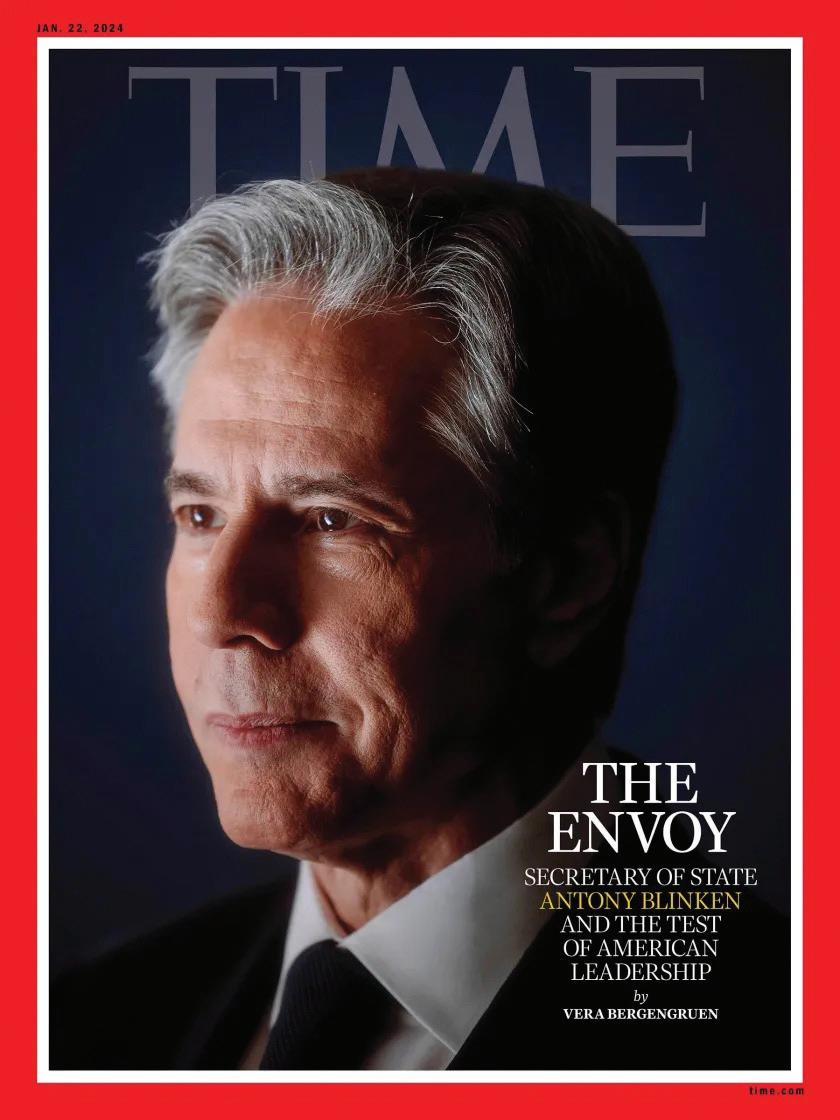
power opponent — Ohio State, Alabama, Washington, others — that lined up against them this season. They were the best on the field. They are worthy champions.
Asterisks are so often overrated. That’s because in recent sports history, teams that fans love to hate continued to win after the whiff of scandal has supposedly stained them forever. These teams have pretty much proven that they didn’t need to bend the rules.
Take the New England Patriots, who’ve won six Super Bowls under head coach Bill Belichick, whose future with the franchise remains tenuous after back-to-back losing seasons. “Spygate” erupted during the 2007 season. New England was found to have filmed the New York Jets’ signals during a game in September: Belichick was fined $500, the Pats were docked $250,000, and the team lost its 2008 first-round draft pick. But New England finished the regular season undefeated anyway, becoming just the second team in NFL history to do so. Although the New York Giants upset New England in that season’s Super Bowl, the Patriots would win three more titles after Spygate and 2015’s Deflategate, in which New England was found to have used underinflated footballs during the AFC Championship game against the Indianapolis Colts. Whenever Belichick retires, Spygate will be mentioned, no doubt. But he’ll still go down as arguably the greatest coach in NFL history. Tom Brady served a four-game suspension for Deflategate. He’s still universally regarded as the GOAT. …

NEWSWEEK • FEB. 6, 2024 • BY
SUZANNE BLAKEOne woman was able to clear $155,000 in student loan debt after filing for Chapter 13 bankruptcy, and she’s now spreading the message that it’s possible for other borrowers as well.
Under President Joe Biden’s updated student debt forgiveness plan, previous rules that made filing for bankruptcy to erase student loan debt more di cult have been upended.
Alrena Dale, a 60-year-old customer service representative living in Flint saw her student loan debt skyrocket to $155,000 after earning two associates, a bachelor’s, and a master’s degree.
While she claims her college, the online University of Phoenix, promised their degrees would help adult workers in their search for high-salary jobs after graduation, she was never able to find one that made paying o her student debt feasible.
At the time she decided to earn a bachelor’s and master’s in organizational business management, Dale was a single parent looking to make a better life for her son.
“They were encouraging us to recruit others because they could guarantee us all good-paying jobs when we graduated, $50,000 and above,” Dale told Newsweek “That was a fantasy that they promised us all.”
Newsweek has contacted the University of Phoenix via email for comment on Dale’s claim.
While Dale doesn’t regret her education, she said what she perceived as the promise of that high-paying job never panned out, even after she forked over additional money for a master’s degree.
“I wasn’t really worried about it,” Dale said. “When I realized it was getting out of control is when I graduated with my master’s and I realized that they weren’t holding their end of the bargain.”
Four years ago, Dale’s student debt had soared to $155,000, but that wasn’t why she looked into filing for
bankruptcy.
Instead, Dale found herself in financial straits after struggling to maintain a steady job after purchasing a new car. Dale was scared she would end up losing her car, but she had no idea her student loan debt could be cleared through the bankruptcy process.
Her lawyer at the Robert Branson Law Firm in Orlando, Fla., told her she’d look into the possibility but there were no promises. Still, Dale had hope that maybe she wouldn’t die with the thousands of dollars in debt to her name.
“I said, ‘Lord, I don’t want to go to my grave on $155,000,’ ” Dale said. “I knew that I couldn’t pay that back, especially not having a good job. Right now, I live paycheck to paycheck. Most Americans do.”
The entire process took roughly nine months, and then Dale saw her student debt completely erased. Dale said her life today is significantly di erent than if she was still in debt. ...
THE WALL STREET JOURNAL JAN. 15, 2024
BY NORA ECKERTAutomakers are looking to an old friend to help o set rising labor costs: robots.
For decades, car companies have increased automation inside their factories. Now, auto executives are looking more closely at this approach, to address a rising labor bill and take advantage of more sophisticated technology.
Competition from relative newcomers like Tesla,
which has been more aggressive in deploying this factory technology, is also nudging more traditional auto manufacturers in this direction.
On a recent investor call, Ford finance chief John Lawler pointed to “opportunities in automation” when asked about how the company plans to cover the cost of its new labor contract. He also cited other possible o sets, such as reducing the complexity of Ford’s vehicles.
While automakers have been moving to automation for some time, rising labor costs are poised to accelerate the adoption of such technologies, said Laurie Harbour, president of Michigan manufacturing consulting firm Harbour Results. “Automation is the future. More so than we’ve ever seen,” she said.
United Auto Workers members approved a labor contract in late 2023 with Ford, General Motors and Jeep maker Stellantis that included a record 25 percent wage increase over four years and marked the sharpest labor-cost increase for the companies in recent memory.
The e ect from the deals in Detroit quickly rippled through the industry, with Toyota Motor, Hyundai Motor and other nonunionized automakers increasing wages to stay competitive.
Detroit executives have said the contracts were richer than they had planned for, and they are strategizing ways to blunt the increased costs. Ford said the new terms would add about $900 in cost per vehicle by the time the contract expires in early 2028. GM executives pegged the hit from richer labor contracts during that
period at roughly $500 a vehicle.
A spokesman for GM said the company will continue to use technology to help its team members increase productivity and make work environments safer. Stellantis, Ford and the UAW declined to comment. …
ROAD & TRACK • JAN. 31, 2024 • BY FRED SMITH
Michael Andretti has been openly seeking a spot on the Formula 1 grid since he attempted to acquire a team in 2021. That eventually ballooned into a major partnership with General Motors and a sta that had already begun development on a race car for 2025, but Formula One Management announced today that the group’s bid for a spot on the 2025 and 2026 grids has been rejected. That is the end of the bid as we know it, but a statement from Andretti Cadillac suggests that the partnership has not given up on its fight to make the F1 grid yet.
In the statement, the joint venture notes that “Andretti Cadillac has reviewed the information Formula One Management Limited has shared and strongly disagree with its contents. Andretti and Cadillac are two successful global motorsports organizations committed to placing a genuine American works team in F1, competing alongside the world’s best. We are proud of the significant progress we have already made on developing a highly competitive car and power unit with an experienced team behind it, and our work continues at pace.”
The statement suggests that Andretti and GM have not necessarily given up on racing in F1 in 2025, let alone in the near future. The avenues that the team would have to race in the next few years are unclear, but the FOM announcement did leave the door open for a new application with a complete GM power unit in 2028. …
Notably, the section of the announcement that suggested GM apply again in 2028 did not mention the Andretti team that filed this application. Michael Andretti’s team has won four IndyCar championships, six Indianapolis 500s, and one title in Formula E, but the oddly insulting FOM statement suggested that the team would not have been able to produce a competitive Formula 1 car. …








Opening an office in Royal Oak, Sabio Holdings Inc. works to drive sales in the digital age.
BY R.J. KINGA25-year veteran in media and advertising, Aziz Rahimtoola, co-founder and CEO of Sabio Holdings Inc., believes he and his 130-member team have developed the secret sauce to reach the holy grail of advertisers: diverse audiences.
Whether Hispanic, Latino, Asian, or African-American, Sabio (Spanish for wise or experienced) offers clients including Rocket Mortgage, General Motors Co., and Ford Motor Co. a way to reach different audiences via targeted advertising that includes mobile apps and streaming TV content.
Based in Los Angeles, Sabio Holdings recently opened an office in downtown Royal Oak as a way to better serve an array of local clients in sectors such as automotive, retail, quick-service restaurants, and consumer products.
Residences at Water Square
Opens Along Riverfront
Residences at Water Square, a 25-story riverfront development that occupies the site of the former Joe Louis Arena in downtown Detroit, has opened. The 496-apartment community is Detroit’s first all-glass residential high-rise building.
Dawn Foods Acquires Baking Netherlands Ingredient Maker
Dawn Foods in Jackson has acquired Royal Steensma, a family-owned bakery ingredients manufacturing company in Leeuwarden, The Netherlands. The company specializes in candied fruits and decorations, and other products.
Aziz Rahimtoola, co-founder and CEO of Sabio Holdings Inc. in Los Angeles, recently opened an office in downtown Royal Oak to better serve local clients like Rocket Mortgage, General Motors Co., and Ford Motor Co.
“We supply targeted advertising content on such channels as Roko, and from the feedback we receive, we supply our clients with very specific information on what potential buyers are motivated by and what they’re looking for in a specific product or a service,” Rahimtoola says. “There are lots of data points to understand.”
With a portfolio of companies in the streaming TV ad industry, the company provides its clients with advertising solutions, advanced audience analytics, and content monetization.
The Sabio Holdings portfolio is comprised of Sabio, a content monetization DSP (Demand Side Platform); App Science, a real-time measurement and attribution SAAS (Software as a Service) platform; and Vidillion, a cloud-based ad-insertion, content distribution, and management platform.
Having launched several startups in the media production and global trade space as well as holding leadership roles at NBC Universal and AT&T Adworks, Rahimtoola says Sabio Holdings, which is listed on the Toronto Stock Exchange, will grow by adding more data science offerings and proprietary software engineering processes.
“We hire quite a few recruits from the University of Michigan, and we see metro Detroit as a hotbed for innovation and smart technology,” Rahimtoola says. “This year we plan to introduce Sabio TV to further help brands reach diverse audiences, as well as enhance our ability to drill down to the factors that motivate buyers to make a purchase.”
For example, when buying a new car, truck, or SUV, a Hispanic buyer often prefers different colors, styling, and features than someone from Asia or the Middle East.
“If you can highlight certain attributes unique to specific customers, it’s a whole lot better than providing a one-size-fits-all advertising campaign,” Rahimtoola notes.
“In the past, global advertisers would target specific ads to, say, Hispanic magazines, newspapers, radio, and television, but it was expensive and there was literally little to no feedback. In the digital age, not only can we target specific audiences, but we also get feedback. It’s our job to take that feedback and act on it to drive more sales and brand loyalty for our clients.”
General Motors Provides More OnStar Features as Standard General Motors Co. is making some of OnStar’s technology more accessible to its customers. Starting with the 2025 model year, every customer who buys a new vehicle will get Automatic Crash Response and other features.
BAE Systems Delivers New Test Vehicle to U.S. Marine Corps
BAE Systems Inc. in Sterling Heights has delivered the first production representative test vehicle of the new Amphibious Combat Vehicle 30mm Cannon variant to the U.S. Marine Corps for testing.
Report: Detroit Employment to Hit Pre-pandemic Levels in 2028
Detroit may experience falling unemployment, rising wages, and an expanding labor force by 2028 despite a slowing national economy, according to the Detroit Economic Outlook 2023-2028, produced by the University of Michigan.
Technologies Inc. (ASX) in Detroit announced at the 2024 CES show in Las Vegas it has signed an Other Transaction Prototype (OTP) contract agreement with AFWERX (U.S. Air Force Work Project) Agility Prime.
The agreement is focused on uncrewed aircraft systems to address the most pressing challenges in the Department of the Air Force (DAF).
ASX designs and builds electric vertical take-off and landing (eVTOL) aircraft at the Coleman A. Young International Airport in Detroit. The company’s eVTOL SIGMA-6 was designed to offer the capability to connect logistics operations internationally, as well as take commuters out of traffic and into the air.
Under the authority of 10 U.S.C. 4022, the Agility Prime office of the U.S. Air Force’s vertical lift program is pursuing prototype projects from nontraditional and traditional defense contractors. The projects are meant to help the government assess the transformative vertical flight market and vertical take-off and landing (VTOL) technologies.
The move also seeks to establish a collaborative strategy with industry and investors that accelerates fielding the most promising dual use technologies that implement savings and utility for government and civilian commercial markets. —
Jim StickfordChris Kushmaul, owner of Restoration of Western Wayne County and Restoration 1 of Metro Detroit, went into the disaster cleanup business because he wanted to continue providing service to others, not unlike his experience in the U.S. Army.
“It really came down to finding a business that I thought I could make a difference with,” Kushmaul says. “Doing restoration work is a lot like the work we did in the military. You come in in the middle of a crisis, you calm things down, and you help people.”
Kushmaul enlisted in the Army out of high school in 1989 and was recruited during basic training to join the Old Guard, the ceremonial escort to the president. Among the highlights of that service was opening a limousine door for former Soviet President Mikhail Gorbachev and guarding the Tomb of the Unknown Soldier at Arlington National Cemetery when the regular Tomb Guards were attending a holiday party.
“It was the middle of the night, and I was freezing my tail off, but it was an honor,” Kushmaul says of his one-time tomb service.
He left the Army after Operation Desert Storm, went to college at the University of Michigan, joined the ROTC program, and returned to the Army as a commissioned officer, serving in the 82nd Airborne in Kosovo.
Kushmaul currently has six employees, three of whom are veterans. He’s earned U.S. Department of Labor Platinum Awards for hiring vets three years in a row.
“I look to hire veterans every chance I get,” he says. “Anytime I can work with another vet, even (from) other companies, I jump at the chance. There are a couple of plumbing companies I work with (that are) owned by vets.”
His combined operations recorded $1.2 million in revenue in 2023. Restoration 1’s primary focus is water damage mitigation, including mold removal and dealing with the after-effects of fire and smoke damage.
“Anytime there’s a big flood like we had in August, we’ll be working water damage calls for at least 30 days, then it transitions into calls for mold,” he explains.
Three New Single-family Home Communities Coming to Region
M/I Homes Detroit has announced the opening of three new communities in southeast Michigan — Creekside Park in Macomb County, Cobblestone Creek Woodlands in Wayne County, and Heritage Farms in Washtenaw County.
Spalding DeDecker Acquires Landscape Architects
Spalding DeDecker in Rochester Hills, a civil engineering, planning, and surveying firm, acquired Landscape Architects & Planners Inc. in Lansing as part of Spalding’s plan to expand its service offerings and capabilities.
Stellantis Buys AI Tech to Advance SmartCockpit
Stellantis has acquired the AI framework, machine learning models, intellectual property rights, and patents of CloudMade, a developer of data-driven solutions to support develpment of the STLA SmartCockpit.
Among some of the company’s major projects have been post-fire work at a Walgreens in Southfield and a CVS in Detroit. Kushmaul’s team also performed numerous COVID-19 cleanings during the pandemic.
ON GUARD U.S. Army veteran Chris Kushmaul has opened two area businesses that restore damaged properties.
“It’s rewarding work,” Kushmaul says. “The homeowner or business owner doesn’t know who to turn to or what to do next, and we’ve got the experience to coach them through all of the processes.”

GM-Honda Project Producing Fuel Cells in Brownstown Twp.
General Motors Co. and Honda have started production of hydrogen fuel cell systems at their 50-50 joint venture production facility, FCSM, in Brownstown Township. The 70,000-square-foot site already has created 80 jobs.
The U.S. Army has extended its relationship with the University of Michigan’s Automotive Research Center with a five-year agreement to provide funding of up to $100 million to boost work on autonomous vehicle technologies.
For full stories and more, visit dbusiness.com/daily-news to get daily news sent directly to your email.
With the recent union strike settled, how will Detroit’s three casinos perform?
BY DAN CALABRESEWhile the three Detroit casinos have dealt with challenges in recent years from the spread of online gaming and increasingly ubiquitous sports betting, they faced a more internal challenge late in 2023.
When nearly 2,000 employees of the three casinos walked out on strike on Oct. 17 — demanding reduced workloads, wage increases, and the elimination of higher health care costs — the leadership of MGM Grand Detroit, MotorCity Casino, and Hollywood Casino at Greektown had to make adjustments to maintain operations and preserve revenue.
The workers who walked out included dealers, valets, and cleaning crews.
Since the 47-day strike ended in early December, with workers receiving an 18 percent pay raise and the concessions they sought on workloads and health care costs, casino operators and industry observers say there’s no evidence yet that the casinos lost significant numbers of customers because of the strike.
“There’s always an issue of loyalty,” says Jacob Miklojcik, president of Michigan Consultants in Lansing, which works with casinos. “If you lose someone, who’s going to pick them up? If there had been a closure, you might have seen people go to a casino in Mount Pleasant or Battle Creek, and they might have liked it better there. But I haven’t seen that.”
Total adjusted receipts for all three casinos in December were $111.4 million, which represented a massive jump from the strike-impacted month of November, when the casinos pulled in $76 million. By contrast, the equivalent numbers in 2022
 BILL WILD
President and CEO
BILL WILD
President and CEO
MGM Grand Detroit, Hollywood Casino at
Casino
are poised to make revenue gains now that a union strike in late 2023 has been settled.

showed the casinos were at $99.9 million in November and $108.3 million in December.
“In December, since there was pent-up demand, it was up from the year before,” Miklojcik says.
MGM Grand’s November revenue dropped more than 33 percent in 2023 compared with 2022, while MotorCity’s revenue fell roughly 20 percent and Hollywood declined by 15 percent. Nevertheless, all three casinos finished the year in solid shape, considering the greater impact the strike could have had.
“Closing 2023 on such a high note speaks to how our team members always come together to provide the best-in-class service and entertainment the city of Detroit and southeast Michigan have come to expect from us,” says Matt Buckley, president and COO, Midwest Group, for MGM Resorts International.
Now that the strike is over, the casinos can better
DB: WHERE ARE YOU?
BW: I’m in Cleveland with the Midwest Independent Retailers Association, which is affiliated with the Michigan Independent Retailers Association.
DB: WHAT’S GOING ON?
BW: I’m learning about some of the local issues that have popped up in Ohio, such as the potential ban by some local communities of different
products our members sell. We understand any concerns, but we’d like to have them addressed at the state level so everyone’s on board.
DB: WHAT’S NEW IN MICHIGAN?
BW: Our organization was founded in 1910, (and today) we have more than 1,200 members. We’re the voice of the food, beverage, and petroleum industries — so (we work with) retailers, suppliers, and vendors. We have a full-time government affairs office, and we represent legislative issues in Michigan, Ohio, and Illinois. We also interact with government agencies, and we offer our members a suite of services such as discount programs and group rates for insurance, workers’ comp, and payroll.
re-evaluate their relationship with sports betting. Retail sports betting revenue was down considerably in 2023, with the three casinos bringing in a total of $13.9 million, compared with $18.8 million in 2022.
While high-tech sports bars are designed to attract bettors, the online growth of sports is causing the casinos to elevate their on-site experiences.
At the same time, all three casinos work with online betting platforms. Hollywood’s partner is Barstool Sports, while MotorCity works with FanDuel and MGM Grand keeps it in-house with BetMGM.
“I was a big proponent of sports bars before mobile betting, because that brought new people into the casinos, and spouses and friends who didn’t want to bet on sports could play slots or whatever,” Miklojcik says. “Well, guess what? Now it’s probably easier to make a bet online or go to a kiosk.”
DB: WHAT ISSUES ARE BEING ADDRESSED?
BW: There’s a fairly new business called Gopuff that provides a platform where people can order liquor online and have it delivered to their home by a vehicle delivery company. We’re addressing that as it relates to Michigan’s liquor laws.
DB: WHAT ELSE IS GOING ON?
BW: We’re working on
increasing the discount retailers receive for purchasing liquor, increasing the commissions on lottery sales, and looking at the bottle return program. It was originally developed some 50 years ago to clean up highways and reduce litter, but with the returns, it can be a messy operation when a store is selling food and beverages. — R.J. King


A new brasserie in the Book Tower in downtown Detroit embraces the city’s French roots.
BY R.J. KINGWhile the historic Book Tower in downtown Detroit has been vacant for decades, when it reopened last year following a $400-million restoration by Bedrock Detroit, more than a few guests thought the Parisian-inspired brasserie Le Suprême had been there for years.
“There’s no greater compliment than creating an authentic space,” says Randall T. Cook, co-founder and CEO of Method Co. in Philadelphia, which designed, programmed, and operates all of the restaurant and hospitality spaces in the Book Tower. “Because our guests think the restaurant has been there a long time, our team did its job.”
If Le Suprême could be picked up and reset along the Avenue des Champs-Élysées in Paris, it would fit right in. Typical of its French counterparts, Le Suprême — which serves dinner along with a weekend brunch — features brass, colorful tile patterns, wood floors and trim, stained glass, and high ceilings. It also embraces the Art Deco style long favored in Detroit, which was founded by French settlers in 1701.
As part of the first-floor space along Washington Boulevard, the brasserie, complete with handpainted lettering on the windows, offers a 24-person private room, a wine room, and a pastry kitchen that fronts the Book Tower’s grand, three-story lobby. As a natural extension, Le Suprême provides shareable fare in the lobby, in an area called Bar Rotunda.

“We got involved with Bedrock early on in the Book Tower restoration by bringing in (the 117room) ROOST Apartment Hotel,” Cook says. “From there, we asked Bedrock what they were doing with their retail spaces, and we put a deal together. One goal we had was to make all of the restaurant spaces appear as original to the building (it was opened in 1926 by J. Burgess Jr., Herbert, and Frank Book).”
Along with Le Suprême, Method Co. operates Kamper’s, named for Louis Kamper, the architect who designed the 38-story tower and neighboring 13-story Book Building. The indoor/outdoor cocktail lounge, set on the roof of the Book Building, offers sweeping views of the downtown skyline.
In addition, there’s Sakazuki, a casual sake and sando pub on the first floor, and Hiroki-San, offering izakaya and omakase-style dining just below. For larger events, the Conservatory Ballroom on the 13th floor of the Book Building, which features a stainedglass roof, includes an open-air rooftop bar, a private suite, and room for 225 seated guests or 300 people for a strolling reception.
“While we have hotels and restaurants in multiple cities, we hire local people for each establishment because we feel they know the given area and there’s better synergy,” Cook says. “It also helps limit turnover. That’s been a key to meeting our growth plans. We ended 2023 with 625 employees, and we plan to have 1,000 employees by the end of 2024.”
HOMEOWNERS ARE looking to utilize their outdoor spaces for multiple purposes and in all kinds of weather, according to a new report from Deckorators, a Grand Rapids-based outdoor products provider.
The report focuses on what homeowners favor about their outdoor spaces, including functional design and regional color trends.
Highlights from the 2024 Outdoor Living Report include:
• Functional design: Flexible-use zones throughout decks are becoming a design standard.
• Cocktail rails: This signifies a shift away from the structured dining table.
• Monochrome moment: Deck colors are becoming more minimalistic.
• Privacy walls and shade structures: Offer seclusion as well as protection from the elements.
• Heaters and fire features: Homeowners are challenging the seasonality of their outdoor spaces by including heated elements.
• Dock upgrades: Waterfront spaces are evolving to include multiple fountains.
• Outdoor kitchens: Homeowners are treating outdoor kitchens as places for both cooking and camaraderie.
• Design: Overall, homeowners are showing more interest in being involved with a designer.
“Our experts are seeing homeowners prioritize a balance of form and function,” says Michelle Hendricks, category marketing manager for Deckorators. “It’s all about creating a flexible-use space full of elements that enhance the enjoyment of the outdoor experience.”
Jim StickfordRandall T. Cook, co-founder and CEO of Method Co., says his ability to both create and manage one-of-a-kind hotels and restaurants has brought greater continuity in design, construction, and operations.




Hustle and Muscle is a free program connecting entrepreneurs with investors in Michigan.











CONNECTING STARTUPS WITH INVESTORS
DBusiness invites startups seeking capital to fill out a profile. From there, the profile will be reviewed, and, once approved, it will be sent to investors with a short summary and a profile link. If investors would like to learn more, they can connect directly with the startup via the information provided in the profile.

Our goal with Hustle and Muscle is to assist startups and accelerate economic activity throughout Michigan. All we ask is that the information provided be accurate. In the near future, we’ll provide editorial coverage of select deals once they’re finalized. Scan to fill out our online form.

































What it takes for a company to last 100 years or more: talent, drive, ambition, continuity, and, at times, good luck.BY RONALD AHRENS
Starting as a general contractor in Detroit, Barton Malow became a pre-eminent builder of large-scale industrial, commercial, and institutional structures across North America.
The rst, failed attempt to implode the Pontiac Silverdome on Dec. 3, 2017, produced little but smoke and dust at the demolition site — but there was plenty of mirth in the South eld headquarters of Barton Malow Co.
Completed 42 years earlier, the Silverdome was Barton Malow’s rst foray into stadium construction. With incentives and penalties to guarantee performance, the contract was a risky undertaking.
“ e Silverdome was noteworthy because it was one of the rst stadiums in years, if not decades, that had been done on time and within budget,” says Ryan Maibach, president and CEO of Barton Malow.
Moving from that “tremendous success,” the company followed up with domes in Minneapolis and Atlanta. en, in 1992, came Oriole Park at Camden Yards. is new home of the Baltimore Orioles Major League Baseball franchise set an example of adaptive reuse by incorporating existing buildings, thereby creating a new standard for urban stadiums. An award-winning example of the same principle followed 12 years later with the completion of the renovated Soldier Field in Chicago.
“Today, a continued trend is how to meaningfully incorporate technology and experiences into stadiums,” Maibach says. “Stadiums are coming up with creative ways to enhance the fan experience.”
Barton Malow recorded $4.8 billion in revenue in 2022 and has 3,500 employees, including trades and professional sta . Located for years at 2631 Woodward Ave., the company moved to South eld in 1986 and built an elegant four-story headquarters there in 2001. ey also operate a storage yard in Oak Park.
e company’s other o ces are in eight states and Ontario, Canada. Its ongoing projects in Michigan include the Hudson’s tower and neighboring mid-rise in downtown Detroit, the Ford HUB in Dearborn, and General Motors’ Ultium Cells Lansing battery plant, known as Ultium 3.
About half of Barton Malow’s business is in industrial and manufacturing facilities, and the other half is commercial and institutional work. e
Barton Malow Family of Companies includes Barton Malow Co., Barton Malow Builders, and Barton Malow Holdings. Subsidiaries are LIFTbuild, an innovative system for building multi-level structures; Alltrade Industrial Contractors Inc., a specialized contracting subsidiary; and Flypaper Technologies, a construction software enterprise.
Starting as the C.O. Barton Co. in Detroit in 1924, the general contractor’s rst job was making interior
renovations for Michigan Bell Telephone Co. Ryan Maibach’s great-grandfather, Ben Sr., joined the company as a carpenter the next year, and in 1927 Arnold Malow became vice president and treasurer.
e company’s name changed to Barton Malow in 1932. Ben Maibach Jr. joined in 1938 and was appointed president in 1960. Ben III, Ryan’s father, was from a family of eight children, seven of whom worked for the company. Ben III became president in 1981. Ryan, who earned a degree in construction management from Purdue University, joined in 1997; he became president and CEO in 2011.
Among the company’s notable projects are the massive United States Post O ce in Detroit, built in 1959, and the 27-story Je erson Apartment Building, the state’s tallest reinforced-concrete structure, which opened in 1962. Besides its prodigious building accomplishments, Barton Malow also distinguished itself as a progressive employer, introducing employee pro t-sharing and a pension plan in 1952. Two years later the Barton Malow Foundation was launched, with the goal of donating 5 percent of earnings to community causes.












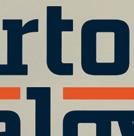












“One of the most impactful things was to broaden it (so that) the whole organization could participate in supporting charities,” says COO Chuck Binkowski, who started with Barton Malow as a laborer 42 years ago. A program of matching grants was established so employees could pick their own charities. “If I wanted to give, the foundation would match my giving,” he notes.
Binkowski’s father worked for the company for more than 40 years, his own two brothers have worked there, and his son is at the Hudson’s site. “When you can have multiple families that have had two, three, four generations of builders that come up through the company, you don’t want to take that for granted,” he says.
To keep from getting stagnant, Maibach says the company’s analysis over the last decade led executives to ask, “What ways are we pushing ourselves to think di erently about how we do what we do in order to ensure our long-term relevance?”
One example of pushing the boundaries of
construction is the company’s investment in LIFTbuild technology, where modules, or whole oors, are built o -site. When the units are completed, they’re shipped to the job site and ratcheted into position, starting at the top. e concept was rst used in Detroit for the 15-story Exchange building near Greektown.
“It’s our hope and intention that you’ll be seeing more of LIFTbuild,” Maibach says. “It really proves itself out. It’s more cost-e ective and signi cantly reduces the time it takes to build multistory buildings.”
As an analogy, Maibach points to the racing teams elded by Detroit’s auto manufacturers. “ ey race because it really pushes the envelope of mechanical engineering. For us, LIFTbuild is that racing team, that innovation engine that’s helping us nd ways to build all that we do better.”
FLOOR PLANThe Huron River Club in Farmington remains an endearingly rustic dining club and social retreat, while adding new twists for its members.
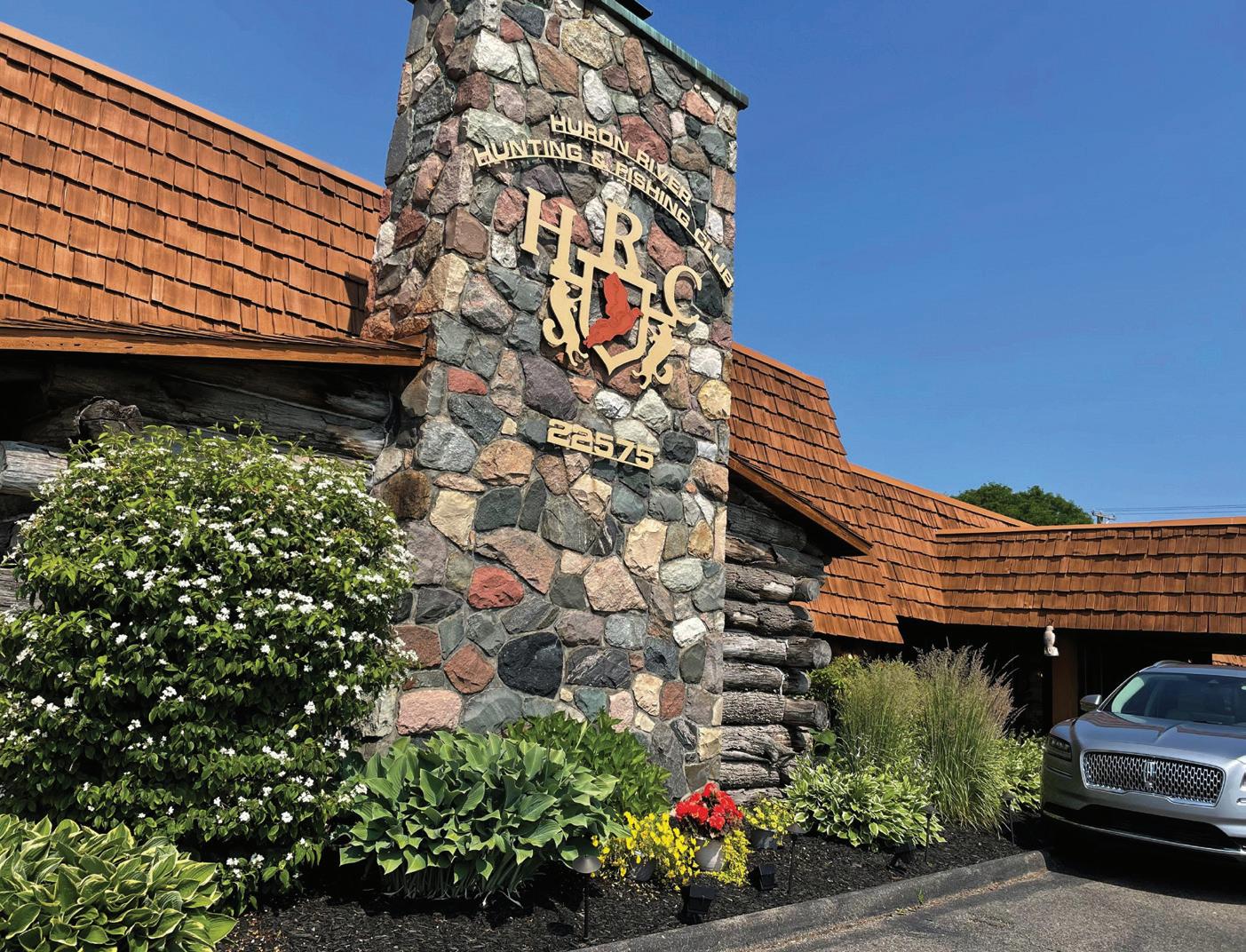
Laura Fox hears it all the time on the phone. “Is this the Hunt and Grunt Club? I haven’t been there for a long time, but it says Huron River Club.”
“Yes,” Fox admits, “it is, but that’s a slang name that developed on the street. If you’re going to look us up on Google Maps when you’re trying to get here, it’s the Huron River Club.”
Fox came from the restaurant world where patrons would say, “Cash us out, we’re going to the Hunt and Grunt.” She says it was “the endearing name for this place because you were going to get overserved in food. It was the Hunt and Grunt because the portions were so large.”
Fox is in her 19th season as general manager of the dining and social club that sits on a quarter-acre at 22575 Farmington Rd. in Farmington Hills. Founded by Eugene and Rhoda Rennard on June 14, 1923, as the Huron River Hunting & Fishing Club, it first occupied a two-story cabin on a 153-acre riverside site in Livingston County’s Green Oak Township. In 1934, the club moved to Farmington Road and the Grand River cutoff, as the location was described in those days. The new quarters were a similar cabin-style clubhouse of logs harvested on-site and towed into place behind the Rennards’ Cadillac.
That building was eventually condemned and then replaced, in 1971, by architect John Allen’s discreet,
The Huron River Club opened in 1923, and in the early days members hunted and fished. Today, the club, located in Farmington, offers multiple activities and private dining experiences.
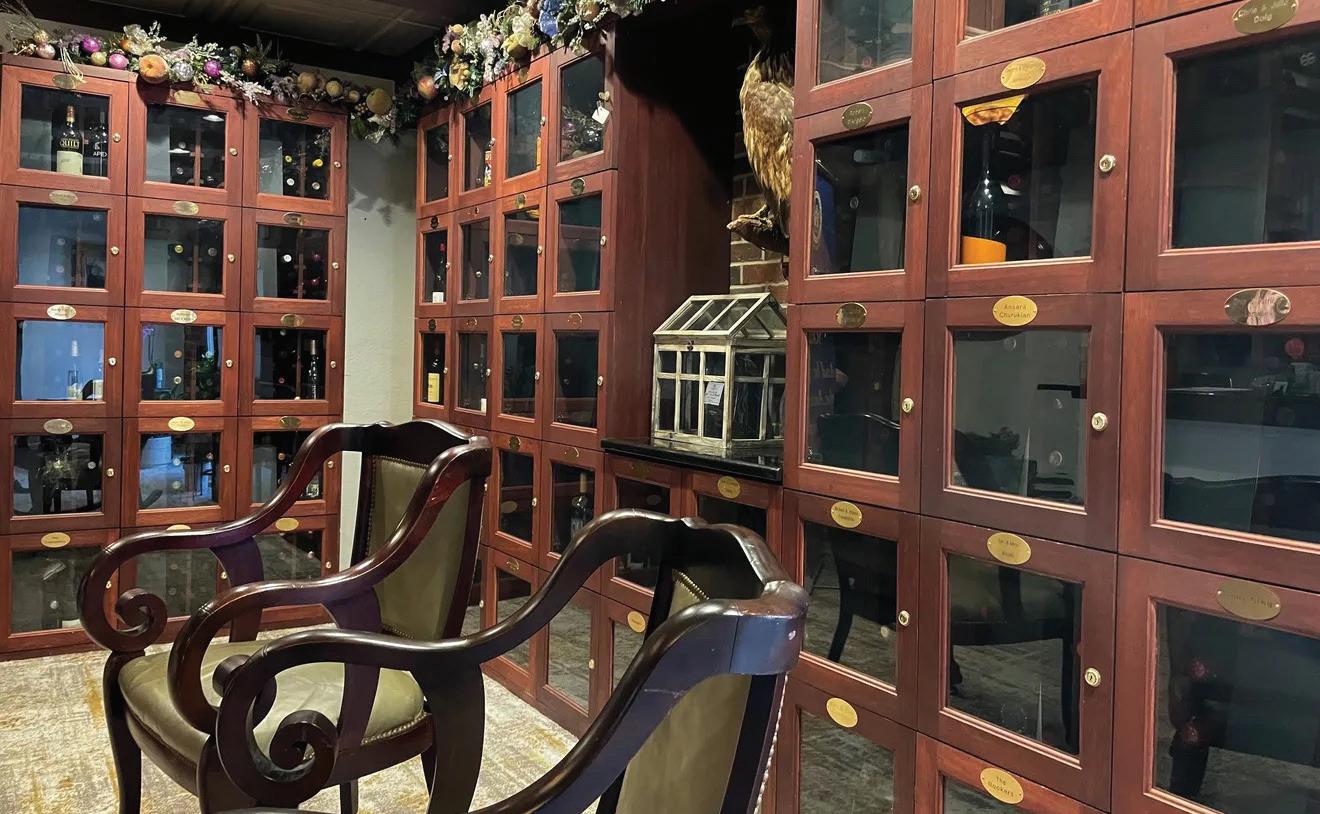
The “wow factor” — enhanced by the big-game taxidermic specimens throughout the lodge — extends to members’ friends and clients who request the club as a primary destination after landing at Detroit Metropolitan Airport. “The Asian population loves our beef, and they want the largest steak we have. They can’t wait to eat it because they don’t have that available to them in their countries.”

low-profile lodge of logs cloaked in wooden shakes and adorned with stone. Subsequent additions followed, the last being in 2000.
Today, the Huron River Club has 26 employees who provide dinner from Tuesday through Saturday evenings and lunch on Thursday and Friday from September through May. The roster of 475 members is divided among three service levels: Regular, Intermediate, and Corporate. Regular memberships come at a one-time initiation fee of $1,500, with annual dues of $900 and a food and beverage minimum.
A look at a 1943 menu shows that a large porterhouse steak for two was $3.75, and pie was 20 cents. By 1994, an entrée of rack of lamb was $34 and surf and turf was $57.70. These days in the premium 150-seat Fireside Room, a 26-ounce portion of steamed king crab legs is $160, a two-pound portion of rack of lamb is $145, and the 32-ounce king sirloin is $92.
“When this food comes out, people just look,” Fox says. “It’s amazing, with large portions of food. It’s presented beautifully; we do a wonderful job. Your food comes hot to your table, not lukewarm.”
A significant moment in club history was the birth of an annual car show about 35 years ago. Held on the first Tuesday in June, it gave members such as the late Richard and Linda Kughn a chance to display prized trophies from their vast collection, such as the 1948 Lincoln Continental Cabriolet the couple showed in 2015.
Another major event is the annual summertime cigar dinner, held outside for the last 25 years, for which Fox flies in a “real deal” Cuban Canadian cigar-roller. A Labor Day clambake finishes off the summer season.
Indoor events of note are the Halloween and Christmas luncheon celebrations for kids, which include meticulously organized crafts programs, a magician who visits every table, and a photographer who captures special moments. “Next thing you know it’s two o’clock, time to go, and we have to clean it all up,” Fox says. Easter and Mother’s Day brunches also are featured.
Besides the Fireside Room, a second dining room is called the Hunt Room. The menu in this informal, 100seat space offers lighter, less-expensive fare. Fox characterizes it as an innovation. “If you say, ‘Well, I don’t want this big food that you offer — we don’t eat like that,’ then enjoy the Hunt Room menu.” It helps in retaining younger members, who can still meet their F&B minimums this way.
With a 14-seat table, the elegant Rennard Room is suitable for business occasions and offers the Fireside Room and Hunt Room menus.
Rhoda Rennard served on the club’s board until April 22, 1946 — longer than any of the other founders. Her husband died in 1961, and she followed him 12 years later. To this day, though, the Huron River Club is imbued with their spirits and the commitment to quality and conviviality they originated.
Through every large natural and man-made disaster, Globe Midwest Adjusters International in Southfield has refined its advocacy on behalf of insurance policyholders.


Sometimes the value of an insurance claim can come down to an elusive distinction such as whether a damaged piano remains good enough to play at home but is no longer up to a Brahms concerto in Orchestra Hall. So the Detroit Symphony Orchestra discovered after a ood in June of 2021 a ected the Peter D. and Julie F. Cummings Cube performance space, o ces, dressing rooms, a warm-up area, and instrument storage space.
“We knew right away how complicated the claim was going to be,” Linda Lutz, vice president and chief nancial and administrative o cer of the DSO, said in a statement. “It would be a building claim, an instrument claim, and a lost-income claim.”
e DSO consulted Globe Midwest Adjusters International in South eld, a public adjuster that works with claimants to establish a more favorable settlement with the insurer. e company was founded by Abe Mackey as Midwest Fire Adjusters Co. in Detroit in 1924.
Mackey’s daughter, Shirley, married David Gross in the late 1930s, and Gross joined the business. After World War II, Mackey teamed up with Morrie Levin until Levin started his own company, Globe Fire Adjusters. Mackey and Levin worked out a merger to form Globe Midwest. Meanwhile, David Gross’ son, Allen, had joined the business, as had Levin’s son, Bobby. e company grew and prospered through these family lines, which retain ownership and manage operations today.
Today, GMAI, as its known, has o ces in Southeld, Grand Rapids, Chicago, and Appleton, Wis. e sta of about 60 people includes adjusters who specialize in content evaluation and building estimating,
as well as a forensic accounting team that works on loss-of-income claims. ere’s also a back-o ce sta , and 10 people who work in sales and marketing. Compensation for the company’s services comes from a fee that’s capped at 10 percent of the settlement.
“For us, we’re not a volume shop. We’re not trying to handle as many claims as we can,” explains Ethan A. Gross, CEO of GMAI and the son of the late Allen Gross. “We typically only handle large claims.”
An industrial or commercial facility that’s hit by a re or a storm is a typical case. Besides damage to structures, the adjusters look at losses in equipment and stock. With nancial livelihoods at stake and impactful negotiations ahead, clients welcome a personal touch.
“We talk to our clients about what their recovery looks like,” Gross says. “Examining a number of questions is part of the process. For example: What’s best for the business now? Would rebuilding be done here or elsewhere? How about changing the plant’s layout?”
Changes to the playing eld have favored the insurers, Gross says. Deals used to be worked out on cocktail napkins, but those days are gone. e additional technology involved in making assessments can be a double-edged sword. “If I’m not experienced in construction, I could miss a lot of items that add up to millions of dollars,” he notes. “ e computer can’t turn a wrench; you need a real plumber.”
In addition to insurers’ di dence and an unwillingness to look at the big picture, Gross says, “ ey don’t train adjusters like they used to.” Consultants play a bigger part and may be more obsequious to their employers’ expectations.

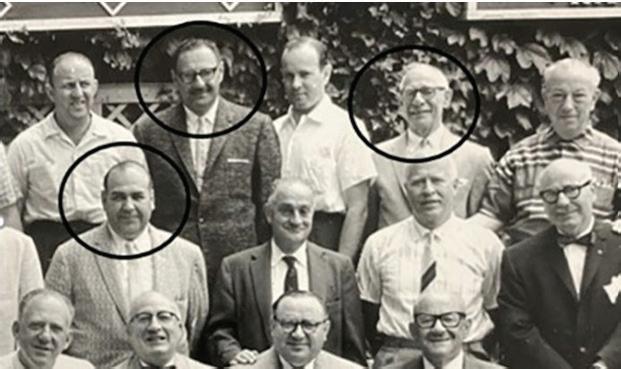
GMAI is one of 8 regional members of Adjusters International Ltd., a collaboration that covers all 50 states as well as territories like Puerto Rico. e member companies operate under guidelines established by the Public Adjuster Licensing Model Act of 2005. e act deals with basic licensing and contract items, but does not have much to do with operations.
One way or other, GMAI has provided its services after most every disaster in the past 100 years. ey represented an Embassy Suites hotel that was adjacent to the World Trade Center in 2001. e “Big Four” hurricanes of 2004 became an epic source of cases. Still, being engrossed with the large claims, GMAI still nds a way to give back.
“In most of the hurricanes and tornadoes, I’ll put on a free seminar on how to handle your own claims. ( e seminars are) designed for homeowners and small business owners, because we can’t handle all those claims,” Gross says. “We don’t have the capacity.”
He addresses real estate professionals, accountants, insurance agents, and attorneys. e seminars provide continuing education credits for the professionals while also executing a marketing function for GMAI. “Most people haven’t heard of our business. It takes a minute for them to understand what our business does.”
With a fth generation now represented in the company, GMAI is poised for the future. “You’re either growing or going backward,” Gross says, invoking the precept of adhering to a steady pace. “We strive to provide best-in-class service, which is what got us here.”
From origins in vitamins and surgical supplies for metro Detroit’s practitioners, Ferndale Pharma Group’s reach extends worldwide with medical adhesives, contract manufacturing, skin-care products, and more.
When wild re swept across much of the Greek island of Chios in August of 2012, alarm bells sounded on 8 Mile Road in Ferndale. Flames had destroyed about half the island’s groves of Pistacia lentiscus.
Commonly known as mastic trees, they produce the resin used by Eloquest Healthcare in its most-recognized product, Mastisol Liquid Adhesive. Called the “tears of Chios,” the resin droplets have the European Union’s protected designation-of-origin status, like Champagne or Gruyere, and are irreplaceable.
After the disaster, Chris Stein, today president and COO of Ferndale Pharma Group Inc., journeyed to the island to meet with the growers’ cooperative to help ensure continued supply.
“We went over to talk about that and make sure that doesn’t happen again, and they’ve done a great job,” says Stein, who started at Ferndale Pharma 27 years ago in quality control. He had previously been to Chios to nalize an exclusive distribution agreement. “It’s a cool place to go. You can see the Turkish coast from the island.”
With a campus at 670 to 780 8 Mile Rd., Ferndale Pharma Group is a privately held manufacturer of health care products, including pharmaceuticals. Stein counts 130 employees. e holding company encompasses ve divisions, one of which includes three subsidiaries. Besides Eloquest, there’s Ferndale Healthcare Inc., o ering prescription and over-thecounter products treating a wide variety of medical conditions, while Ferndale Labs & Contract Manufacturing develops and produces pharmaceuticals and engages in warehousing and distribution. ( e company has a warehouse in Warren.)
Biopelle Inc. specializes in OTC skin-care products sold by national chain stores. Ferndale Worldwide includes Ferndale International, a licensing arm for global partners, and it has a majority stake in Ferndale Pharmaceutical Ltd., located in Wetherby, Yorkshire, England — as well as owning Ferndale Laboratories SRL of Siena, Italy.
Marketing approaches vary among the divisions. E-commerce is important for Biopelle, television spots are used for Ferndale Healthcare, and ads in trade journals promote Eloquest. One constant, though, is pressing the esh in person. “We attend a lot of trade shows and maintain relationships with what we call KOLs, or key-opinion-leading physicians, to get recommendations for our products,” Stein explains.





e company was started in 1897 by Johannes Frederick Hartz and operated out of the Hartz Building at 1529 Broadway St. — now home to the Detroit Beer Co., with condos on the upper oors. e J.F. Hartz Co. purveyed vitamins and surgical supplies. Hartz married Gertrude Boynton and they had two children, Albert and Frances.
e parents passed away in the mid1940s, and Albert and Frances assumed control of the company. ey continued to operate under the Hartz name until the early 1950s when Frances, who married the Italian writer and translator Del no Cinelli, set up an independent business in Ferndale, while Albert kept the downtown store. e Cinellis also owned Tenuta di Spannocchia, an estate near Siena, Italy.








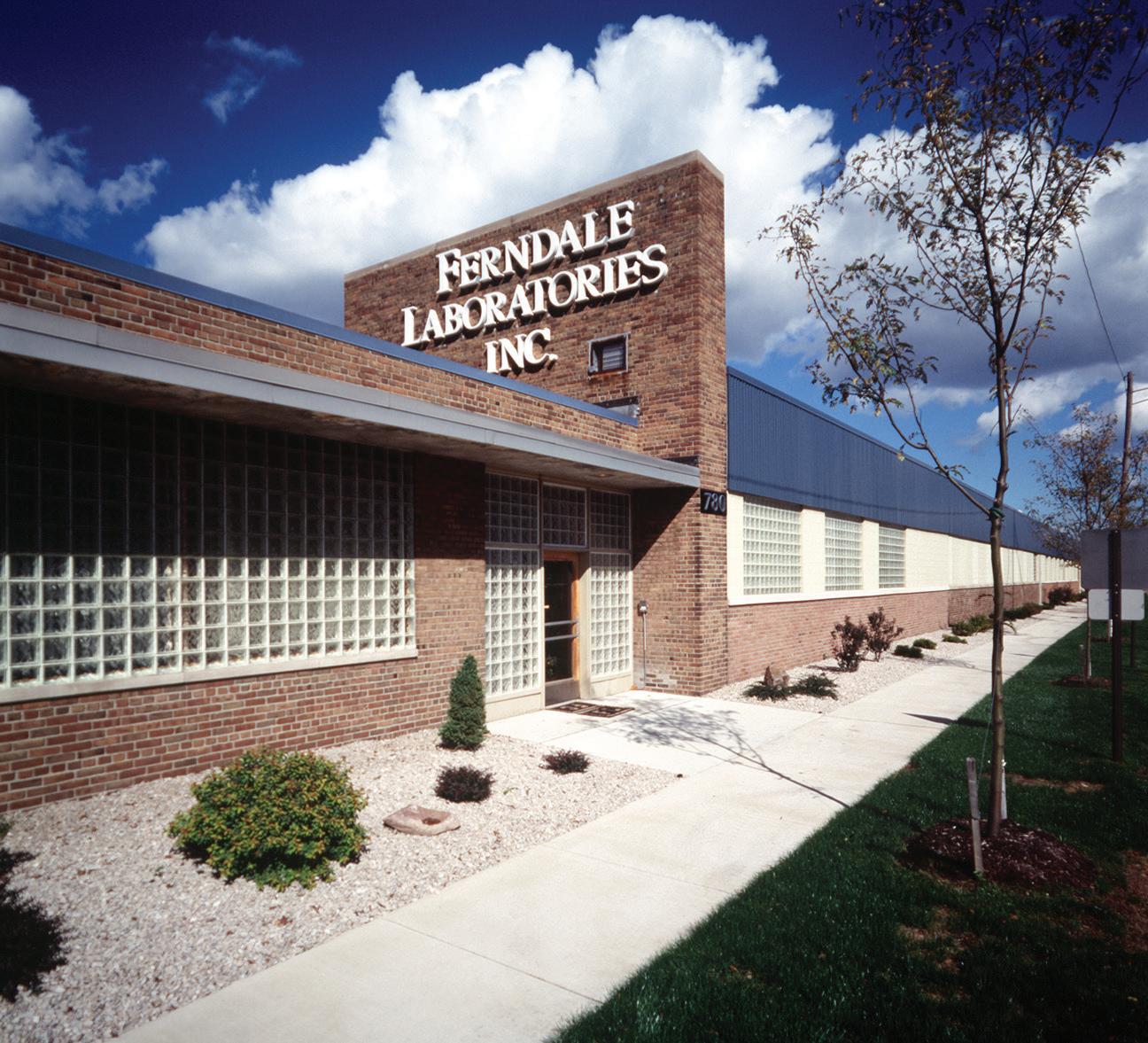
In 1958, Frances changed the name to Ferndale Surgical Inc., which later became Ferndale Laboratories Inc. She and Cinelli had three children, including son Ferdinand (1916-2002), who married Sarah McGraw. Among their four children was Gioconda “Gigi” McMillan, who remains the company’s majority shareholder. She and her husband, James ayer McMillan II, live in Grosse Pointe Farms and Rancho Mirage, Calif., and are benefactors of the Palm Springs Art Museum. Gioconda’s sister, Francesca Stratton, runs the 1,100-acre Spannocchia estate as a working farm and conservation center.
For Ferndale Laboratories, a breakthrough occurred in the 1970s. Growing from a local maker of pharmaceuticals to a national health care company meant establishing a tele-sales force and introducing new products. Mastisol was one. It was rst used for wound-dressing closures. Made nowadays in 1,000-liter batches, it’s also used for securing IV lines, catheters, and ostomy bags. A counterpart product is Detachol, which dissolves the resin for removal of the coverings.
Eventually, an outside sales force was established, growing by the year 2000 to about 60 reps who called on dermatologists and gastroenterologists. But market conditions changed. ird-party payers were becoming more conservative, and generic drugs were readily available.
“We made a strategic decision to start selling o our prescription drug assets,” Stein says. “We did that and went back to the over-the-counter drugs and herbal supplements, and some medical devices.”
e near future requires continued adaptation as brick-and-mortar stores struggle and e-commerce rises. “You don’t need to be an executive in this industry, you just need to be a consumer, to know how easy it is to order something from Amazon” Stein says.
Ferndale Labs & Contract Manufacturing, meanwhile, keeps serving Big Pharma and small startups.
e other divisions will embrace digital advertising and marketing. “Where I see us going is to continue to develop those markets, continue to innovate, to have good products where there’s a great consumer need, and to be able to back that with clinical evidence,”
Stein says.
Ferndale Pharma Group Inc. in Ferndale, which dates back to 1897, today o ers over-the-counter drugs, herbal supplements, and medical devices.Kowalski Sausage Cos. along Holbrook Avenue in Hamtramck has been run by the same family since 1920.
In an early TV commercial for Kowalski Sausage, a father paces back and forth before his family’s home while his son and daughter dget. Emerging from inside, the mother swings a picnic basket.
“You want to eat something?” she asks. “I mean, you want to eat Kowalski hotdogs when we get there?” From there, a voice intones: “Just leave it to the wife to know. And so, a-picnicking we go.” e family rolls away in their 1952 Chevrolet Fleetline sedan. Viewers next see a simmering hotdog on a stick over the grill in a park as Mom reminds viewers, “ ere are 60 delicious products. Remember, the Kowalski label means quality on your eating table.”
In the years from the mid-century to the early 1980s, the phrase “Kowalski Kowality” was coined. It became as indelible as the hotdog-on-a-fork sign at Kowalski Sausage Cos.’ headquarters along Holbrook Avenue. “Kowality” is such a strong signature, it’s even used as the company’s web address: kowality.com.
“We got that before I got here,” says Michael Kowalski, president of Kowalski Sausage. “One word says a lot about who we are and who we want people to think that we are.”
e advertising method has progressed beyond the discursive TV spot of yesteryear. Social media is used to target younger consumers “so that we have potential going forward,” Kowalski says. Constant elements in the messaging are humor and a light thematic touch instead of social relevance. “We’re trying to stay vanilla when it comes to that,” he adds.
With sausage recipes utilizing garlic and smoky avors, the marketing approach may be the company’s only use for vanilla. Tradition adds its own zest, too.
e company started when Agnes and Zygmund Kowalski, immigrants from Poland, opened a grocery store, added a smokehouse, and in 1920 built the Holbrook Avenue sausage factory.
e Kowalskis’ son, Steve, led the company from the 1950s until the 1970s when his own son, Ronald, took over. At age 49, Ronald died suddenly in 1989. Claiming no more than three years of collective experience, his son, Michael, and daughters, Linda Kowalski-Jacob and Audrey Kowalski, assumed control. Audrey left the business in 1994, but Michael and Linda, who is secretary and treasurer, continue to this day.
e 100,000-square-foot factory, which employs 100 workers, also has a parking lot for its eet of 11 trucks; warehouse space is nearby. Home Style Foods, a 2002 acquisition, lies 1.2 miles away on Edwin Street.
Here, in about 50,000 square feet, some 35 workers make potato salad, coleslaw, and dips. Together with Consumer Guild Foods of Toledo, where seven

workers produce dressings, and with specialty subsidiaries Tasso Cuisine (twice-baked potatoes) and Dudek Foods (pierogis), Kowalski Sausage Cos. almost lls the deli case. e products are distributed to Kroger, Meijer, and Costco stores in Ohio, Kentucky, and Indiana, with online sales and deliveries available nationwide.
Besides acquiring the subsidiaries in the last 22 years, the biggest move under the current leadership was closing, in 2012, the last 11 Kowalski deli markets around metro Detroit, along with the wholesale shop on Holbrook Avenue.
Considering the company’s start as a mom-andpop store, Kowalski says it was a di cult decision. “We were a victim of our own success. Of course, you could go to our stores and get everything we make.”
Yet the large retailers carried the most popular items, and accounted for a lot of volume. In reply to a customer who lamented the e ect of the delis’ closure on her Christmas and Easter specialty shopping, he said, “Well, if you’re going to Kroger to buy my products and you’re not going to my place, how do I stay open?”
While strategies change, basic demand remains strong through good times and bad. During the pandemic, steady access to sausage ingredients — along with a proprietary distribution network — paid o .
e only casualty was the plan for a big centennial celebration in 2020.
rough economic upheavals, the Kowalskis have come to view the business as being recession-proof. During a downturn, patronage at restaurants falls o
Kowalski Sausage Co. has been a fixture along Holbrook Avenue in Hamtramck since 1920. The family-owned business operates a main 100,000-square-foot factory and other production facilities.

and people spend more on home meals; upswings leave regular customers with more in their pockets.
“We’re kind of in that nice zone where, no matter where the economy’s going, we have an ebb and ow of di erent customers, for whatever reason,” Kowalski says.
Adaptation lies ahead, though, as the retail landscape changes on multiple fronts. One example: the Home Style Foods’ salads transitioned in 2023 to prepacked, sealed portions.
“Our customers, the grocers, have the same struggles we have with people, and they’re looking at pro tability and sta ng,” he says. “I think you’ll start seeing more convenience-type packaging. A lot of the bigger customers have these ‘grab-and-go’ sections that they pre-slice in the deli. You’re going to continue to see stu like that.”
As for the question of a fth generation of Kowalski family leadership, nothing has been determined so far. Michael has three sons, two who are working and one in college. Linda has two daughters in college.
“The next generation is there; it’s just a matter of who’s going to show interest and who’s going to make us approach them and say, ‘OK, you’ve acquired enough skills. We want you to join the business.’ ”
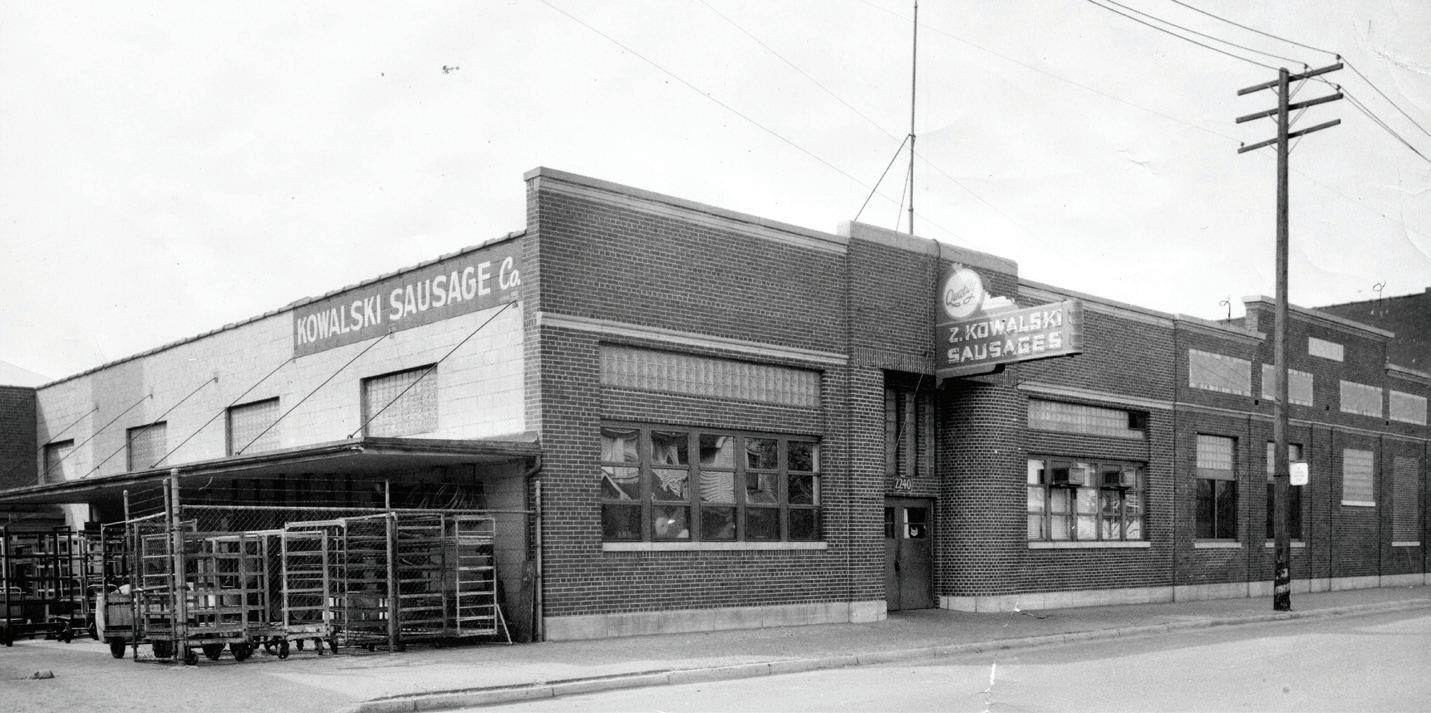




















Community Unity Bank in Birmingham, one of five new banks that opened last year across the country, plans to set itself apart in the industry by providing personal service, digital technology, and a “calming aesthetic.”
 BY DAN CALABRESE | MATTHEW LAVERE
BY DAN CALABRESE | MATTHEW LAVERE
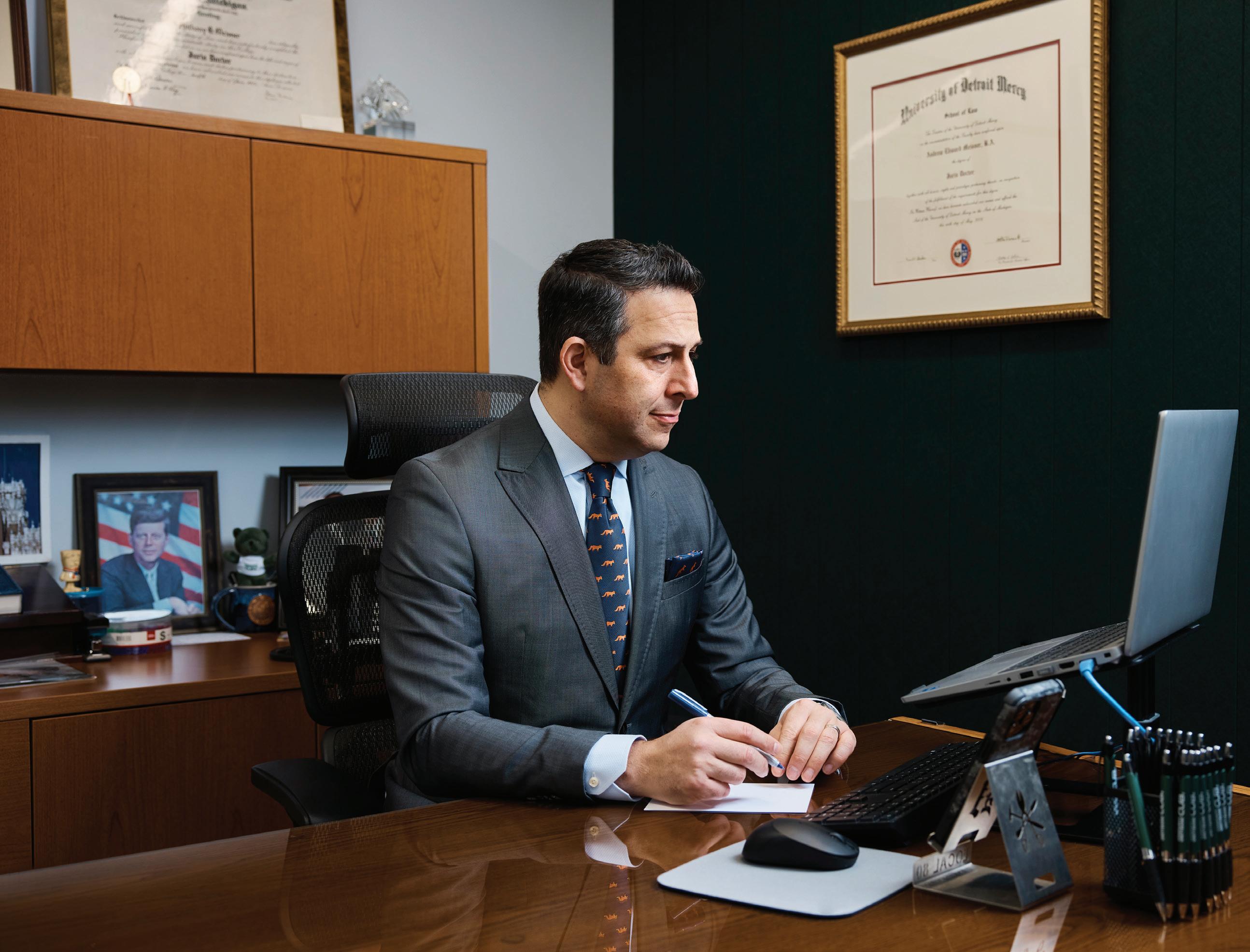
When Andy Meisner left elected o ce after 12 years as Oakland County treasurer and six years in the Michigan State House of Representatives, he wasn’t in the mood for settling into a comfortable job. And while he has a law degree and could have practiced, the pull in his heart was to ll a di erent need.
rough his time speaking with multiple constituents over the years, he was convinced there was demand in metro Detroit for a locally owned community bank. Upon leaving the treasurer’s o ce in 2021, he started working to pull together the assets and the regulatory approvals to launch what o cially became, in June 2023, Community Unity Bank in Birmingham.
“As county treasurer for 12 years, I worked really closely with the nancial institutions in and around Oakland County, and what I observed was a great deal of absorption, where a lot of banks were purchased by
PUBLIC AND PRIVATE
Andy Meisner, president and CEO of Community Unity Bank in Birmingham, once worked as an aide to Congressmen Sander Levin and David Obey. From there, he served in the State House (2002-08) and as Oakland County treasurer.
larger banks,” Meisner says, citing examples that include Level One Bank, Main Street Bank, and Lotus Bank, among others.
Between the consolidation and the subsequent branch closures, Meisner believes the community was lacking a locally owned institution to serve individuals and businesses alike. “Our hypothesis was that we need to repopulate Oakland County with some community-based small banks that can provide the latest services and that personal touch in a way the large banks can’t,” Meisner says.
e inaugural branch of Community Unity Bank has between $9 million and $10 million in deposits from 120 depositors, a total of around $26 million in assets, and 14 employees. Meisner serves as president and CEO, while co-founder Maria Dubiel, a 39-year veteran of the banking industry, serves as chief credit o cer.
More branches could be part of Community Unity’s future. Acquisitions of other banks aren’t out of the question, either. But none of that can happen during the bank’s rst three years, when regulators classify a new bank as a De Novo institution, placing considerable limitations on its ability to take on new overhead.
at’s ne with Meisner and Dubiel, who can focus on marketing the bank to new depositors and mastering their approach to customer service. After all, starting the bank was enough of a challenge in its own right.


Products: Banking services and digital offerings
Headquarters: Birmingham
Assets: $26M
Depositors: 120+
Employees: 14
President and CEO: Andy Meisner
Meisner, 50, lives in Huntington Woods with his wife, Sarah, and three sons ages 10, 8, and 3. A Berkley High School graduate, Meisner has the unusual distinction of having attended two years of classes at Michigan State University and then two years at the University of Michigan to complete his undergraduate degree. He went to the University of Detroit Mercy to earn his law degree.
Following law school, Meisner spent five years in Washington, D.C., working on the staffs of Congressmen Sander Levin and David Obey before returning to Michigan and spending time as the corporate communication director for Farbman Group, a full-service real estate firm in Farmington Hills.
Upon his election to the Michigan House of Representatives in 2003, Meisner worked his way to the chairmanship of the House Commerce Committee, where he got a crash course on issues facing small businesses. He furthered that education from 2009 through 2021 as the Oakland County treasurer.
When Meisner was getting ready to leave Oakland County at the end of 2021, one of his first calls was to Dubiel, who had just announced her retirement from Huntington Bank. She was ready to walk away from banking, but Meisner’s plans intrigued her.
“There’s definitely a niche we felt for customer service, for me coming from a larger bank and knowing the way customer service is at a larger bank,” Dubiel says.
“A smaller bank can deliver that a little more quickly and a little more personally than a larger bank can.”
To get started, Meisner and Dubiel worked with attorney Brennan Ryan, who had been connected to Dubiel during her time at the former Talmer Bank, along with the consulting firm FinPro, to file their joint application for a Michigan state bank charter and FDIC insurance.
As part of the application process, completed in January 2022, the prospective bankers listed the amount of assets they expected to be able to raise to open the bank. If the regulators accepted the proposed amount — and in this case they did, to the tune of $25 million — the raising of that specific amount would become a condition of the charter being approved.
But that’s just one of many requirements. A new bank also has to secure its key staff and vendors, set up its technology, and build all the primary financial products it will be offering to its market. And this is all without any guarantee the charter will be approved.
With the help of investment bank Donnelly Penman & Partners, Meisner and Dubiel were able to raise $28.6 million through private investors. The added funds were used to secure a bank branch location, hire staff, and contract out for professional services, among other requirements.
To help advance the application approval process, Meisner approached the regulators and asked them, point blank, if they believed the market needed more local banks that could provide higher priority to smaller and mid-sized borrowers.

“They said, ‘We’re seeing the same thing you’re seeing,’ ” Meisner says.
With the capital and the staff secured, and with the products and the technology in place, the bank was ready to open for business in June 2023, when the charter was approved and FDIC insurance was granted.
Rather than make a big splash, the team chose a “soft opening” at that time, in a bid to fine-tune its operations and prepare for a more high-profile opening later in the year with a ribbon-cutting and a community reception.
While they had always believed in the market’s need for a bank like Community Unity, Meisner and Dubiel had to be sure they knew their competitive distinction. In their minds, they provide a compelling combination of strong technology and personal service. The bank also offers an online banking app that Meisner describes as clean and intuitive.
“It’s easy to navigate,” Meisner says. “It’s very quick and has some efficiencies built in that other institutions don’t have.”
He gave an example of app users who have more than one account being able to access everything with a single user name and password.
“A lot of existing banks are working on very old technology platforms,” Meisner says. “One of the nice things about starting a bank right now is we were able to choose from the cream of the crop for digital technology.”
Meisner knows that technology alone doesn’t set a local bank apart; every bank has some sort of app, especially larger institutions. Above all else, he wanted Community Unity’s staff to make customers feel like they’re known and understood at a personal level.
“A lot of the time people go into a bank and the staff may look at them angrily, like they’re doing them a favor giving them their own money,” Meisner says. “I think in my time in public service, I had a reputation of being very approachable and friendly. And that’s the personality of our bank.”
He also emphasizes a priority to create a “calming aesthetic” within the bank branch. That includes an outdoor patio where bankers can meet with customers when the weather cooperates. Other features also help set the bank apart, with a quirky type of décor with desks and other items made of salvaged wood from the former Hazel Park Raceway. The bank contracted with a nonprofit called Architectural Salvage Warehouse of Detroit to create the furniture.
It was a good fit for Meisner, whose old House district used to include Hazel Park. While he acknowledges he’s “not a big gambling fan,” he also recognizes that, as a legislator, it was his job to advocate for everyone in his district.
The establishment of a new bank in Michigan, especially in the metro Detroit region, is a rare occurrence. The Michigan Department of Insurance and Financial Services noted, upon Community Unity’s opening in June 2023, that it was the first new bank in the region in 10 years.
Community Unity Bank was one of only five new banks established in the entire United States during 2023. The others were:
• Adelphi Bank in Columbus, Ohio
• Beach Cities Commercial Bank in Irvine, Calif.
• Icon Business Bank in Riverside, Calif.
• Zenith Private Bank and Trust in Scottsdale, Ariz.
That speaks to the challenges involved with starting a new institution. Plus, once a bank is open for business, it has some catching up to do with the rest of the market.
With assets of under $30 million, Community Unity is limited in the loans it can make; nothing beyond $2.5 million is allowed. If a customer needed a larger loan, Community Unity could partner with another bank to complete the deal, but it can’t make the loan solo until it grows its asset base.
That’s certainly the goal, Meisner says, outlining plans to reach an asset range of $230 million to $250 million within its first three years of operation.
“The regulators want us to act in a manner that’s focused on safety and soundness, and not take on (the type of) undue risk that we might be able to take on when we’re at $250 million,” Meisner says. “If we had a $1 million loan that went the wrong way at some point, it would have a big impact on us. That will be less so when we’re at $250 million.”
While the banking industry is new to Meisner, it’s old hat to Dubiel, seasoned staff members, and the Community Unity loan committee.
“I haven’t experienced the regulatory component, although I did come from government,” Meisner says. “I was familiar with the governmental prerogative, but there are just nuts and bolts to the banking business, and I’ve learned a ton from Maria. Part of my approach is not pretending to be an expert. I don’t need to do that. I have experts here. My model is surrounding myself with lots of experience.”
FAMILY FEELDubiel acknowledges that Meisner needs that experienced support, but says he also brings critical things to the table.
“With all the contacts and experience he gained in the Oakland County market, knowing all the folks he knows, that’s been huge,” Dubiel says.
Meisner says he’s marveled at how precise the banking industry is, with countless overlays of policies, procedures, and regulations. For someone with years of experience dealing in legislation and finance, he has found it to be an especially complex and multidisciplinary industry that he’s worked hard to understand.
And as if the complexity of banking wasn’t challenging enough before, in recent years the emergence of cybersecurity has made things more challenging.
Between electronic wiring services, ACH payments, and the basic ability to pull up an app and move money between accounts, customers today demand the speed and convenience of banking in a digital environment, which is why Community Unity invested so heavily in its app. On the flip side, digital banking activity gives hackers greater opportunities to compromise the financial and operational integrity of banks and their customers.
Meisner and Dubiel know how critical it is to be many steps ahead of cyber-attackers. “It’s an obsession of ours,” Meisner says.
I SEE COMMUNITY BANKING AS A PUBLIC SERVICE, AND IT’S A CONTINUATION OF A NUMBER OF THEMES THAT WERE PROMINENT IN MY PUBLIC SERVICE CAREER.”
— ANDY MEISNER
Gus greets visitors and keeps a watchful eye out for anyone who needs assistance. Meisner says dogs like Gus create a calming effect for everyone, including workers.

Community Unity has undertaken a number of steps to secure itself, including the use of a system called Positive Pay, which requires anyone receiving a payment from an account holder to be pre-approved by that account holder.
“It serves as an additional check on every transaction, so if there’s a transaction initiated that you haven’t affirmatively told us it’s OK to pay these people, then it’s blocked,” Dubiel says.
The bank also has an outside company periodically perform what’s known as a “white hat” attack on its systems. These are “good guy” hackers who attack the system in order to show the bank its potential vulnerabilities. They also lead the bank through a process known as penetration testing, in which the bank can see what a hacker can do once he or she gets inside the system.
Additionally, the bank chose as its domain suffix the more specialized .bank, instead of the traditional .com. The suffix is only available to financial institutions.
But how is that a cybersecurity measure?
Because the majority of cyber-attackers get into a company’s system with deceptive emails from domains that appear to be friendly — tricking recipients into opening attachments or clicking links that, unwittingly, give the hackers an entry point to access the enterprise system.
By using a .bank domain, Community Unity makes it a little more difficult for hackers to use that technique. And every advantage counts when it comes to cybersecurity, especially considering that some organizations have paid hundreds of millions of dollars to ransomware attackers.
What’s more, some hackers can disable a company’s entire digital system and refuse to release it until they receive a ransom payment.
“Part of what we do to promote a culture of cybersecurity is to constantly address it,” Meisner says, noting that even one mistake by an employee can compromise the system. “We recently went through some penetration testing and had a third party send a tempting email to us. We passed. This is about cybersecurity not only for us, but for our customers.”
It’s a lot to take on for a guy who could have taken a corporate job or run for another public office. But it’s clear from talking to Meisner that nothing else would have satisfied him.
“I see community banking as a public service, and it’s a continuation of a number of themes that were prominent in my public service career,” Meisner says. “I was always a booster of large, middle, and small businesses, as well as entrepreneurship, and I always wanted to do something entrepreneurial myself. And we really did perceive there to be a need for a community bank.
“If you think of small business as the backbone of the economy, and you think of capital as the lifeblood of small business — I’ll cop to a mixed metaphor, but you get the idea.”
Meisner also is enthusiastic about doing something he used to challenge other bankers to do when he was Oakland County treasurer, which is to make investments pursuant to the Community Reinvestment Act.
“For some institutions, CRA ends up being a ‘gotta do’ instead of a ‘want to do’ it,” he says. “Maria and I and our team really want to do it. As county treasurer, I was the chief investment officer of the county and I managed about $1.5 billion, and I would go to the banks and credit unions and say, ‘Hey, I’m depositing this money with your institutions in Pontiac. That invokes the CRA. What are you going to do to get an excellent rating?’ ”
Like so many other things about his new venture, the question is now turned on Meisner. And that’s just how he wants it.















































 BY DALE BUSS |
BY DALE BUSS |














Serial entrepreneur Manoj Bhargava, creator of the hyper-successful 5-hour Energy drink and multiple life-enhancing enterprises in Farmington Hills, is now betting big on delivering unfiltered news to the masses.


VALUE ADD
After making a billion-dollar-plus fortune on 5-hour Energy products, Manoj Bhargava is building a media empire, all the while making it easier for developing populations to better sustain their everyday lives.


anoj Bhargava became a billionaire by inventing the energy shot, then turned to salvaging the world’s fresh-water supply, reinventing fertilizer for ird-World farmers, attacking the challenge of distributed electricity generation, developing a promising new therapy for Alzheimer’s disease, and — maybe most di cult of all — removing bias from television news.
But he was striving toward all of that mostly in relative anonymity.
Not so much anymore. e reticent $5-billion man from Farmington Hills is now running a publicly held company in the high-pro le media business after committing a total of $110 million last year to acquire a 65 percent share of Arena Group Holdings, which is home to more than 265 brands including icons such as Sports Illustrated, Men’s Journal, and Parade.
Bhargava is blending Arena’s operations with a TV news network and other media entities he already started, hoping to create synergies among the combined digital, broadcast, and print brands and platforms, and planning to model a new type of relationship with advertisers like his 5-hour Energy brand. But the road hasn’t been easy.
Last November, when it was reported Sports Illustrated published AI-creative content, the backlash was swift. Consumers and investors hated reading words coming from robots. Since then, the company’s stock fell to around $1 in early February, from a high of $14 in late 2022.
As the new year opened, most of SI’s roughly 100 sta members learned they could be let go by the spring or become independent contractors. at was followed by Arena Group’s decision to renegotiate the deal with the magazine’s licensor, billionaire Jamie Salter. At the same time, Arena Group missed a large debt payment and a licensing fee.
Salter, fearing his other brands like Forever 21, Brooks Brothers, and Izod would follow suit, revoked Arena’s license but allowed the company to keep publishing the monthly magazine.
As Bhargava navigates the huge new challenge of transforming the media and advertising business, he’s approaching all of his projects with both jarring ambition and matter-of-fact ease that, at times, causes him to be mistaken for being self-centered, and at other times to be misperceived as a perpetual tinkerer.
Actually, until now, he’s remained relatively unknown among the general public and has been rather low-key about devoting most of his considerable nancial resources to tackling worldsized challenges in practical ways while also ensuring that his core business, 5-hour Energy, keeps succeeding and providing fuel for implementing his other goals.
Continuously creative, serially innovative, and earnestly directed outward, Bhargava might be called a billionaire sui generis — one who wants to solve some of the world’s biggest problems solely with insight, technologies, devices, and systems that he helps design, market, and deploy. In that way, acquiring control of Arena — an existing entity — was out of character for him.








Revenue: NA
Employees: 100+










Companies: 5-hour Energy, Innovation Ventures, Stage 2 Innovations, Hans Premium Water, Bridge Media Networks (NewsNet, Sports News Highlights, TravelHost), and more.
Headquarters: Farmington Hills
Founder and CEO: Manoj Bhargava (Net Worth, $1.3B, Celebrity Net Worth)
“I look at fundamental things, so we don’t do ‘cool’ stu so much,” he says about the vast industrial and consumer-products enterprises that come under the umbrella of his holding company, called Living Essentials. “It’s not about entertainment or convenience. ere are no video games; there are all kinds of incentives for doing that, and more money, but that’s really for rich people. In the end, we like to do things that we think are worthwhile for humanity.”
A quarter-century ago, Bhargava came up with the shots — those 2-ounce cans of ca eine, taurine, and vitamins that people buy at convenience-store checkouts for mental clarity and focus, or just to get through the day without nodding o — after imbibing a poor-tasting energy drink at a trade show. He correctly gured he could do a better job of delivering ingredients that bolstered concentration and alertness without having to slosh them around in the huge volumes of liquid used by beverage-sized energy drinks.
With the rst $1 billion in proceeds from inventing the energy-shot category, Bhargava began nancing his other interests. He started an enterprise called Stage 2 Innovations, a technology and industrial skunkworks where dozens of scientists, technicians, engineers, and others work assiduously on Bhargava’s personal goal of helping solve the biggest problems of the poorest one-third of the world: water, health care, and energy.
“I have 11 startups and three that make money, and I go from one to the other” throughout the day, Bhargava explains. “It’s not about (having one focus). It’s di erent things at di erent times.”
While he’s peripatetic, at the same time Bhargava remains devoted to the things he’s dug into. e combination of these factors gives him a leadership style that keeps him and his sta very busy.
“I like getting up in the morning and running like hell,” the 70-yearold says. “To quote Elvis: a little less conversation, a little more action. I like to do something useful every day, and that’s what we try to do. To spend money on toys; I don’t consider that useful.”


at’s how colleagues see it, too. “We get up every morning, work hard all day, have a lot of fun, do some good in the world, and start over tomorrow,” says Vince Bodiford, a former Gannett newspaper executive who is CEO of Bhargava’s Bridge Media Networks, the company merging with Arena, and serves as his main spokesman.
“ ere’s not a lot of complexity. (Bhargava) likes to move everyone down the eld a little bit every day. And he’s going to touch the whole organization himself, personally, every day,” Bodiford says.
In that way, Bhargava remains much more of a vital leader who’s still inspiring his people, rather than some distant or extravagant Croesus. He signed Bill Gates’ Giving Pledge, but he’s not out there all atwitter like Elon Musk or Mark Cuban; nor is Bhargava buttoned-up, sober, and corporate like Bill Gates; and he certainly doesn’t epitomize the jet-setting and yacht-living approach a la Jeff Bezos.
Maybe not surprisingly, Bhargava is critical of some fellow billionaire philanthropists who, in his view, have misdirected their resources. ey “want to do whatever is popular,” he says. “ eir aim is to do what they’re really interested in. To me, the bottom third of the world isn’t about what you want to do for them; it’s about what they need. e world is like a customer; you serve the customer.
“I don’t care what’s popular,” Bhargava continues. “I don’t want to be popular. I prefer to quietly do my stu . But I’m (about) common sense. I’m a student of the obvious.”
For example, when it comes to malicious diseases, even pandemics, “More than 50 percent of the people in the hospitals in the world are there because of water-based diseases, and in poor places, that’s much higher, like 60 percent or 70 percent,” Bhargava says. “If you’re not doing water, you’re not doing disease. And if you solve water, people are stronger and can resist other diseases better.”
Along the way, Bhargava coincidentally has become representative of one of the biggest stories of this century in American business management: the rise of the India-native and Indian-American entrepreneur and corporate leader. Along with Vinod Khosla, founder of giant Khosla Ventures, this group also notably includes Microsoft CEO Satya Nadella, Alphabet CEO Sundar Pichai, and former PepsiCo CEO Indra Nooyi. Presidential candidate Nikki Haley and former candidate Vivek Ramaswamy represent the political aspect of Indian-American leadership, as well.
“We’re (nearly) the largest population in the world, so some of us are going to do something,” Bhargava quips. “Yes, (Indian heritage) Fortune 500 CEOs are way out of proportion for our population here, but people who came here have always been immigrants who built this country, whether it was Italians or Jews or the Irish.
“ ey worked hard and got to where they did with their work ethic. (Indian business leaders) are, at this point, in a wave that’s been rising for a long time. It’s like an iceberg; there was a lot of work below before you got to see what was above the water.”











































HAVING VANQUISHED all other comers in making 5-hour Energy the kingpin of the energy-shot business, its creator isn’t ready to give up the ride anytime soon.
“If someone came and said, ‘We’ll give you a zillion dollars,’ I might sell it,” says Manoj Bhargava, creator of 5-hour Energy and founder and CEO of Innovation Ventures in Farmington Hills. “But no one has shown up yet. It would be a bunch of money, and only big guys could a ord it.”
In the meantime, Bhargava continues to look for ways to enhance the commercial juggernaut that enables his philanthropy. He’s finally turned to an obvious one: Get into the energy-drinks business, the vast category that’s made up of 8-ounce and 16-ounce single-serve cans and was created at about the same time Bhargava invented energy shots. The market is now dominated by Red Bull, Monster, and PepsiCo’s Rockstar.
After many years of staying out, 5-hour took the plunge into its new category two years ago. Bhargava’s formidable competitors had learned, over the years, exactly how to appeal to the mostly young, mostly male, gamer-overindexed market for the ca eine-fueled, jolt-you-awake, keep-you-alert-for-the-long-grind bottles of totally processed chemical elixirs.
That didn’t dissuade Bhargava; he had succeeded by cultivating much the same market with his 5-hour shots. “We’ve got that established 5-hour Energy name, and we can leverage that name,” Bhargava says. “The jury is still out on (our success in energy beverages). We’ve had to develop a whole new distribution system.”



In spite of the challenges, he believes 5-hour has an edge in its new category. “It just tastes incredibly better,” he asserts.
Some observers say it’s about time. “It makes sense, with their successful platform in shots and a very well-known brand,” says Duane Stanford, editor in chief of Beverage Digest



“It’s almost derelict not to try to leverage that. But shots are so di erent, do you want to let yourself get distracted?”
Je rey Sigouin is 5-hour Energy’s president and COO, and he provides a fuller explanation as to why the company finally got in and why it did so in the 16-ounce segment first.
“That category had been experiencing explosive growth for a decade,” Sigouin says, “and we know from our research that consumers who join the 5-hour franchise typically come to us from energy drinks; about 30 percent of them use both. The people we lose, we’re losing to energy drinks.
“This was talked about for years” inside the company. “We thought it was shameful to watch our franchise potentially under attack when we had the technology to get into the energy beverage business,” says Sigouin, who came to 5-hour Energy with experience in packaged foods, the private-label grocery world, and the GSK pharma outfit.
Bhargava wasn’t dissuaded even though Coca-Cola pulled out of the energy drink category after a very short run. PepsiCo had bought Rockstar in 2020 for nearly $4 billion, so it wasn’t surprising that Coca-Cola launched Coke Energy shortly thereafter. But COVID-19, and the company’s subsequent decision to vastly cull its product portfolio, helped Coke terminate Coca-Cola Energy in mid-2021. The decision signaled just how di cult the energy drinks category could be, even for a legendary beverage enterprise.
The 5-hour brand now is daring to compete with Monster, et al, despite the fact that “energy drinks typically sell for 40 cents to $1 less than our shots do,” Sigouin says. Currently, 5-hour shots retail for around $3 or so at thousands of supermarket and convenience-store checkouts.
“We had a value-proposition issue,” Sigouin says, “so when we went into energy drinks, we went with 16 ounces because of the high price, and we were very bullish that was the right move. Plus, there’s less discounting at that price point. We figured the 5-hour name would be enough to make it the right move.”
The brand’s energy drinks are available in six flavor-specific SKUs labeled “Extra Strength,” and sporting about 230 mg of ca eine in each 16-ounce can, versus a category-typical 130 mg, according to Sigouin.
Yet succeeding in the energy drinks category “has been tougher sledding than we thought,” Sigouin concedes. “Our premium price coming out versus brands more established in that space gave us a di cult time getting trial.”
The challenges in building a distribution network also still dog 5-hour, despite brand recognition of its shots, because “there’s a completely di erent system for shots than for beverages,” Sigouin explains. “It’s hard for us to get national chain distribution because we can’t yet service all stores. It’s been slow going.” — By Dale Buss
Expanding
Bhargava’s backstory began in India, and even rerouted through his native country. Born there to prosperity, he left for America with his parents in 1967 when his academic father enrolled in the Ph.D. program at the Wharton School of the University of Pennsylvania. The family eked through the adjustment to America, but a teenaged Bhargava already was sowing his entrepreneurial seeds, buying a 1953 Chevy dump truck for $400 and scavenging debris from north Philadelphia housing demolition sites.
Bhargava enrolled at Princeton University and lasted there a year, then moved to Fort Wayne, Ind., where his parents had settled and his father owned a plastics company. It was the early 1970s, a tough era economically in the Rust Belt, and a searching Bhargava began reading books in Hindi.
In 1974, he moved to India and spent his 20s traveling there among commune-type monasteries owned and run by an ashram named Hanslok. (Much later, Bhargava would name his not-for-profit entity the Hans Foundation.) He went back and forth from India to the United States, even driving a cab in New York City for a while.
Bhargava finally found a profitable channel for his energies by helming the family plastics business, acquiring adjacent smaller companies, and turning them around. By 2001, he’d taken his PVC manufacturer to $25 million in sales, finally selling it in 2006 and moving to Michigan to be near his wife’s family. They have one son.
Bhargava and his team create devices to purify water and generate electricity, especially in developing nations. In 2015, he pledged 99 percent of his net worth to improving the well-being of the world’s less fortunate.
These days, Bhargava comes to work bright-eyed and presents himself pretty much in the same way every day: in earth tones and that black 5-hour Energy fleece. Lately, he’s been donning On Cloud sneakers, a brand that has become de rigueur among his staff.
Bhargava’s 10-building, 25-acre complex off M-5 in Farmington Hills is a representation of the man: low-key on the outside but spinning with productivity on the inside. All of the buildings are nondescript in typical industrial-park style, barely identified by signs with labels that are meaningless to the outside world.
There’s the headquarters building for administration. The tinkerers’ workshop that is Stage 2 Innovations. The NewsNet building, where contractors have been erecting huge studios with green screens and state-of-the-art lighting, while reporters and producers are ensconced in a buzzing newsroom. Nearby are a building where water-purification systems are made, and The Meridian, a public event venue.
Traversing the campus turns up all sorts of interesting people, from the old to the new. There’s Billy Tally, for instance, who runs engineering and operations and has become one of Bhargava’s righthand aides. Among the newest faces is Ruby Shane, who joined NewsNet as an anchor and producer at the start.
“We have a pretty easy time attracting people,” Bhargava offers. “Most people in this company have an ulterior motive, which is that they want to work for something bigger. Yes, they’ll make money and do well, but this isn’t for some rich guy’s next job. Not everyone is on the front lines, but there’s satisfaction, even if it’s in clerical work, that they’re helping with something bigger, and ‘that’s my contribution.’ At any level, we’re all together, working on something great.”
Part of the appeal of working for Bhargava is how he has cast his vision for the broader purpose of his varied enterprises over the last several years, notably in two documentaries, “Billions in Change” and “Billions in Change 2.” In the films, Bhargava, Tally, and others explain what has become their biggest goal these days: providing enough fresh water to keep developing nations from becoming thirsty. Because so much of the water supply in many tropical and subtropical villages is brackish or “gray,” this is a tremendously tall, and crucial, order.
“It’s not a two-year problem, but decades or 100 years or 200 years,” Bhargava says. “So I look at it as, ‘Let me create the technology and infrastructure to solve the problem, and if it takes hold after I’m dead, that’s fine with me.’ But it will be the largest thing in the world at some point, because (the Third World) is the largest problem in the world today and no one is acknowledging it.”
Bhargava and the Hans Foundation have developed a portable reverse-osmosis system, called Hans 2, that they say is singular in the purity of the water it produces, with a minimum of waste. The small device is capable of producing volumes far beyond anything found in American households today.
“The requirements are so massive,” Bhargava says. “We’re involved in a town in India, 100,000 people, and the whole place has nothing but brackish water. They have to truck in water. But now all the wells will turn out what we can make better than bottled water. And it’s completely funded by us.”
Fortunately, “The biggest guys in (the) water (industry) say we’re a decade ahead of everyone else in the world. We’re at the point where,
with the technology, we can x the world’s water problems. However, water is very political. So, until it gets the attention of, let’s say, climate change, they won’t do anything. Until you turn on the taps in California and you get nothing, governments and politicians won’t do anything.”
Bhargava’s water systems aren’t for everyone. Living Essentials opened a retail store in downtown Birmingham a few years ago to o er the Hans 2 system to local moneyed households. e store closed quickly, although the Hans 2 system is available now through Culligan.
His approach to solving the water challenge has picked up a signicant admirer in Mujeeb Ijaz. e founder and vice chairman of Our Next Energy, which plans to build a $1.6-billion EV battery plant in Van Buren Township, has gotten to know Bhargava and admires his approach to philanthropic entrepreneurism — especially the hands-on part.
“A lot of philanthropies lack ground knowledge in developing countries,” Ijaz says. “But Bhargava says: ‘Don’t stand in this market and think you understand local conditions. You have to live there and be part of it.’ I’ve already taken a chapter from his thought process and have visited seven sub-Saharan countries recently. It’s not our core market, but it’s a research project. I wanted to understand more about living and working in villages and how they get energy and water, and I took that approach directly from (Bhargava’s) advice.”
Bhargava’s method for innovation relies on fresh brainstorms, certainly, but also heavily leans on repurposing existing technologies and combining approaches that haven’t been melded before.
“Most stu we have either repurposed, like great stu was done and can be so much bigger, or we put it together with something else,” he says. “I tend to like simple, but turn it into something really useful. at’s how we go.”
For example, Living Essentials developed a dye method that allows surgeons “to see from underneath where they’re going to cut,” Bhargava says. “It’s like nally turning on the lights to do surgery.” e technology was used in ophthalmology, but Bhargava’s team took the idea and stretched it.
While his aims coincide with those of many who would save the planet, in typical fashion Bhargava rejects casuistry. “ ey used to call ‘pollution’ and ‘population growth’ the causes of our problems,” he says. “ en this phrase came along: ‘climate change.’ at’s very fashionable and popular, but in itself it’s not anything. It’s neither the cause nor the e ect.
“It’s a little late to stop climate change. You can’t stop it next year.” In the meantime, he says, “You’ve got to sleep tonight, and come up with a solution.”
While Bhargava maintains the vision for his enterprises, he also gets involved in nitty-gritty details. So, for example, while a couple of years ago he hired Je rey Sigouin from elsewhere in the consumer-goods industry to helm the 5-hour brand, Bhargava remains deeply

They used to call ‘pollution’ and ‘population growth’ the causes of our problems. Then this phrase came along: ‘climate change.’ That’s very fashionable and popular, but in itself it’s not anything. It’s neither the cause nor the effect.”
— MANOJ BHARGAVA
involved in the speci cs, including personally approving new avor formulations that are crucial to the shots category.
“He approves every avor because, if it doesn’t taste good to him, he doesn’t think anyone else is going to like it,” Sigouin says.
In earlier days, Bhargava tangled with some state attorneys general over the nutritional aspects of 5-hour shots — they criticized its caffeine levels as too high for minor consumers and investigated the brand’s claims for vitamin content, resulting in several millions of dollars in nes and a change in how 5-hour advertised. It’s also been a while since Bhargava celebrated the demise of yet another energy-shot competitor by adding a symbolic “gravestone” to a display of foiled rivals in his o ce.
Bhargava’s priorities, indeed, continue to evolve. One of his aims, depicted in the rst documentary, was to deploy in remote villages a type of bicycle-like generator his team had developed. “By pedaling for an hour, you can have electricity for 24 hours,” Bhargava says. en his team pivoted to developing an attaché-sized generator based on solar panels.
Overall, his interest in revolutionizing decentralized energy generation has slipped in priority, for the moment, at least. “I’m waiting for the next level of technology, which will be sodium solid-state” batteries, Bhargava explains. e technology “may not work for cars because (the batteries are) heavier; cars and iPhones require battery density. But for a lot of applications, a little less density isn’t going to do anything.
“Once it goes to sodium solid-state, the cost of batteries is going to plummet by 90 percent because sodium is cheap. You can give everyone electricity for practically nothing.”
Satisfyingly, Bhargava has already knocked out huge achievements that make living easier for thousands. His team and the Hans Foundation developed Shivansh Farming, a super-fast composting method that’s now being used on more than 10,000 Indian farms, along with being tested elsewhere.
The team at Living Essentials has developed dozens of innovations that generate power, like this self-starter electrical generator, along with creating remote water purifiers and boosting localized fertilizer materials made up of natural and agricultural waste.

In “Billions in Change 2,” Bhargava said: “ ere are more than a billion rural poor. To educate them so they can write computer code is not practical. What they need help in is what they’re already (doing) — farming. e largest costs for farmers (include) fertilizer.”
So Bhargava’s team invented a “self-made” method that involves gathering agricultural waste, tree leaves, cow dung, and other organic material that’s typically lying around subsistence farms, layering it, turning the pile frequently, and monitoring the reaction that turns it into “incredible fertilizer” in just 18 days.
“When (farmers) put this fertilizer on their land, they get incredible amounts of produce, (and) the next round gets better because the soil has improved,” Bhargava says. “ e water requirements are lower,” and cutting required amounts of urea and other agricultural chemicals “has a huge impact across the world.”


Tired of paying ever-rising costs for advertising for brands like 5-hour Energy, Bhargava acquired his own TV network and related properties and called it Bridge Media Network. It’s based in Farmington Hills.
Alzheimer’s is Bhargava’s newest frontier. So far, drugs and existing therapies have only been able to slow a patient’s decline from the pernicious disease.



HIS 5-HOUR ENERGY BRAND dominates its category and already was a household name. But something was bugging Manoj Bhargava that he couldn’t solve even from his lofty position in the consumer packaged goods business.
Namely, the moguls of modern media, who have turned over management of their advertising slots to “programmatic” algorithms, weren’t heeding his complaints about how ine ective and expensive it had become to promote 5-hour Energy products on their platforms.
“Media companies have become so enamored with the delivery and distribution technology that they’ve forgotten their customers — the advertisers,” Bhargava says. “We buy advertising for 5-hour, and from when we started 15 or 20 years ago, it costs 10 to 20 times as much now. It’s so expensive. And there’s so much noise (in advertising). The noise has doubled. To get through all of that, our media people said it has become cost-prohibitive.”
So, Bhargava not only acquired his own TV network two years ago and immediately began expanding it, but last summer, he also engineered an even bigger gambit by acquiring most of Arena Group Holdings as well as control of ShopHQ, a TV-shopping channel, and minor stakes in Audacy, which owns 235 radio stations and a podcast network, and Cumulus Media, best known locally as owner of WJR-AM radio in Detroit.
Back in the day, 5-hour’s TV advertisements were a breakthrough: practical appeals about the benefits of energy shots, a new product, depicting typical scenarios in the o ce and the home, and they helped catapult the brand to success. By now, 5-hour Energy products are ubiquitous.
So why is advertising — much less the creation of an entire TV network from the ground up — necessary at all?
“As with any national CPG (consumer packaged goods) brand, advertising is like having the power in an airplane,” says Vince Bodiford, who has run Bhargava’s media properties and now is co-CEO of Arena Group. “You have to keep the power on. If you start to throttle back on promotional advertising pressure, you’re going to experience and feel that in sales. There’s constant pressure to stay No. 1, and to do that, you need promotional advertising — and TV clearly is a huge part of that.”
For that reason, since 2021 Bhargava and Bodiford have been cobbling together a huge TV- and online-news operation in Farmington Hills called Bridge Media Network. At the moment it consists mainly of NewsNet, and the Sports News and the Highlights channels. In large part, the enterprise is aimed at filling a void once occupied by the now-defunct CNN Headline News, but without the ideological liberal twist. NewsNet’s tag line is, “News as it used to be.”
“We thought of news and said why not do something unique?” explains Bhargava. “Everybody says the same
thing: We don’t have news anymore, just opinion. It’s not even rational or common-sense opinion.”
Bhargava bought the concept and the initial platform for Bridge from Eric Wotila, an entrepreneur in Cadillac, in 2022. To grow it, the key to Bodiford and Bhargava’s strategy has been to purchase dozens of low-power TV stations around the United States, and to make NewsNet and the sports network available online.
Content-wise, they’ve brought in proven journalists such as anchor Jill Washburn, formerly of Fox 2 in Detroit, and no-nonsense, seasoned newspaper executives who remember how to make objective editorial decisions.
The network is available online as well as via popular “over the top” platforms such as Roku and Hulu. And, more and more, viewers can access NewsNet “over the air” through high-definition antennas that are increasingly included on new televisions and can pick up dozens of stations — including the ones Bhargava now owns.
Bhargava’s move in August vastly amplified his

As part of Bhargava’s strategy to better leverage advertising dollars by acquiring interest in media properties like Sports Illustrated, he hopes to lower his marketing costs.
investments in the media world. He gave Arena $50 million in cash and a five-year guaranteed advertising commitment of $60 million from his brands. Among his first objectives, he says, will be to get his new media properties to pay attention to consumers who are 40 years or older, rather than the millennials who remain the shiny object in the U.S. market.
But, even with a much bigger cudgel to achieve his advertising aims for 5-hour than he had just a few months ago, Bhargava pledges that adding Arena and its built-out brands and operations to his stable won’t blow up Bridge Media.
“This is good for both companies,” he says. “There are many more win-win opportunities to come.” And his recent moves in media “Are just a start. It’s going to be fun.”
— By Dale Busse U.S. Food and Drug Administration recently approved the drug Leqembi, a new type of treatment by Biogen, but Bhargava believes his people are developing something that’s tremendously promising for the 6 million Americans — and many others globally — who have various stages of Alzheimer’s.
“We came up with a way that, in some cases, has reversed Alzheimer’s,” Bhargava says. He describes it as a mechanical method of stimulating the circulatory system that involves a person lying on a medical bed with pairs of in atable cu s that cross the lower limbs at strategic points.
“It’s not pharma; it’s a noninvasive treatment that squeezes in between your heartbeats, like a secondary heart. It enhances blood ow, and that’s a fundamental (component) of health,” he explains. “If you had trash in your head and didn’t have blood ow, what would happen? It would rot, and then all sorts of bad things would happen.”
e aim of the Cerezen ECP (external counter pulsation) therapy, he says, “is not allowing a decline at all and, in some cases, reversing” the course of the condition. “ ere are no side e ects from our therapy, and the contraindications are similar to those from walking on a treadmill.”
A technician wraps the cu s, which resemble those used for measuring blood pressure, around a patient’s calves, thighs, and hips. Images from “Young Frankenstein” and “Emergency!” come to mind. “When I rst looked at it, I said, ‘Are you (engineers) kidding?’ ” Bhargava said in “Billions in Change.”
“Is this (a scene from) Monty Python’s ‘ e Life of Brian,’ volunteering for cruci xion?”
But then the device begins agitating the legs, visibly engaging the extremities, in between heart beats — delivering even more oxygenated blood to the extremities, and reducing angina and related symptoms. “It’s a wellness device,” Bhargava concludes.
e FDA has approved Cerezen ECP for enhancing blood ow and overall cardiovascular e ciency, but Bhargava is aiming this therapy at a much larger objective: getting a government-approved trial to see if it can mitigate Alzheimer’s. “We are ahead of everyone else in the world in Alzheimer’s, right here in Detroit,” he says. “ is is the biggest thing that could hit health care in a long time. And this is Alzheimer’s; it’s not ingrown toenails we’re talking about. is is the issue.”
In any event, the goal is very Bhargava. “ ere’s not that much more I can do with 5-hour,” Bhargava concedes. “I can increase 5-hour sales by a few percent, or I can do something much bigger.”

Michigan may not match other states for its sheer number of ultra-luxury homes, but the appreciation for and value of mega-mansions is finally on par with the wealthiest markets in the country.
BY DALE BUSShe ongoing battle between players in Detroit’s behemoth mortgage industry may have come down to this: who’s living in the pricier homes?
Recent purchases of multimillion-dollar properties by Mat Ishbia, president and CEO of United Wholesale Mortgage in Pontiac, and Matt Cullen, long a top lieutenant of Rocket Mortgage, part of Rocket Cos. in Detroit, could be considered the latest salvos in one of the biggest wars in Michigan business.
In January, Cullen, whose o cial role now is chair of Jack Entertainment, a Cleveland-based gaming company formerly owned by Dan Gilbert, founder and chairman of Rocket Cos., laid down more than $4.6 million to purchase a lakefront spread in Grosse Pointe Shores that was owned by the family of the late billionaire philanthropist Ralph C. Wilson Jr. e estate, located adjacent to the Grosse Pointe Yacht Club, consists of three structures — a

Mid-century Modern house of nearly 5,500 square feet, a guest cottage, and a farmhouse — all of which abuts 450 feet of shoreline along Lake St. Clair.
Cullen’s move came only months after Ishbia hatched plans to build the state’s largest occupied house, a planned 60,000-square-foot colossus in Bloom eld Township that will require him to raze ve houses — including his own existing, 22,000-square-foot home.
He can readily a ord the upgrade, as Forbes magazine ranks Ishbia as Michigan’s fourth-wealthiest person, with an estimated worth of $4.5 billion as of 2022.
Ishbia plans to assemble 14 acres for a mansion, a trampoline park, a basketball court (standard equipment for the new owner of the Phoenix Suns), an additional “sports court,” a treehouse, a re ecting pool, a 14-foot-tall waterfall, a “lazy river” spanning some 200 feet, and even something called an “Enchanted Forest,” according to documents Ishbia submitted to township o cials.
Indeed, Ishbia’s new spread will be “its own animal,” says Katherine Rodriguez, head of her own bespoke studio in Birmingham, where she and her team design the interiors of many of the area’s ultra-luxury homes.
Overall, signs of residential activity are percolating in the tippy-top of the state’s housing market these days. In last year’s third quarter, Detroit ranked No. 9 in the luxury breakout of e Wall Street Journal/Realtor.com Emerging Housing Markets Index, which looks at the top 10 percent of housing in major U.S. metropolises.
e Detroit area’s median luxury listing price rose 6.4 percent year over year, as a limited high-end inventory of homes accelerated in value here compared with much of the rest of the country, and pushed purchase or construction costs for the priciest homes to $1,000 a square foot and more.
Fortunately for the local economy, that performance isn’t mere froth, but is well supported by strong appreciation in the general housing market underneath. At 6.7 percent over a year earlier, Detroit-area home prices in September showed a percentage increase higher than any of the other 20 metro regions in


the S&P CoreLogic Case-Shiller index. Nationwide, prices were up 3.9 percent from September 2022.
“Five years ago, where we were going with real estate, you never would have imagined what you see right now,” says Arya Afrakhteh, founder of Brandywine Homes, a Birmingham-based luxury builder that focuses on the region’s northwestern suburbs.
“You go to California and look at the top-end homes that sell there, or ats and other properties in New York City, and it used to be much easier to sell at that high end than in our market. But that has changed tremendously. We’re on par with those markets now.”
Dan Gutfreund, an agent focused on the ultra-luxury market for Signature Sotheby’s International Realty in Birmingham, notes “the values of new-home construction have been considerably lower in Detroit than in other major cities in the U.S. for a long time. Now, we’re even bumping up against major international cities like Toronto, where you can’t nd luxury homes for under $1,600 to $1,700 a square foot.”
Just look around the area and the state, and more and more valuable jewels emerge. Consider, for instance, the $4.8-million price being sought for a nearly century-old, French Norman-style chateau mansion in Grosse Pointe Farms that went on the market last year. It features a walnut library and a central Belgian block-granite courtyard with a fountain and a turret.
Or the 22-acre estate in northern Rochester Hills with a 10,000-square-foot main house called “La Reve” — “the dream” in French — which, among its 118 rooms, includes an entertainment parlor featuring a billiards area, a library with gold accents, a heated court, a conservatory, a gazebo, a bowling lawn, and a formal English boxwood garden. It didn’t sell at auction in October and is still available.
Shifting west across the state to Holland, nearly 15 years ago Dick and Betsy DeVos demolished his father’s former 12,000-square-foot estate on Lake Macatawa to make room for a new, 22,000-square-foot, Shingle-style mansion that cost some $3 million to build and certainly would list for at least twice that amount if the Amway heirs sold it today.
Zigzagging to northeastern Michigan, a 3,500-square-foot lodge on Misery Bay Road in Alpena is decidedly unprepossessing, with ve bedrooms and three bathrooms mostly clad in knotty pine. But the reason this property is valued at $18 million, among the highest in the state, is its 18,480 feet of pristine Lake Huron shoreline, along with 710 acres of undeveloped property. It comes complete with a pole barn with tractors, excavators, and other outdoor play equipment.
Proceed due west from the lodge to Charlevoix, where for $4.5 million one could buy a sui generis dwelling built by an architect for $2.8 million in the style of e Hobbit, complete with roofs that look like mushroom caps, oversized heavy wood beams, white-painted walls, a stone wet bar, a wine cellar, and a media room.
At the very pinnacle of the multimillion-dollar homes where enormously wealthy individuals play, Michigan still doesn’t qualify with the longtime elite markets such as metro New York City, southeastern Florida, Hollywood, or Silicon Valley. Indeed, the number of houses that sell for more than $5 million amounts to only a handful each year in Michigan, versus dozens in some of the major coastal markets, and even metro Chicago.
In 2023, there were three sales of luxury homes priced at more than $5 million within a 20-mile radius of Detroit. In early January there were nine estates on the

market in southeastern Michigan for more than $5 million, per Zillow.
“So there’s basically three years’ worth of inventory sitting on the (Michigan) market,” says Scott Kirk, head of Interluxe Auctions, a Charlotte-based online auctioneer that transacts homes at prices from $2 million to more than $10 million.
Indeed, Detroit’s upper level of homes remains a relatively small sample size, but there’s no doubt that, since the end of the Great Recession of 2008 and 2009, and with an accelerant provide by COVID19 and its aftermath, the value and activity in such houses in Michigan have been rising like few other places in the country.
e ascent of southeastern Michigan in the ultra-luxury segment relies on several factors. Most important is the continued prosperity of the auto industry. Michigan’s carmakers and suppliers have encountered all sorts of ups and downs over the last two decades — including the ongoing bumpy transition to electric vehicles — but the long-term outlook for the state’s global leadership in its most signi cant native industry remains bullish.
Meanwhile, thanks to the last decade or so of a vibrant economy overall, many company owners in southeastern Michigan have sold their businesses “and wanted to live at a certain level, so they’re investing in that,” Gutfreund says. “Or they have family members who are coming back from going to (college) out of state and want to enjoy the quality of life here, which is better than elsewhere.”
Kathy Broock, principal of Kathy Broock & Co. Max Broock Realtors in Birmingham, says the boom in the area’s ultra-luxury market “is a phenomenon that has especially taken hold since the recession, because a lot of people invested in commercial buildings and other properties during the recession, and now they’re worth hundreds of millions of dollars.”
e pandemic also shifted things in Michigan’s favor, as wealthy individuals who could a ord to escape their domiciles on the coasts came to the state looking for more wide-open spaces.
Foreign buyers, many tied to the worldwide auto industry, also have helped boost local demand: 52 percent of luxury-home shoppers in the Detroit area last year were from other major cities, according to Realtor.com. Almost 29 percent of these out-of-state buyers were from the New York City area, and almost
TODAY’S ULTRA-LUXURY homebuyers and builders in Michigan are looking for some things, and decidedly not wanting others. Among the top preferences are:
THE GREAT OUTDOORS: Spending on outdoor entertainment spaces has gone bonkers, including cushy seating areas and fire pits, along with basketball, tennis, and pickleball courts. As for swimming pools — they want outdoor ones, not indoor.
specialist at DOBI Real Estate in Birmingham. “They want convenience and amenities, not big lots.”
SHUFFLING SPACE: Formal living rooms “went out a long time ago,” Afrakhteh says, “and now there isn’t formal dining anymore. People are getting more casual about everyday living and want more bells and whistles, versus square footage.”

“Years ago, people didn’t want a pool because of the maintenance costs,” says Kathy Broock, principal of Kathy Broock & Co. Max Broock Realtors in Birmingham. “People were joining country clubs. But after COVID-19, they don’t want to go to public pools. They want their own. And (they want them) outdoors; indoors is hard to sell.”
CUE THE MOVIE: There’s still demand for dedicated home-theater rooms, but that has waned a bit. “Everybody’s got large-screen TVs in their family room, anyway,” says Arya Afrakhteh, founder of Brandywine Homes, a Birmingham-based luxury builder. “Another part is that people are watching everything on their phones.”
UP FROM THE EARTH: One amenity that’s nearly exclusively available only to the wealthy is geothermal systems, which heat homes by drilling holes deep into the ground, akin to water wells, but tapping the earth’s heat instead. “It’s very expensive to install,” auctioneer Scott Kirk says, “but it’s very e cient.” In-floor radiant-heat systems also appeal to many buyers.
Even so, Nelson notes, luxury buyers “want a huge master suite and large baths and finished basements.”
SIDE NOTE: Kitchens have evolved into important entertainment spaces, which means the slicing and dicing of meats, cheeses, and other delicacies is now done in sculleries or butler’s pantries.

MAN THE PERIMETER: Multimillion-dollar homes now typically include advanced security systems that only begin with front gates and encircling fencing. Today, they deploy all manner of advanced technology through camera systems and other means of detection that feed a remote viewing room in the home.
NICE, NOT BIG: “More people in this segment are building new construction on small lots where spaces are smaller,” says Debbie Nelson, a luxury home
“People are using adjacent smaller rooms almost as a dirty kitchen, doing the prep work there behind or o to the side of the kitchen,” designer Katherine Rodriguez says. “Then they can lay everything out on a big, beautiful island in the kitchen, where everyone is gathering.”
FORE: Golf-simulator rooms have become popular for high-ceilinged basements, imitating the experience many golfers are getting at facilities such as Five Iron Golf in downtown Detroit. Installation costs range from about $30,000 to as much as $150,000.
GOING UP: Rodriguez says occasionally her clients want an elevator. “That would seem to be a little extreme,” she says, “but it goes back to being practical. In multimillion-dollar homes, is there a better way to be practical than that?”

LOOK OUT BELOW: Occasionally, buyers and builders want enough room for their own helipad. “One auto-supplier executive from China wanted to put one in a backyard in Bloomfield Hills,” says Dan Gutfreund, an agent focused on the ultra-luxury market for Signature Sotheby’s International Realty in Birmingham. “It never came about because moving that kind of money out of China is di cult.” — By Dale Buss



Manor homes in Michigan priced below $3 million sell fairly quickly, but more expensive luxury residences often take longer to sell.

9 percent came from Washington, D.C. “You have money coming in from other states where the cost of living is greater, and that money is driving up values in Michigan,” Gutfreund says.
Other factors may be coming into play, as well.
ere’s an increasing rationale behind the idea that, over the long term, southeastern Michigan and the entire state will bene t from rising concern about weather events and climate. As places like California, the Southwest, and the Mountain States deal with water shortages, and as much of the South copes with more torrid summers, living in a multimillion-dollar home on one of Michigan’s pleasant peninsulas, with mild weather most of the year, looks increasingly inviting to people with ultra-means.
“ ere are drought issues and re issues in California, on top of the political issues, for example,” Gutfreund says. “People are moving toward the Great Lakes because of climate.”
On the other side of the equation from burgeoning demand is how a constricted supply of available properties has helped raise the peak in values of ultra-luxury housing in Michigan.
A unique brew of factors, including higher interest rates and demographic inevitabilities, have created a situation where many owners of homes in the $2 million to $3 million range simply don’t want to move up to pricier houses because their mortgage rates will be higher — and their property taxes will be much higher. At the same time, they won’t get that much more “house” for the money.
“With interest rates down around 2 or 3 percent, people re nanced their homes,” Afrakhteh says. “Now, with rates at 7 to 8 percent, they’re not ready to sell their home because of what they’d have to pay for nancing a more expensive home. You only see people willing to sell their luxury homes if there’s a divorce or a death.”
e demographics are based on what is happening — and what isn’t happening — with transfers of homes and wealth from baby boomers, who were America’s largest and richest generation, to their o spring, millennials.
Consider what’s not happening. Many boomers in multimillion-dollar homes who want to extend the comforts of a luxury domicile into the last period of their lives have decided to stay put rather than sell their spacious house and pay even more for another top-level home — which may be pricier even if they would be physically downsizing.



In addition, baby boomers have begun dying o in signi cant numbers, which gives their o spring access to the ultra-luxury homes their parents have owned. “We’ve never seen this kind of transfer of generational wealth,” Broock says.
Boomer parents at every economic level by now are used to realizing that their millennial o spring generally don’t want their parents’ stu . Amplify that in the luxury-home market. e more millennials are counted among the buyers of ultra-luxury homes, the more they want to build their own home rather than purchase, and perhaps overhaul, an existing mansion.
“ ey want the new construction, which is interesting,” Broock says. “It wasn’t long ago that millennials didn’t even want a home and just wanted to rent; now they want a house.”
In any event, this mix of factors means there’s somewhat of a logjam among homeowners in Michigan who want to move from the level of $2 million to $2.5 million homes to, say, $4 million to $9 million.
“ ere are plenty of houses to look at in that level, but they’re still sitting there unless they’re super-amazing homes or unless a few people with deep pockets are coming in,” says Debbie Nelson, a luxury home specialist at DOBI Real Estate in Birmingham. “I’ve got one $7-million buyer who can look at homes that have been listed for $10 million or $11 million where the sellers are begging for buyers. e only people operating at that level are professional athletes or people who have owned their homes forever.”
All this is at play in the Birmingham-Bloom eld Hills hotbed of luxury-home sales. “You see the most density in that area, but you also have a lot of lakes,” says Broock, who began in the real-estate business answering phones as a teenager at her great-grandfather’s company, which was founded in Detroit in 1895. Now, as the fourth-generation owner, she conducts the largest share of luxury-home sales in metro Detroit.
“Grosse Pointe has one waterfront, but we have multiple lakes where you have a broader bandwidth of opportunity. at’s where you’re seeing $7 million to $10 million purchases,” Broock says.
Afrakhteh has been a player in that area since the former nuclear-project engineer moved to Michigan in 2005 and began a bespoke-home construction business with a single $1-million house he built on spec along East Frank Street in downtown Birmingham.
Ironically, executives who were coming in to help restructure the Detroit ree during the post-bankruptcy era were his rst customers, and the housing crash that brought about the Great Recession opened up opportunities for the entrepreneur, who started with no overhead.
“I was able to get A-list subcontractors who were all eager to do the work, and develop relationships with them,” Afrakhteh says. “I took care of them; they took
care of me. ey helped me to bring Brandywine to the level it is now.”
Brandywine includes the sale, last fall, of a $6.9-million mansion adjacent to the Bloom eld Hills Country Club along West Long Lake Road in Bloom eld Hills. e home, measuring nearly 9,400 square feet, is situated on more than an acre and includes six bedrooms and 7.5 bathrooms; a kitchen-adjacent scullery with a double wall oven, a built-in Miele co ee maker, and a double-drawer refrigerator; a four-car heated garage; and a pricey gunite swimming pool with an attached spa.
“Everything is turnkey and very detailed, and I gave a lot of personal attention to it,” Afrakhteh says of the house, which came at an unusually high price point for a home built without a designated buyer. “I like to do spec homes because I’m free to use my innovation and thinking and creativity. I can let my imagination go wild.”
Yet, as with all builders in these long-standing communities of northwestern Oakland County, usually Afrakhteh must start his projects with tear-downs of existing homes. And given the economic factors that have hindered movement in housing up and down the value scale lately, he has to search harder than ever for available properties.
“I used to have four to ve tear-downs in my inventory, in top locations, but now those are a lot harder to come by,” Afrakhteh says. “ ey’re extremely rare in this area now, and that wasn’t the case before. If one tear-down comes to market, 200 people try to jump on it.”
Some of those tear-downs were on Old Woodward Avenue in Birmingham, and made room for Brookside Residences, a boutique condo development with 28 units that sold for $5 million to $6 million apiece.
“Although it doesn’t have a hotel component, the development has been compared to Ritz-Carlton living because of all the amenities,” Gutfreund says. e features include in-home medical care, wake-up calls, car and concierge services, private chefs, housekeeping, and dry-cleaning.
In some ways, it’s “up north,” not the Detroit suburbs, that has served as the bell cow in the ultra-luxury market in the state, with southeast Michigan homes only recently catching up to the value of many of the priciest properties in places like Harbor Springs or along the shores of Lake Michigan.
For example, in 2022 a buyer purchased a home in Charlevoix for $9.8 million, which came to more than $10 million after the owner threw in much of the furniture. Interluxe entertained more than 1,500 buyer inquiries that came from more than 30 di erent states and countries. Ultimately, there were 12 bidders.
Typically, Kirk says, his properties receive 800 to 1,200 buyer inquiries. e purchase price of the Charlevoix mansion was the third-highest ever paid in Michigan for a residential property.
“People have been buying in those areas for $10 million or at least $7 million for a while,” Broock says. “A big reason is that people are coming from all over the country to purchase vacation homes there, from more sources of wealth, ying in from (the East Coast) or Texas on their private planes” to Pellston Regional Airport or



Here are the 10 most expensive homes in Michigan, as listed in the Realtors’ Multiple Listing Service database last year:
Listing price: $9,999,000
Square footage above ground: 10,204

Amenities include: Constructed in 1938 (by the firm that built New York’s Cathedral of St. John the Divine) for former General Motors President and U.S. Defense Secretary C.E. Wilson.
Three acres, 297 feet on Island Lake. Fully renovated, with seven bathrooms, 9.5 baths, and a nanny suite.

Listing price: $9,995,000
Square footage above ground: 12,143
Amenities include: Four-acre site. Seven bedroom suites, Versace floors, chef-grade appliances. Finished walkout basement including 4-D movie theater, sauna and steam room, hot tub, and gym. Full indoor, Detroit Pistons-themed basketball court. “Savant smart” programmable tech.
Listing price: $9,900,000
Square footage above ground: 16,500
Amenities include: Named “La Reve,” or “The Dream.” Twenty-two acre site. Hand-carved wooden archways and handpainted ceiling. Three levels of living space, 118 rooms and 131 doors, two guest homes with additional garages. Tennis court. Heated conservatory. Lush landscaping.
Listing price: $9,850,000
Square footage above ground: 20,064




Michigan’s luxury home market has been fairly parochial; national private equity firms have largely passed the state over, choosing to invest in Miami or New York.
Harbor Springs Airport in Emmet County, or to Cherry Capital Airport in Traverse City, which can accommodate Delta Airlines jets on direct ights from Boston, Dallas, and New York City.
In southeast Michigan, “we’re only now getting competitive with that” level of purchase prices, Broock says. “Our community has been very slow in embracing the fact that we’re a luxury market.”
ere are reasons the Detroit area has trailed some of the highest-end transactions up north. Sticker shock — a familiar concept to automotive executives — is one reason.

Amenities include: Set on 8 acres. Includes 15-car garage with space to house a 90-foot motorhome. Two-story foyer with a grand chandelier and marble flooring, floors of multiple variations of hardwood species, Gunite indoor pool with waterfall and hot tub. “Hidden passageways” and “secret doors” lead to a poker room with a full bar. Three laundry rooms.
Listing price: $9,450,000
Square footage above ground: 7,293
Amenities include: Sited on 148 feet of Lake Michigan frontage. A 40-foot swimming pool and spa overlook sandy riparian beach. Nine bedrooms, 13 baths. French doors open to a large stone terrace overlooking lush landscaping and the lake. Radiant-heated floors. Four-bedroom guest house.
For decades, local denizens have taken a sort of collective pride in the wealth present in Oakland County, and its national ranking of per capita income, which points to the importance of the auto industry and the magnitude of its role in the global economy and in the pursuit of individual wealth. But the current narrative surrounding super-high prices for incredibly large homes is a relatively new one to this area.
Michigan also di ers from many of the leading ultra-luxury markets for other reasons. ere is, for instance, a relative absence of investors purchasing top-notch houses for investment purposes alone.
“Our market doesn’t really deal with private equity the way markets like Miami and New York City do,” Broock says. “In those markets, you’ve got (investors) willing to buy a place for $7 million because they can ip it for $14 million. In Michigan, our community is more about single-family homes, even at the very highest end, where you’re buying it to come in and live in it.”
For example, despite Ishbia’s recent over-the-top plans for his mega-mansion in Bloom eld Township, Gutfreund remarks that the local kingpins of the mortgage business, such as Gilbert, have “lived very conservatively” relative to other titans of business across the country.
At the same time, Kirk notes, many owners of ultra-luxury homes in Michigan also own even higher-priced residences elsewhere, including Florida, Arizona, or greater Denver. “ e number of homes in Michigan that are in this category isn’t nearly as plentiful as in many other locations around the country,” the auctioneer says.
Michigan native Rodriguez got her start decorating ultra-luxury homes in the Birmingham-Bloom eld Hills area after she and her husband moved back to
metro Detroit from Chicago in 2011. As it worked out, she was able to tap into her understanding of the unique sensitivities of Midwesterners — even at rare ed nancial levels.
“ ere’s something about our market in particular, and the Midwest in general, where people are concerned with durability and wear and making sure their home is functional for them,” Rodriguez says. “ at’s part of luxury, too — that their life is easier because we’ve designed their home well. at takes pressure o of executives and people at that level.”
In general, she says, “ ey’re generally very detail-oriented people, which is how many got to be successful. ey want to be aware of what’s going on. ey may say yes to a lot of things I bring them, but then they want to know the details of the inserts in their kitchen-cabinet drawers, and that their fabrics will be performance fabrics because they have dogs. Or they may pick the exact cushion they will sit on for their couch, in person, versus buying something quickly online and being disappointed.”
As relatively conservative as it remains, Michigan’s top-crust housing market isn’t immune to economic ripples.
e Great Recession stopped the segment — and nearly all other housing construction in Michigan — in its tracks. And while the pandemic of 2020 to 2021 was an accelerant, the top-end housing market in Michigan hit another speed bump in late 2023, in the form of the six-week strike by the United Auto Workers against the Detroit ree automakers.
Many executives at the car companies and their suppliers hit the pause button on selling and buying, Kirk reports, although activity was back to normal levels soon after the settlement of the walkout in late October.
Nationally, Kirk says, “there’s been a signi cant slowdown in the last year in the speed with which (ultra-luxury) properties trade.” As for 2024, players believe that an expected leveling of interest rates in the new year, perhaps followed by a drop of 100 or 200 basis points, will loosen up the logjam that has put ultra-luxury home sales in a slog, just as it has a ected sales in the general market.
“ e supply will remain low well into the next few years,” Afrakhteh predicts. “But as the rates fall, it will bring people in who have been holding o purchases. is will continue the strong value dynamics in this (ultra-luxury home) segment in Detroit for years to come.”


Listing price: $9,200,000
Square footage above ground: 7,250

Amenities include: A hundred feet of private beach on the Chikaming side of Union Pier. The nature-inspired color palette reflects the lake and sky, and the lower-level living room opens up to a spacious pool area. Stunning lake views from nearly every room in the house. Expansive gourmet kitchen.
Listing price: $8,750,000
Square footage above ground: 2,841

Amenities include: Historic property called “Riverside.” Nearly 400 feet of prime water frontage and 2.7 acres, with 180-degree views up and down the river and a protected view of iconic Oxbow property. The property was a vibrant artists’ retreat and was a major influence in Saugatuck becoming known as the “Art Coast.”
Listing price: $8,750,000
Square footage above ground: 4,996
Amenities include: The site is called Cherokee Acres Ranch; it’s a 645-acre property featuring hardwood ridges and a spring-fed trout pond. A vibrant creek, marsh pond, swales, and cedar swamps make the land an ultimate wildlife habitat. The lodge and guest house include a three-car garage.
Listing price: $8,600,000
Square footage above ground: 9,160
Amenities include: Gated property on Reeds Lake with water views from every room, as well as a boat house and batting cage. Five bedrooms, seven bathrooms, and four half-baths. Almost 2 acres. Features oversized kitchen islands, a recreation room, wine vault, additional kitchen, home theater, and elevator.
Listing price: $7,299,000
Square footage above ground: 11,479
Amenities include: Four acres and two residences; the original 8,200-square-foot home was built in 1838. The second home, built in 2005, features a walkout basement and eight-car garage, half-court basketball court, and indoor pickleball. Lush landscaping leads down to the Rouge River.



Disclaimers: A few cities and locales don’t list properties in the MLS database. Condominiums aren’t included. Doesn’t include sales by private owners directly to clients.

























Winners of the third DBusiness Corporate Culture Awards are staying ahead of the business trends a ecting employees and their work experiences.BY TIM KEENAN
Anyone looking for an example of the importance of workplace culture need only to look to the Detroit Lions.
At the end of the 2020 NFL season, Sheila Ford Hamp, who had succeeded her mother, Martha Firestone Ford, as principal owner and chair of the team the previous June, laid out a new vision for the organization.
Following the 2020 season, which ended with a 5-11 win-loss record and the dismissal of General Manager Bob Quinn and Head Coach Matt Patricia, Hamp set a goal of establishing the Lions as a workplace built on a collaborative culture.
President and CEO Rod Wood, COO Mike Disner, and Special Assistant Chris Spielman, a former Lions linebacker, also contributed to the new organizational vision.
Another former Lion, Dan Campbell, was hired as the new head coach. Brad Holmes was brought aboard as the new general manager. e two have since bought into the owner’s vision.
“We talk all the time and Brad and I’s relationship is as good as ever,” Campbell said in Sports Illustrated in 2022. “It’s as good as ever. We communicate on a
AND INCLUSION COMPENSATION AND BENEFITSCAREERADVANCEMENT GRATITUDE
COMMUNITY ENGAGEMENT

daily basis, multiple times, on everything. If he’s got something, he presents it to me and he tells me what he’s thinking, and he asks me what I think.
“I would say, at the end of the day we take each other’s opinion and whether we make a move or don’t make a move, we’re both in lockstep with each other.”
When the team started o 1-6 during that 2022 season, Hamp made a rare public statement saying she believed in her vision for the team and in her relatively new coach and GM.
e team rebounded to nish the year 8-2 for an overall 9-8 record.
is past season, that shared culture and vastly improved play on the eld resulted in a 12-5 regular season record, two home playo wins, and a 3-point loss to the San Francisco 49ers that prevented the team’s rst Super Bowl appearance.
A positive corporate culture leads to winning in the business world as well, regardless of how one de nes winning.
e companies represented in the third DBusiness Corporate Culture Awards have been focusing on their work environments longer and have been reaping the rewards for their e orts.














Assembly Ventures, with o ces in Detroit and Berlin, includes Felix Scheu elen, Jessica Robinson, and Chris Thomas (small-business champion).
e Large Company Overall Champion is the Farbman Group in South eld, which has 115 full-time employees and more than 85 independent contractors. e Small-Business Champion, with eight employees, is Assembly Ventures, a specialized venture capital rm in Detroit.
Farbman Group President Andy Gutman says the key to having satis ed employees is to treat them like family rather than workers. “Woven into the fabric of Farbman is a kindness culture,” Gutman says. “It starts by listening to people.”
ere are several ways the Farbman Group goes about listening to its people. ere’s an anonymous message board where employees can air grievances.
ere are monthly think tank forums, and there’s a committee called Farbman 3,000 dedicated to technology and the future of the organization.
“If there are barriers to the success of our employees, it’s our job to remove them,” Gutman says.
Other ways Farbman treats its employees like family include loans for employees who are facing nancial di culties, catered lunches two or three days each week, and a fully stocked kitchen.
“We have a mixture of healthy and unhealthy snacks,” Gutman says. “We tried all healthy for a while, and that wasn’t very popular.”
Active in the community, Farbman supports several charitable organizations. What’s more, employees volunteer to represent the company at events, and they can participate in activities like whirly ball games.
e rm also excels in the workplace exibility category, a longtime staple.
“We were doing workplace exibility before it was COVID-19 cool,” Gutman says. “And we foster a culture where you’re allowed to make mistakes, as long as it’s not intentional, repetitive, or from a lack of work ethic. We can learn from mistakes.”
Perhaps most important is the company’s overall dedication to its workforce.
“When the Great Recession hit, we didn’t lay a


e strategy paid o .







single person o ,” Gutman says. “We decided to carry a little bit more overhead during that time. We gured the loyalty would pay o because people will remember that.”
“We have very little turnover here,” Gutman says. “ e people who do leave are retiring. We have longevity here and I think that’s a statement about how we treat our people.”
Assembly Ventures Co-founder and Partner Chris omas says his focus is to treat every employee like a guest in his home.
“ e way we treat the employees at any level of the company is the way that we would like to be treated,” he says. “ ere certainly are di erent roles in any organization based on background and experience, but every one of our employees is important. ere’s the old phrase that you’re only as strong as your weakest link. We’ve put together a group of men and women who are truly extraordinary in what they bring. And we’re a team that’s made up of people with very di erent backgrounds.”
Another key to loyal employees is the company’s o ce space on the third oor of the Madison Building in downtown Detroit.
“I would say our o ce is second to none in the entire city,” omas says. “We’re overlooking Grand Circus Park into Comerica Park. It’s a beautiful space.”
e Assembly Ventures team also can be found straying from the Madison Building to pursue team-building activities like go-kart racing and visiting the various venues the city has to o er.
One major o -site event took place in January at the CES 2024 show in early January in Las Vegas. e entire team went.
“We’re investing in the companies that move the world, but we’re not just moving them from A to B, we’re moving them in the direction of our values and our morals and our underlying philosophies,” omas explains. “ at really is something we take seriously, and that’s how our culture comes to work every day.”

















Apex Placement & Consulting, Clawson
Arrow Strategies, Southfield
Assembly Ventures, Detroit
Atnip & Associates, Rochester
Attendant Care Cos., Chesterfield Township
BakerHopp Insurance Group, Harper Woods
Blue River Financial Group, Bloomfield Hills
Broder & Sachse Real Estate, Detroit
Brooklyn Outdoor, Detroit
Catalyst Media Factory, Detroit
Choice Telecommunications Inc., Clarkston
Colliers, Royal Oak
Cynerge Consulting Inc., Pontiac
Darden Wealth Group Inc., Ann Arbor
DeMaria, Detroit
DesignTeam Plus Inc., Birmingham
Detroit Foundation Hotel, Detroit
Detroit Regional Chamber, Detroit
DOBI Real Estate, Birmingham
Emerge Consulting, Royal Oak
Entech Sta ng Solutions, Troy
Farbman Group, Southfield
Globe Midwest Adjusters International, Southfield
Glover Agency, Plymouth Township
Great Lakes Wealth, Northville
Greenleaf Trust, Kalamazoo
Harbor Computer Services, Royal Oak
HRPro/BenePro, Royal Oak
Joyful Treats Community Development Corp., Ypsilanti
Kapnick Insurance Group, Troy
KW Domain, Birmingham
Life Remodeled, Detroit
Lippincott Real Estate Advisors, Birmingham
Lormax Stern Development Co., Bloomfield Hills
MacKellar Associates Inc., Rochester Hills
Mario Morrow and Associates, Southfield
Mary Jane’s Friends & Co., Warren
MCEDSV, Okemos
Michigan Auto Law, Farmington Hills
Morrey’s Contracting, Detroit
Near Perfect Media, Bloomfield Hills
Northwestern Mutual, Troy
P.A. Commercial, Southfield
Pophouse, Detroit
POST Creative Agency, Troy
Sachse Construction, Detroit
seeds marketing + design, Birmingham
Sentinel Benefits & Financial Group, Troy
Strategic Wealth Advisors Group, Utica
Stuart Mechanical, Auburn Hills
Towne Mortgage Co., Troy
Zolman Restoration, Walled Lake



































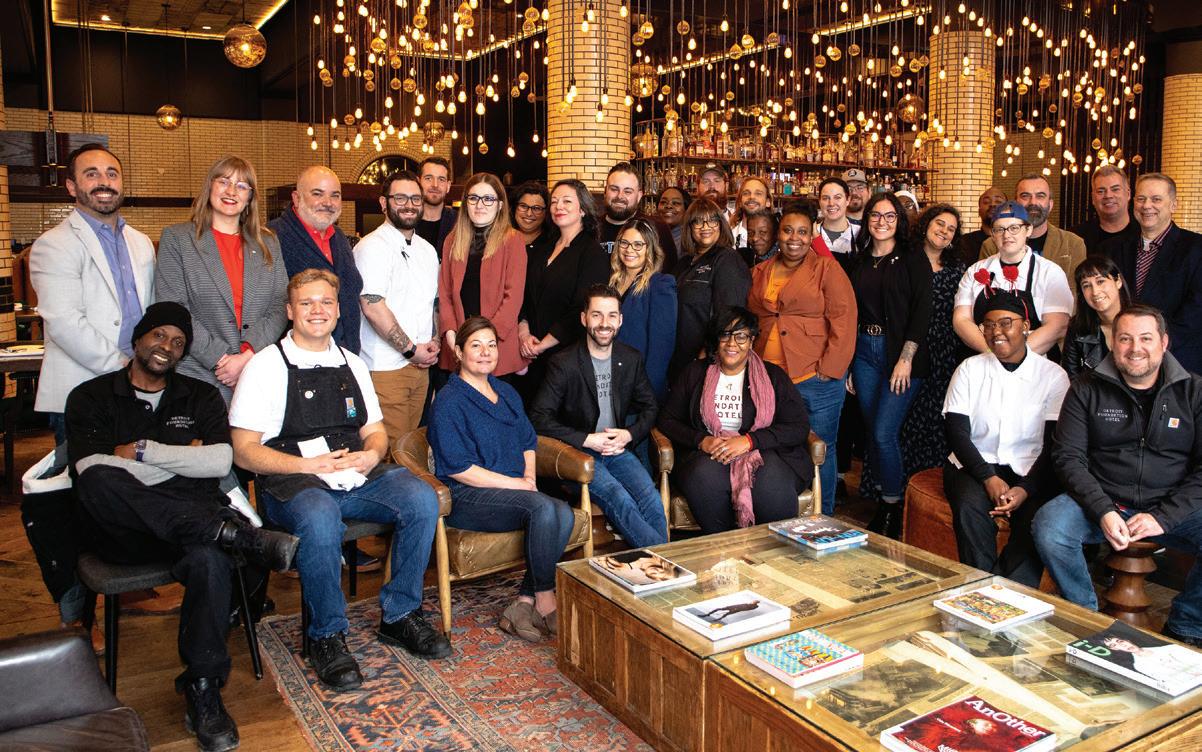



























Workplace Décor and Amenities is one of the agship categories of the DBusiness Corporate Culture Awards. Who doesn’t love coming to work at a place with comfortable lounges, full bars, and game rooms?
Near Perfect Media in Bloom eld Hills is the small-business winner in this category and the Detroit Foundation Hotel in Detroit is the winner among medium to large businesses.
“Our o ce is super clean,” explains Justin Near, president of Near Perfect Media. “Most everything is white. ere’s a lot of clean artwork. We did work with a few designers, mainly on the lobby. We also have a lounge and a full bar. We do client meetings and other gatherings in there.”
Near Perfect Media’s 6,000 square feet of o ce space also features what it calls the Culture Club, which has pinball machines, games, and other activities to help employees decompress.
“We have a kitchen and a dedicated Cry Room, which is kind of hilarious,” Near says. “It’s soundproof. You can go in there and scream if you want.”
Near Perfect Media’s sta has their own o ces and there are multiple conference rooms. Clients have been known to use the meeting spaces.
“I want to make the o ce someplace that I’d want to be,” Near says. “It’s about supporting our team so they can do their best work.”
e medium-large winner, the Detroit Foundation Hotel, the converted re station across from Huntington Place, doesn’t lack for décor and amenities for guests, but what about the 120-130 employees?
“ e overall design helps with the energy and enthusiasm when you come into the building,” says James Dannecker, general manager of the hotel.
Except for ticketed events, Dannecker says employees are “strongly encouraged” to attend community events at the hotel. Sta also is treated to curated meals from the Apparatus Room chefs every week, and wine classes are o ered.
“We do a quarterly dinner with the executive team where employees can bring a plus one,” Dannecker says. “We’ll have a free throw contest during March Madness, where the winner can get an extra paid day o . We do a lot of things to show the love and appreciation of our team.”


Leading the way in the Diversity and Inclusion category are Apex Placement & Consulting in Clawson on the small business side, and Attendant Care Cos. in Chester eld Township on the medium- to large-business side.
Jennifer Gavin is founder and CEO of the 22-strong Apex Placement, whose sta is approximately 20 percent diverse.
“It’s de nitely a speci c focus that we talk about as we’re building the team,” Gavin says. “It helps that I have some diversity on my leadership team because I think when you talk network and reach, your referrals and your candidates who are pipelined are going to be more diverse because of your leadership team.”
Interestingly, to become more diverse, Apex had to recruit a few men to its all-female team last year.
“I really do believe in having a diverse team because when you come from di erent backgrounds, you bring di erent solutions and perspectives,” Gavin says. “Not having men on the team was really a gap for us.”
Renee Burgess is human resources manager at Attendant Care Cos., which provides in-home medical care for clients all around metro Detroit. She oversees approximately 250 employees, about 60 percent of whom are non-White.
“It’s something that we focus on because we’re in quite a few counties where there’s a diverse population,” Burgess says. “We want to make sure we have a good number of diverse employees and that they’re encouraged to join and welcomed within the company.”
Atnip & Associates in Rochester, with 15 employees, is the small-business winner in the Compensation and Bene ts category. DOBI Real Estate in Birmingham, with its sta of 140 employees and agents, is the winner of the medium-large-business segment.

“We encourage a very comfortable work environment,” says Heather Atnip, owner of Atnip & Associates. “Our salaries are very competitive in the marketplace because that’s how you attract top talent. We’re also able to retain top talent by providing fully

 WORKPLACE AMENITIES
Detroit Foundation Hotel
WORKPLACE AMENITIES Near Perfect Media
DIVERSITY AND INCLUSION
Apex Placement
WORKPLACE AMENITIES
Detroit Foundation Hotel
WORKPLACE AMENITIES Near Perfect Media
DIVERSITY AND INCLUSION
Apex Placement




equipped home o ces. We o er all major bene ts o ered by other large corporations.”
e health bene ts are fully paid by the company, while the 401k program is matched at 3 percent to 5 percent.
is May, the company is planning a three-day 10th anniversary trip to the historic Grand Hotel on Mackinac Island.
Simon omas, CEO of DOBI Real Estate in Birmingham, says he believes the compensation package his company o ers is very competitive in the real estate world.
“I think we pay our sta well,” omas says. “We have great bene ts and paid time o . We do a really good job with that stu . We really care and we pay a little bit more.”
DOBI’s sta has four weeks of paid vacation, health, vision, and dental insurance, and a matching 401k program.
e real di erentiator, according to omas, is how his agents are compensated. Agents, who are independent contractors, typically pay fees to their company for services like marketing and administration.
“Our fee structure is very competitive compared to the market, but the value they get for those fees are four times what any other company o ers,” omas explains. “ ose values include the type of space they’re working in; it’s an immaculate, beautiful facility. e marketing team that bene ts them is better than any I’ve ever seen for a company of our size.
“ e training and mentorship that they get, the culture, the events, the awards that we give, the recognition that we give, the technology they have access to — any other brokerage would probably be doubling fees.”
It’s important for employees to know there’s a path for upward mobility at the company for which they work. DesignTeam Plus in Birmingham, the small business winner in the Career Advancement category, and Sachse Construction in Detroit, the medium- to large-business winner, achieve that in di erent ways.
Shari Stein, owner and founder of the ve-employee DesignTeam Plus, o ers education, training, and growth to advance workers’ careers.
“Our goal for 2024 is to grow each of our departments, which will make managers out of the people who are already here,” Stein says. “Today’s generations want to be empowered and involved in all aspects of the business. We want them to grow and not seek other jobs, because they’ll have it all here.”














To further that goal, DesignTeam Plus has a college tuition payment program, pays for team members to take licensing exams, and pays for any type of computer training they may need.
“We believe in education,” Stein says. “And we let them take the training during work time.”
At Sachse Construction, the career advancement program is more formal.
“We have individualized career development plans where a team member is kind of able to direct themselves,” says Myra Ebarb, vice president of people, perks, and empowerment at Sachse, which has 165 employees. “ ey say where their next potential role is, their intermediate role, and their ultimate role. Leadership looks at this constantly to determine the paths they can take.”
Like DesignTeam Plus, Sachse o ers training to help its sta along their chosen career path.
“Our new team members get into a rotation where they touch every part of the company,” Ebarb explains. “We’re always promoting, always making changes to our team.
“If someone moves to an area of the company and it doesn’t work out, they can always go back to their original position.”
Edward Lippincott, owner of Lippincott Real Estate Advisors in Birmingham, says the key to showing gratitude to employees lies with the employees themselves. Lippincott and his seven workers were the small-business winners in the Gratitude category.
“ e rst thing is nding the people that you mesh well with, have good personality overlaps, good energy, and intellectual curiosity,” Lippincott says. “We celebrate small and large victories, and we celebrate life milestones, like a family having a child, to let them know we care.”











Small — Assembly Ventures, Detroit


Assembly Ventures invests in, and strategically supports, the entrepreneurs and mobility companies moving the western world.
Medium-Large — Farbman Group, Southfield
Farbman Group is a real estate brokerage, with capabilities in construction, property management, development and site selection, financial services, and receivership.
Small — Near Perfect Media, Bloomfield Hills
Near Perfect Media provides comprehensive public relations and marketing solutions for corporations, professionals, and celebrities.
Medium-Large — Detroit Foundation Hotel, Detroit
A sleek and fashionable hotel in downtown Detroit, across the street from Huntington Place. Originally it was the city’s circa-1929 fire department headquarters.
Small — Apex Placement & Consulting, Clawson
Apex Placement & Consulting is a full-service sta ng and human resources provider that specializes in recruiting, sta ng, direct hire, search, temp-to-hire, and contract labor. It also o ers unique strategies and solutions for companies across Michigan, northern Ohio, and northern Indiana.
Medium-Large — Attendant Care Cos., Chesterfield Township
Attendant Care provides home health care and residential services to seniors, post-op patients, and anyone who shares the belief that there’s no place like home.
Small — Atnip & Associates, Rochester
Atnip & Associates is a personal injury law firm that works to make a di erence in its clients’ lives. Their team approach provides personalized care and support, and proactive, attentive legal representation.
Medium-Large — DOBI Real Estate, Birmingham
Founded in 2018, DOBI Real Estate embraces “The DOBI Difference,” which o ers the services needed to enable growth and gives the agent, the buyer, and the seller the best experience.
Small — DesignTeam Plus Inc., Birmingham
DesignTeam Plus was formed in 2012 as a multidisciplinary design firm that promotes collaboration and long-term relationships with clients, consultants, and municipalities.


ere’s a bell in the o ce that gets rung when a deal closes. “It’s cheesy but it’s fun,” Lippincott says.
e company, which deals exclusively with a ordable housing, runs quarter-long contests with money prizes as high as $5,000. Along with sponsoring trips to trade conferences, the rm hosts multiple events, including an annual golf outing.
Mary Jane’s Friends & Co. in Warren is the medium-large company winner in the Gratitude category. Its 105 employees tend to their clients’ marijuana-growing operations, trimming, harvesting, and making sure everything is working properly in the grow operation.
“We feel showing appreciation and recognition of accomplishment is an important part of our business,” says Sasha Sokolovskyy, founder, owner, and CEO of Mary Jane’s. “We do a lot of events like movie nights, bowling nights, and parties.”
e company conducts ra es where the prizes can range from gift cards to air fryers, hover boards, or a nished product from clients.
Like Lippincott, Mary Jane’s acknowledges life events. It also sponsors company sports teams.


Medium-Large — Sachse Construction, Detroit

“We’ve built a lounge for employees where they can hang out after a long day of work,” Sokolovskyy adds. “We basically try to make them feel like family, rather than workers.”
Sports aren’t the only endeavor that bene ts from teamwork. Just ask the folks at Mario Morrow and Associates and overall DBusiness Corporate Culture champion the Farbman Group, both in South eld.
Mario Morrow, CEO of Mario Morrow and Associates, the small business winner in the Teamwork category, says a lot goes into the teamwork at his company of eight employees.
“Because we have a small group of folks that we work very closely with, we make it comfortable for everyone and we stress collaboration a lot,” Morrow says. “ is whole collaboration thing makes people work harder and have a personal investment.
“We have a lot of team-building activities and sta meetings where we evaluate each other’s projects. We do employee engagement on a regular basis.
Chris Thomas, co-founder and partner at Assembly Ventures in Detroit, is this year’s DBusiness Corporate Culture Awards Mentor Champion.
Thomas is someone who takes mentoring and being mentored “very seriously” — and has since his school days, his time as a communications o cer in the U.S. Army during the war in Iraq, and as an entrepreneur.
“I think I’ve been really lucky throughout my life — in school, in the military, and in business — to have had the pleasure, and in some cases the luck, of having great mentors who have truly shaped me and made me a much better person than I’d otherwise be,” Thomas says. “It’s important to have both at every stage of your life. There’s always something for us to learn. There’s always someone better than us at something we aspire to be better at.”
Thomas says he’s currently mentoring a handful of people, but he encourages others in his company to take on the mentor role.
“One hundred percent, and not only within our organization and in our portfolio companies, but within the community,” he says. “Little things like taking the time to read to a child during their lunch hour makes such a big di erence.
“I’m a big believer in if you’re going to move the world, you start in your home, your city, your state, your country. The old adage is all politics is local. All impact is local. The only way we’re going to build the community and neighborhoods, the places that we care about, and be the very best versions of ourselves, is to be engaged.”
Mentoring can take many di erent forms, Thomas says. He recently had a phone call with a student at MIT who had heard him speak at an event and just wanted some career advice.
“We had a great discussion about what she was doing, and I gave her some things to think about,” he says.
He says it would be di cult to count the number of people he has mentored throughout the years, but “I’ve had the pleasure of mentoring some incredible people and I’m so proud of what they’re doing in life. Those opportunities have been very special.”
In addition to the colleagues he’s currently mentoring, he says he mentors his two little boys every day, and “they teach me some things.”
— Tim KeenanFounded in 1991, Sachse Construction has built millions of square feet of commercial, retail, multifamily, and institutional space in the United States, Canada, and Puerto Rico.
Small — Lippincott Real Estate Advisors, Birmingham Lippincott provides advisory and brokerage services to owners and buyers of project-based workforce housing and self-storage facilities nationwide.
Large — Mary Jane’s Friends & Co., Warren
Mary Jane’s Friends & Co. is Michigan’s first legal, licensed, and insured cannabis maintenance company o ering full service to assist growers with their growing needs including plant trimming, O3 generation, and UV-c sterilization.
Small — Mario Morrow and Associates, Southfield
Mario Morrow and Associates o ers marketing, crisis management, media training, law, public relations, graphic design, polling, economic development, and economic analysis that helps clients influence change, while enhancing their reputation and furthering their business objectives.
Medium-Large — Farbman Group, Southfield
Farbman Group is a real estate brokerage with capabilities in construction, property management, development and site selection, financial services, and receivership.
Small — Pophouse, Detroit
Pophouse is a Detroit-based design studio focused on creating informed, curated, and human-centric spaces.
Large — Kapnik Insurance Group, Troy
Kapnik is an independent insurance brokerage o ering a comprehensive suite of insurance solutions. It works closely with clients to help them make important and informed decisions when it comes to protection and their future.
Small — Emerge Consulting, Royal Oak
Emerge Consulting partners with businesses to develop longterm workforce strategies by helping them attract, develop, and retain talent.
Medium-Large — Glover Agency, Plymouth Township
Je Glover has been Michigan’s No. 1 Realtor for nearly 10 years. He empowers his agents and has created a collaborative, cooperative team. Glover also stresses the importance of building and maintaining client relationships.
Small — Sentinal Benefits & Financial Group, Troy Wilshire Benefits Group helps is clients make appropriate business decisions regarding their employee benefit plans.
Medium-Large — Northwestern Mutual, Troy
Northwestern Mutual has helped families and businesses across Troy reach their financial goals for many years. Its version of financial planning brings the right insurance and investment strategies together.











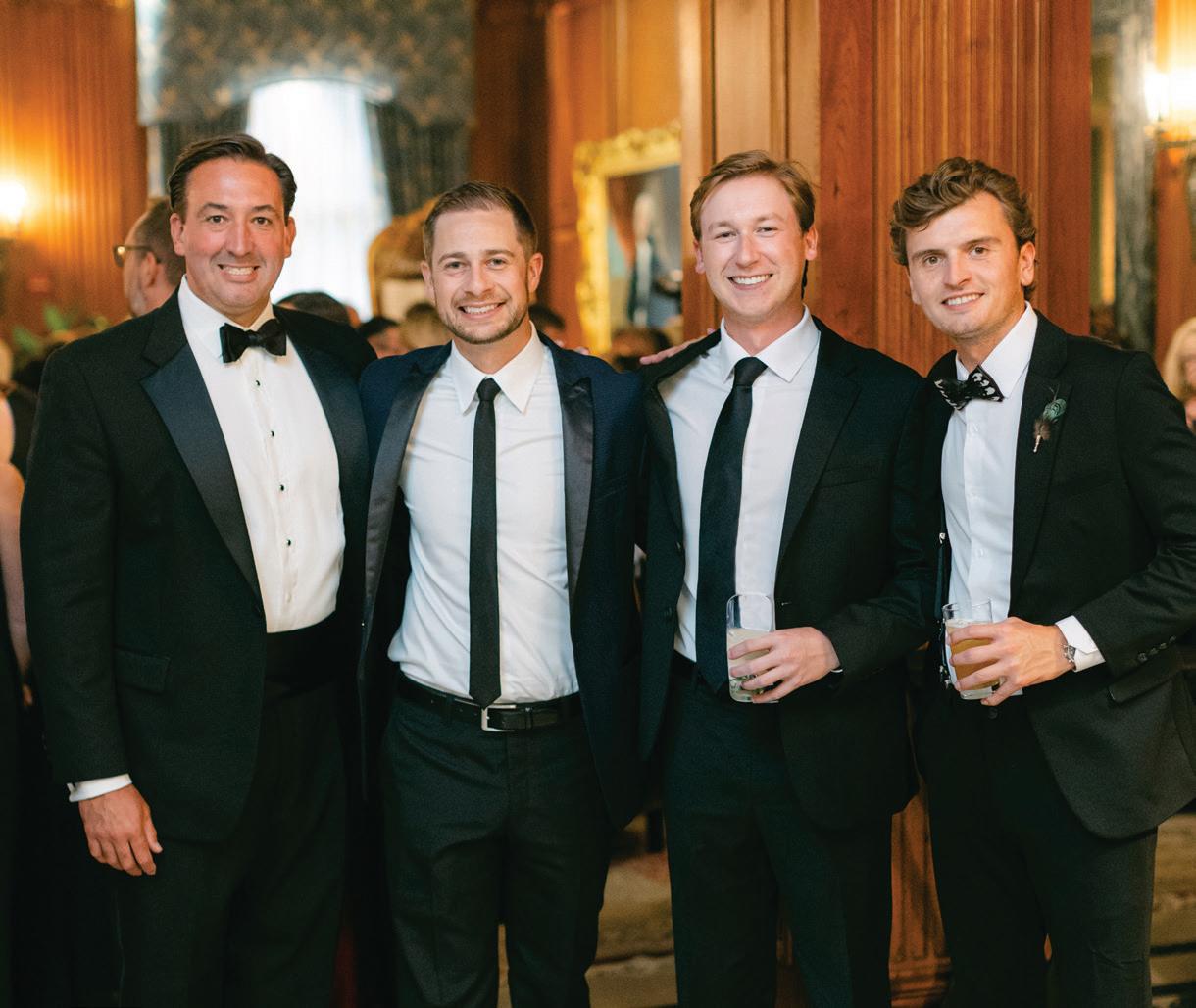
We’ll call impromptu meetings just to get everyone’s input into a problem or a situation.”
Morrow adds that he keeps the company refrigerator stocked with everyone’s favorite soft drinks and lunch items.
“All these things contribute to a comfortable work environment, and keep people happy, and that helps the teamwork.”
Is it more di cult to encourage teamwork in a larger enterprise? Not according to Andy Gutman, president of South eld-based Farbman Group, which has around 200 employees — 115 full time and more than 85 contract workers.
“It really starts with the Farbman family themselves,” Gutman says. “( e late) Burt Farbman was very big into teamwork. One of the things he used to do when he was running the company was to sit down and talk to every nalist for any position we had open in the company.
“He made sure they understood when they were coming aboard that we were all about teamwork, have a very at org chart, and that there’s no one more important than anyone else. at’s part of our culture, and when I took over the day-to-day running of the company, I made a promise that I would do the same.”
Farbman Group also conducts regular meetings at the department and company level to get input from everyone on the team.
“We’re really big on fostering a sense of we, not me,” Gutman says.




working on, and we really wanted everyone to appropriately manage their own schedules,” explains Jennifer Janus, president of Pophouse Design.
As a result, there’s no mandated schedule for Pophouse employees. ere is, however, an all-team meeting every ursday morning.
“Tuesdays and ursdays are when the majority of our team is in the o ce,” Janus says. “Even though it’s not a mandate, people come in on those days because they like working together.
“We really haven’t had any turnover. Once the pandemic hit and they found out they could work from home and could do things like pick their kids up from school, taking that away is really hard.”
Kapnik Insurance in Troy is the medium-large company Workplace Flexibility winner.
Leadership is a key element in the success of any operation, be it a sports team or a business. Joe Bamberger, founder and managing partner at Emerge Consulting in Royal Oak, and Je Glover, owner of Glover Agency Realtors, have di erent leadership styles but ended up winning the Workplace Leadership category in the DBusiness Corporate Culture Awards.
Bamberger’s Emerge Consulting, with seven employees, took the prize on the small-business side.
“I’m a big believer in leadership by example,” Glover says. “I still go on appointments and meet with buyers and sellers. I can share information with our agents because I’m in the trenches with them.”
Apart from himself, Glover says his leadership team has more than 25 years of combined experience and is willing to meet with agents personally to add insight and knowledge.
“We’re big on one-on-one coaching,” Glover says. “ at doesn’t happen at a lot of real estate o ces.”
Sentinel Bene ts and Financial Group in Troy is the small-business winner in the Community Engagement category, with 30 employees.
“We have a volunteering program,” says Lisa Hamill, people and culture business partner at the company’s Massachusetts headquarters. “We run giving campaigns for charities and causes, and a matching gift program. We give employees time o to volunteer. We always make sure we’re giving back to the communities where we have local o ces.”


Like most companies, workplace exibility at Pophouse Design in Detroit was utilized more often during the COVID-19 pandemic. Pophouse and its 25 employees are the small-business winners in the Workplace Flexibility category.



“After the pandemic, we came back to the o ce pretty quickly because of the projects we were
“We just trust people to be adults and take care of their own business and know what’s right for our clients and the business in general,” Bamberger says. “I don’t have a micromanaging style. I tend to explain what we’re looking for and the why behind it, and I trust people to be able to take responsibility on their own and ask for help when they need it. I give support and advice along the way when it’s needed.
“ ere are examples when it works perfectly, (but at times) a more hands-on approach is necessary.”

Glover’s 75 employees made his rm the medium-large business Leadership winner.
Hamill says the speci c causes and organizations that bene t from Sentinal’s philanthropy are driven by the people in the company’s local o ces. She also says community engagement is something that starts the moment someone new comes to the company.
“We talk about it with new hires and there’s always a community engagement update during company calls,” she explains. “We send emails with updates, and we have a website that tracks volunteer hours.”
Northwest Mutual, along Wilshire Drive in Troy, was the Community Engagement winner for medium-large businesses.
 Lippincott.at a black tei event at DAC
Lippincott.at a black tei event at DAC

Major corporate and charitable events can take a year or more to organize, manage, and execute, and as soon as one anniversary or celebration is done, the planning begins for the next one.
But what if there isn’t sufficient time to organize a major milestone, especially a one-of-a-kind culinary extravaganza and fundraiser that requires coordinating with 40 of metro Detroit’s top chefs, sommeliers, restaurant owners, general managers, and maître ds?
For anyone planning a major event in a compressed time frame, consider the execution of Legends of the Stove, a tribute to metro Detroit’s culinary heritage that was held on Jan. 15 at the Detroit Athletic Club. The only hitch was pulling together the entire production in 10 weeks during the holiday season.
Apart from reaching out, confirming, and coordinating with the culinary masters on the dinner and dessert selections, and how and where offerings such as beef Wellington would be prepared on-site, the reception was being filmed as part of “Detroit: The City of Chefs.” The documentary will debut this fall on Detroit Public Television, and coincide with a red carpet premiere.
To get started, on Oct. 30, Chef Keith Famie, a longtime filmmaker and executive producer and director of Visionalist Entertainment Productions in Wixom, sent an email to Master Chef Shawn Loving and General Manager Charles J. Chambers of the Detroit Athletic Club.
“I would like to create a dinner event/invite only, which would include outside guests as well as DAC members,” Famie wrote. “These guests would all be seen on camera as we would film the service. We would invite several historical chefs to be part of the menu preparation, and we would film this as part of the story of current iconic chefs and those from the past.
“I wanted to give the DAC the first opportunity to be the location featured. I see the event being of benefit to a few local charities highlighting how the
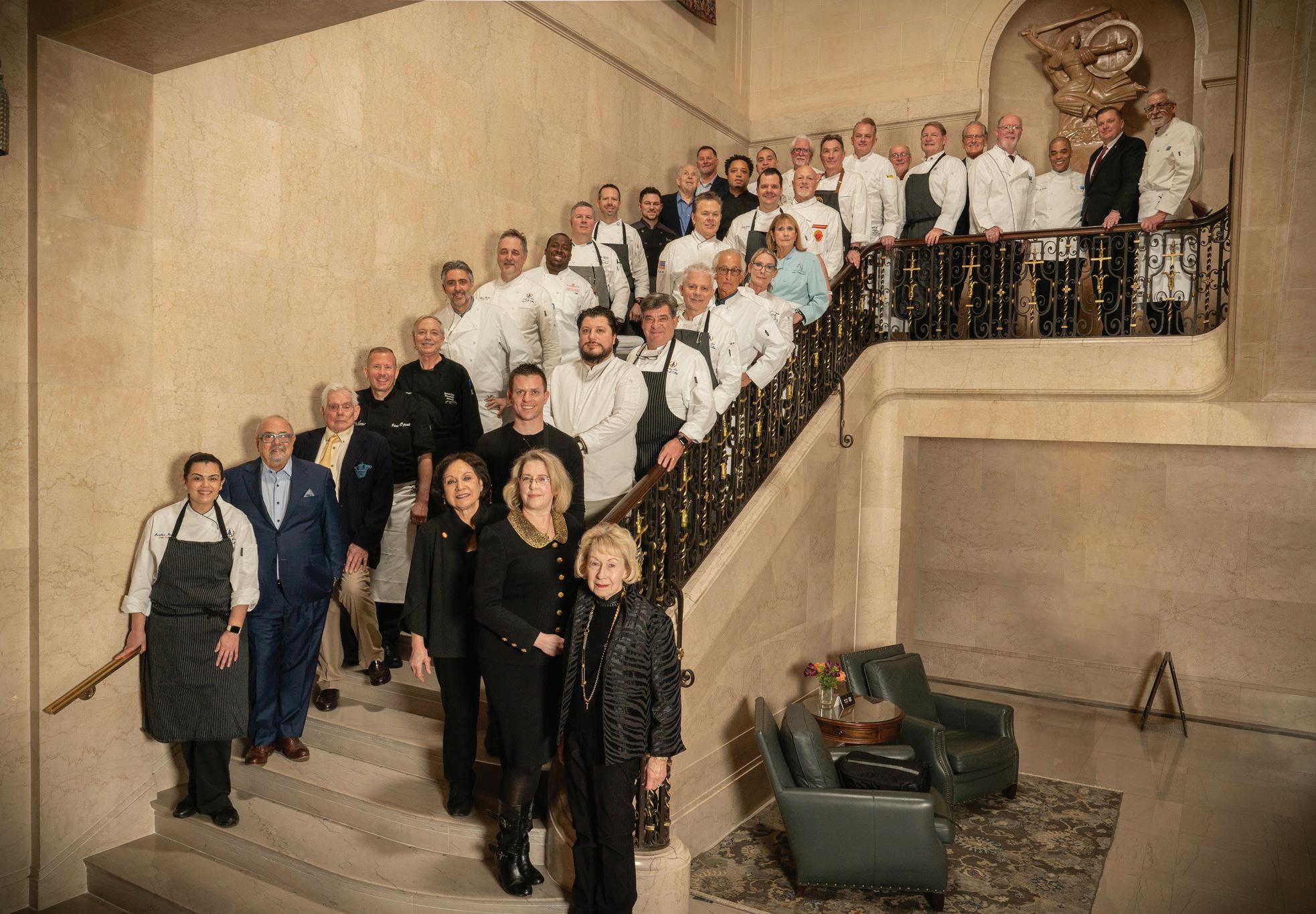
hospitality industry and chef community come together to help support social issues, and I see this taking place in February sometime. Clearly this would be a historical evening in so many ways.”
While Loving and Chambers, along with the DAC board of directors, were open to hosting the event in the club’s main dining room and the neighboring Pontchartrain and Georgian rooms, one problem immediately emerged. The second-floor kitchen that services the hospitality rooms was being shut down in mid-February for a complete rebuild that wouldn’t be completed until September.
Another potential challenge was the success of the Detroit Lions. After the team won its first playoff game at Ford Field — the DAC offers a pre-game buffet to several hundred members and their guests before each home game — the next contest could have been held on the same Monday night as Legends of the Stove.
“When I received the email to move forward, I said, ‘Wow, I’m staring at Thanksgiving with hundreds of turkeys and dinners to prepare for our members, their families, and their guests, plus carry-out dinners,” says Loving, who served as the event’s culinary host. “And there was a different volume of food service for Christmas.
“I was concerned if we could prepare for Legends of the Stove with the same intensity and focus we’re known for, and deliver it all professionally. So, with my team, (I) put a plan together and I reached out (in early November) and let all the individual contacts know I was 150 percent in, but let me get through Thanksgiving first. And as far as the Lions, we were fortunate the second playoff game was held that Sunday. I mean, really fortunate.”
To mark Detroit’s historical role in the culinary world, Famie, a former chef at Chez Raphael, Les Auteurs, and Forte, wanted to celebrate the present, but also the past — not 20 years or 30 years, but three centuries of comestible history.
From medieval times, chefs and their kitchen brigades played a vital role in the success of the nobility. Following the French Revolution in 1799, the culinary teams of royalty and monarchs cast off what was a rigid system of trade guilds to bring forward fine-dining restaurants.
Still, the hierarchical structure of tightly operated kitchens remained in place. In fact, the double-breasted chef’s jacket is a lasting vestige of culinary leaders, evoking the venerable roots of military ranks.
Long shut off from dining rooms, the emblematic curtain to the back of the house finally opened locally a half century ago, led by Master Chef Milos Cihelka of the Detroit Athletic Club, who got his start at the London Chop House and, following his stint at the DAC, helmed the former Golden Mushroom in Southfield.
In 1972, Cihelka founded the Michigan Chefs de Cuisine Association, an organization that serves to lift the public profile of culinary teams while raising money for charities.
“When you look at iconic culinary figures in our region like Chef Milos, Chef Douglas Grech (Pontchartrain Hotel, The Great Dane, Restaurant Duglass), and Joe Muer Jr. (Joe Muer Restaurants), they set the plateau for all the chefs and culinary teams that followed,” says Chef Marcus Haight, the longtime executive chef at The Lark and today a professor in culinary arts at Schoolcraft College in Livonia.
To ensure that knowledge was passed on to the next generation, Haight and his fellow faculty members made it a point to include students in the preparation of the cuisine for Legends of the Stove.
Limited to 150 guests, the selections included Lobster Bisque with Chive Crème Fraiche, Duck Pie with Cherrywood Smoked Salmon, Pan-Seared Potato Gnocchi, Venison Epigrams, Sauteed Lake Perch Goujons, Red Spiced Wagyu Short Rib, and more.
Haight’s dish was Rack of Lamb Genghis Khan; in keeping with the charitable nature of the event, the




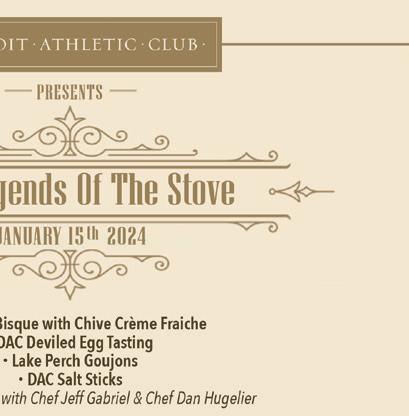



meat was donated by Fairway Packing Co. in Detroit. His students helped prepare the marinade, while undergraduates from Chef Brian Polcyn’s (Pike Street, Five Lakes Grill, Forest Grill) class did the butchering.
“When I was at the event, I was struck by the overall positive attitude,” Haight says. “I realized it was a snapshot in time to see everyone together who contributed to the restaurants in this town. It was a moment we’ll likely never see again. We’re fortunate to work in the Motor City, which brought so much here from around the world.”
Starting in the 1920s, as local automakers and suppliers expanded beyond North America, executives and managers were introduced to new cuisines, wines, and spirits. At the same time, the region has long attracted people from nearly every country, given Detroit was founded in 1701 and is the oldest city in the Midwest.
Pair that with Henry Ford’s decision in 1914 to double workers’ wages to $5 a day. e unprecedented pay hike, which was largely matched by other automakers and suppliers, attracted thousands of workers from every corner of the globe.
As Famie’s lmmaking team notes, metro Detroit is “one of the world’s most culturally diverse and unique places to dine.” It also “paved the way for

The culinary and wine team for Legends of the Stove gather on the staircase of the Detroit Athletic Club, far left. The menu included Venison Epigrams with Sauce Grand Veneur by Chef Paul Grosz, who is joined by Margaret Fleming. Below is a selection of hors d’oeuvres. Chef Luciano DelSignore prepared and served Melanzane alla Parmigianain in the DAC’s Georgian Room.


Detroit to introduce a diverse range of dining destinations rivaled only by New York or Paris.”
“I really saw Legends of the Stove as a way to celebrate the past, honor the present, and nurture the future,” Famie says. “ e event wasn’t easy by any stretch, but it was rewarding. We raised money for Gilda’s Club Metro Detroit, Rising Stars Academy, and the Rainbow Connection.”
To help defray costs, the participating restaurants and culinary institutes, along with Chef Source in Canton Township, Great Lakes Wine & Spirits in Highland Park, Carmela Foods in Fraser, and the Toni A. Wisne Foundation in Novi, among others, donated nearly everything.
Taking it all in, Famie, who has directed and produced dozens of lms, and once appeared on a season of “Survivor,” summed up the highlights.
“Our executive producers — Tony and Mary Schimizzi, John and Carole Kulhavi, and Roger and Mary Kreager — played an important role, and we had students participate from the culinary programs at Schoolcraft College, Oakland Community College, and Macomb Community College. When I look back, we might have been crazy to pull everything together in 10 weeks, but it was certainly worth celebrating the present and enlightening the future.”

South Lyon native Vinny Pyle brokers yachts throughout Florida, but he’s also found success operating complementary businesses in the Great Lakes State.
BY TOM MURRAYVinny Pyle remembers his bold decision as if it was yesterday. He was 14 years old, and he and his 12-year-old brother were visiting their father in Florida.
“My dad lived in Fort Lauderdale in a place called Seven Isles, and he had his boat behind the house,” Pyle recalls. “It was a little 15-foot Boston Whaler, and he always pushed us to use the boat because he wanted us to be really good and safe boat handlers.”
One afternoon when the boys were alone at the house, they were hungry and had a sudden craving for something special. “We wanted some conch chowder and cracked conch for lunch,” Pyle says.
Not a big deal — until you consider where the boys went to enjoy their meal. “Bimini, in the Bahamas, which is about 47 nautical miles from Fort Lauderdale. But it was a really flat day on the water, and my brother and I were thinking, ‘We can do this,’ ” Pyle shares.
The boys made the round trip in about four hours. “There was no GPS back then,” Pyle reports. “We thought our dad was going to be really excited and proud of us.”
Let’s just say the boys miscalculated their father’s reaction to their adventure.
“We got grounded for a month,” Pyle says. “He said it was the stupidest thing we ever did in our lives. Boats were a lot more temperamental back then, and he told us we could have been adrift at sea.”
Fast-forward 30 years later and it’s apparent Pyle has rebounded from his dad’s punishment. These days, he spends countless hours on the water, and in various boats. And when he’s not?
“I buy and sell boats,” Pyle says. “In fact, I was just at a show and we had a 2020 112-foot boat that was listed at $15 million, and I also had 100-footer listed for $8 million.”
Pyle has clearly come a long way from when he was growing up in South Lyon in the early 1980s.


“It was a great little neighborhood, pretty much out in the burbs and very rural,” he recalls. “I was lucky enough to have 25 or 30 homes in my actual subdivision, and out of all those homes there were 12 kids my age that I’m still really good friends with. We were a gang of dirt-bikers, and we had a track in our neighborhood. It was a great, great time to grow up there. I actually still remember my old address, on Deer Creek Drive.”
Pyle has his grandparents to thank for his love for the water.
“They had a cabin in Northport, just north of Traverse City,” he says. “My Uncle Ben taught me how to sail on Lake Michigan at a young age. That’s one of my first memories of actually being on the water and sailing.”
Pyle also caught the entrepreneurial bug at a very early age.
“My parents separated and my mom got remarried,” he says. “At that time, my stepfather started a lighting company in Detroit from scratch. He also had a handful of T-Mobile stores in the Detroit area. My father started as a restaurateur in Florida, and then got into the marine industry and owned commercial fishing boats and a boat yard, and became very successful.”
Pyle’s passion for boating and being near the water increased with every visit to Florida to spend time with his father. “I was blessed enough to be able to
come down here during the summers and Christmas breaks,” he says. “We would go to the Bahamas for a month at a time.”
Pyle got plenty of opportunities to operate a variety of boats, allowing him to gain confidence, as well as his father’s trust.
“When I was 16, my dad and stepmom wanted to go to down to South Beach for New Year’s Eve,” Pyle remembers. “They always wanted to have their car and boat there. So my dad said, ‘Vinny, you’ve gotten proficient enough to take the boat; we’ll meet you there.’ And that was the first time I drove a big boat by myself.”
It was also the moment Pyle’s career path came into sharp focus. “That’s when it actually clicked that, OK, I can do this,” he says. “So instead of mowing lawns, I was actually running boats for some of our neighbors, and these were really substantial vessels.”
As much as Pyle loved Florida and his life on the water, he continued to split time between his parents, returning to Michigan every fall to attend high school.
“I went to Orchard Lake Saint Mary’s from freshman to junior year,” he says. “I spent my senior year at

South Lyon High. From there, I chose Arizona State University, because I actually wanted to be on my own in college, and far away from both parents. I was still blessed to be able to come back to both places whenever I wanted, so that was a great thing.”
As soon as Pyle graduated from Arizona State, there was no question where he was headed.
“I moved straight back down to Florida, and got my big yacht captain’s license in 2006,” he says. “ at allowed me to run yachts from 200 tons to 500 tons, depending on where the boat was registered. In easy terms, it means I could operate yachts up to 150 feet long. On most of those big yachts, I did week-long charters for owners and guests. ese trips were as far south as the southern Caribbean and as far north as New England.”
After 10 years of criss-crossing the high seas, Pyle was ready to adjust his lifestyle. “I wanted to go into the brokerage end of the industry,” he says. “ e main reason was my growing family. I wanted to be present and land-based.”
As Pyle tapered down his hours helming charters, he connected with an experienced yacht broker who’d been in the business for decades. “Mark Peck started Peck Yachts in 2016,” Pyle explains. “He was in the brokerage industry for over 30 years when he went on his own. I was his rst hire, so it was perfect timing,” Pyle says.
“I helped start that rm, and one of the main things Mark and I saw eye-to-eye on was the need to branch out into the Great Lakes. It de nitely was an underrepresented area for larger yachts. ere are quite a few in the Great Lakes, and there’s also a lot of clients that have the means to buy these larger boats, even if they keep them down in Florida.”
e business boost in Michigan means Pyle spends a lot of time in his home state.
“I’m ying up (there) in 10 days to go look at a boat in Grand Haven that’s put away for the winter,” he says. “We’ll also visit the Bay Harbor Boat Show, the Detroit Boat Show, and the Grosse Pointe Yacht Club. And I’ll also throw an event at the Detroit Yacht Club for my clients in the area.”
It’s important to point out that when Pyle added the yacht brokering business to his portfolio, he never came close to entirely giving up the time he spent on the water organizing and helming various boating excursions. ere’s a very simple reason why.
“I like to work,” he says. “Besides, a lot of the chartering is done on Saturday and Sunday, so I can still have a great Monday through Friday job at Peck Yachts. at’s one of the great things I love about being a yacht broker; I make my own schedule, and it’s something you never really retire from.”
As if he wasn’t already busy enough, Pyle couldn’t help himself when he recognized yet another business opportunity.
“A few years back, the boom of day charters was still in its infancy,” he says. “But I started to see an uptick in the demand for four- to six-hour day charters, which was never really a thing before, for events
like bachelorette parties and destination birthdays. So my wife and I decided to go out on a limb and start Carpe Diem Charters. We bought a 40-foot power catamaran and started doing business, and it really caught re.”
To say the least.
“I do believe it was a ‘God winks’ moment,” Pyle adds. “We now have a eet of six vessels, ranging from 25 to 140 feet, and have booked over a thousand day charters, all which have attained ve-star reviews. And due to the success of Carpe Diem Charters, we decided to take on another endeavor with a few partners — Sunfun Charters, which focuses on larger groups of up to 50 guests. We’re pretty cemented in the day charter industry now.”
e 43-year-old Pyle lives in Fort Lauderdale, where his career was rst hatched on that ambitious conch lunch excursion to Bimini as a teenager. But his ties to Michigan are stronger than ever.
“ e biggest thing I took away from growing up in Michigan is just the honesty,” he says. “Our whole rm lives by that. We’re not a one-stop shop and we never talk to you again; it’s more about cultivating relationships with our clients than it is just pushing berglass and selling boats. And our get-up-and-get-to-work mentality is a factor, too. Just the grind, which was instilled in me at such an early age.”
ere are important reasons other than selling boats that frequently bring Pyle back to his roots.
“My mom lives in Brighton, and her six brothers and sisters live in metro Detroit. And my little sister lives in South Lyon in the house we grew up in. So I love going back there. It’s just so great to have nice people around you that say hi to each other and open doors. And there’s so much cool culture there, I just love it.”
Vinne Pyle, a broker with Peck Yachts in Fort Lauderdale, also works out of Michigan. In addition, he runs Carpe Diem Charters and Sunfun Charters.
Pyle takes a wistful pause.
“ e last time I was in Michigan, I went to Mario’s for dinner in Midtown Detroit, where my grandparents got engaged. As we were leaving, I looked at my wife and I said, ‘You know, I could move back.’ And she said, ‘You’re saying it now because it’s August.’ And she was right. But Detroit holds a special place in my heart, and it will forever.”



Metropolitan Baking Co. in Hamtramck continues to expand locally while focusing on national growth.
BY TIM KEENAN | JOSH SCOTTMetropolitan Baking Co. in Hamtramck is a bakery that would make automotive pioneer Henry Ford proud.
After being baked hundreds at a time in huge ovens, buns, rolls, and loaves of bread travel hundreds of feet along conveyors to automated packaging areas. Employees then fill boxes and racks with wrapped finished products.
If digital mapping systems can’t provide directions to what is an almost 80-year-old, family-run enterprise, the smell of baking bread will do the trick. The company’s client roster includes sports venues, restaurants, schools, universities, hospitals, grocery stores, fast food franchises, and even 7-Eleven stores.
More specifically, Metropolitan Baking Co., led by third-generation baker George Kordas, supplies Ford Field, Comerica Park, Little Caesars Arena, Corewell Health’s Beaumont hospitals, and almost all the Coney Island restaurants in Detroit.
“You’ve got to be able to handle that chili,” Kordas says. “You don’t want the bun falling apart on you. We formulated that product to sit on the steam table. It can’t get mushy. That’s kind of been our flagship on the bun and roll line.”
The bakery also supplies the University of Michigan, Michigan State University, and more than 300 school districts throughout Michigan.
“If you’re eating within a couple hundred miles of here on the food service side, restaurants, schools, or institutions, there’s a good chance at least one of our products is going to be in that location,” Kordas says. He adds the company is “busting at the seams.”
To alleviate that situation, Metropolitan Baking Co. currently is expanding. It’s adding 35,000 square feet to its current 110,000-square-foot production facility. The expansion, which started in October, is expected to cost $15 million by the time it’s completed this summer.
“It’s fully family funded,” Kordas says. “No debt.”
The company also declined to take advantage of city-offered tax abatements over the years, preferring to contribute fully to Hamtramck’s fiscal stability.
The latest expansion is the company’s fifth or sixth, according to Kordas, who notes that at one
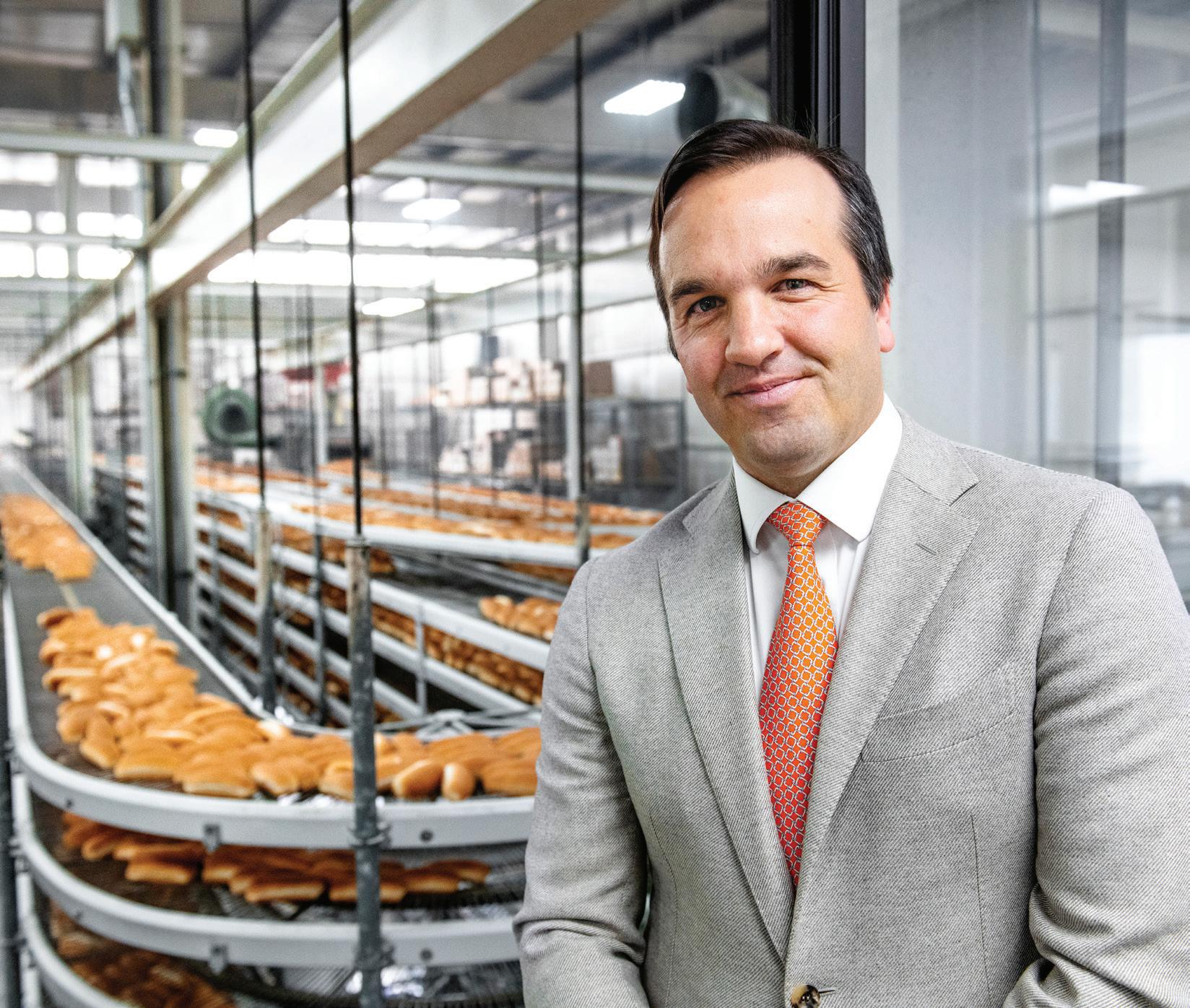
point there were more than 30 homes around the bakery that were purchased to facilitate the growing business.
“Believe me, that last home on the block became very expensive,” he says with a chuckle.
The latest addition will increase Metropolitan Baking’s bun and roll production by 35 to 40 percent, which will allow it to add to its customer base.
“(The addition) will have a whole new bun and roll line, with brand-new, fully automated, state-of-the-art equipment,” Kordas says. “We have a few national accounts that are waiting for us to complete the addition.”
Metropolitan Baking Co. already bakes buns for the New York Yankees, Cleveland’s Guardians and Browns, and Cincinnati’s Reds and Bengals.
To meet the needs of these and other customers, Kordas and his 110 employees produce 110 million packages of bread, rolls, and buns per year, using some 600,000 pounds of flour per week. Flour is shipped by rail from North Dakota to a Detroit terminal. From there, it’s transferred into 50,000-pound tanker trucks, which deliver flour to the Hamtramck bakery where it’s blown into one of four 140,000-pound-capacity silos two times daily.
Between 110 and 125 independent distributors sell and deliver more than 200 different finished products that range from several varieties of bread to hot dog and hamburger buns, and dinner rolls, among others.
In addition to supplying the food service industry, the company sells its products — under the Kordas label — in Walmart and Sam’s Club stores, between 400 and 500 independent grocery stores, and Michigan’s 7-Eleven stores.
“That’s a small percent of our business, maybe 10 percent,” Kordas says. “We tend to be behind the scenes.”
A key factor in Metropolitan Baking Co.’s success is maintaining quality as well as high-volume output.
“It’s critical,” Kordas explains. “It’s about the equipment we’re purchasing. We have some dividers that separate ingredients to a fraction of an ounce. It’s the individuals that we employ; their expertise is phenomenal. We have bakers who
have been here for 30 to 40 years. We have quality control specialists who are renowned in the industry.”
He also says the recipes and quality control are vital.
“The formula is critical, and we follow our formulas to a T,” Kordas says. “It’s not like plastic injection molding. This is a live product. You have yeast in the product. It has to feed on the sugar in the proof box. If you don’t have the right amount of yeast, the product won’t rise. When you’re running that high of volume, you’re always going to have scrap.”
Forgotten Harvest and the Salvation Army are the beneficiaries of some of the company’s less-than-perfect products.
Metropolitan Baking Co. doesn’t stop at serving local markets, schools, and sports stadiums. It has contracts to supply Five Guys, Red Robin, and Chick-fil-A restaurants in Michigan, all of which require their bread products to look and taste a certain way.
“You have to meet certain specifications,” Kordas says. “They’ll have technicians in here before the account starts for four months, non-stop. They want to make sure that product is formulated right, and looks exactly like the product in every other location. We’ll produce tests upon tests to prove to them that we can produce that product.”
To service customers like Caesar’s Palace on the Las Vegas Strip, more than 480 Bob Evans locations, and brioche buns for
Bobby Flay’s restaurants, Metropolitan Baking has adopted a blast-freezing strategy.
“My team, working with other titans of the industry, has figured out how to produce product in cases, blast-freeze those products, put them on refrigerated trucks, and send them to gross distribution centers,” Kordas explains. “Now we can canvass the entire country with our products, which has given us a whole new customer base.”
At first glance, freezing bread products would seem to work against a restaurant serving the highest-quality product. Not so, Kordas says.
“If you do it right, you’re going to blast-freeze that product within an hour of its being made, and you’re going to have no idea it was frozen once that product is thawed,” he explains. “More customers than not are going that route and these are major, national restaurant chains. And that’s based on keeping the product uniform.”
Metropolitan Baking also works with other regional bakers to help expansion efforts for itself and its partners.
“We all make different products,” Kordas says. “We buy some of theirs and they buy some of ours, so we’re not stepping on anyone’s toes. In addition, when you’re courting some of these national accounts, you need to be third-party authenticated, and fully safety-certified and monitored.”
30


Source: Metropolitan Baking Co.
BATTER UP

 Metropolitan Baking Co.’s products start as 1,600-pound mixtures before being cut, shaped, baked, cooled, and packaged along the company’s production line.
1,600 pounds: Weight of one pre-baked batch of bread, rolls, and buns
million: Pounds of flour used per year
110 million: Packages of bread, rolls, and buns produced per year
$15 million: Cost of ongoing 35,000-squarefoot expansion project
Metropolitan Baking Co.’s products start as 1,600-pound mixtures before being cut, shaped, baked, cooled, and packaged along the company’s production line.
1,600 pounds: Weight of one pre-baked batch of bread, rolls, and buns
million: Pounds of flour used per year
110 million: Packages of bread, rolls, and buns produced per year
$15 million: Cost of ongoing 35,000-squarefoot expansion project

Part of that certification involves conducting regular recall drills, even though the Hamtramck operation has never had a recall.
The company’s devotion to quality goes back to its founding in 1945, when Kordas’ grandfather, originally a Ford car salesman who was very successful in the Greek community, invested in a little Hamtramck bakery that occupied two homes with a garage in back.
“It wasn’t automated,” Kordas says. “They were making product by hand, but he always wanted to sell to the wholesale market.”
Early customers were other area wholesale bakers and some smaller restaurants around town.
Kordas’ father, Jim, took over the business in the mid- to late ’60s and began to automate the processes. He also started the company’s expansion movement.
Kordas, who was a member of the DBusiness 30 in Their Thirties class of 2016, started working in the family business the summer after his sophomore year in high school and was employed every summer from that time until his graduation from the University of Colorado with a degree in economics in 2005.
“It was about a week after graduation and I was hanging out with my buddies having the time of my life and my dad said, ‘Time to get to work. You’re in the mixing room at 1:30 a.m.’ That was an aggressive transition.”
Despite that conversation, Kordas says he’s always wanted to work for the company. “I realized I had a fantastic opportunity that not many individuals have, and decided it was something I wanted to focus on — to be someone who can really grow the business and take it to whole new levels.”

BREAKING BREAD
Hot dog buns and bread are air-cooled on a belt that goes around the bakery (left and below left). Kordas breaks into a fresh loaf

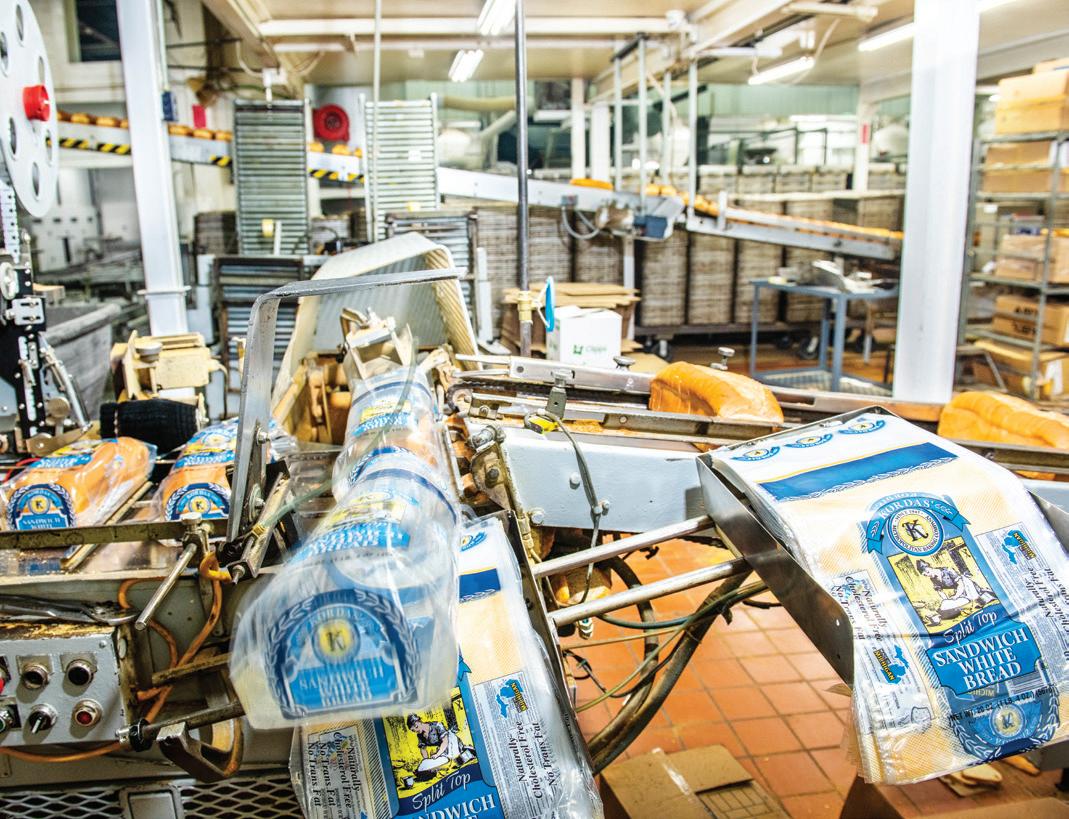







Credited with filing 36 patents, Okemos native Donald B. Keck and two other scientists brought forward fiber optic cables in 1970 that paved the way for the internet.
BY NORM SINCLAIRBy his own admission, Donald B. Keck was subpar as a student at Okemos High School, east of Lansing, graduating in the middle of his small 58-member senior class in 1958.
Young Keck’s high school guidance counselor suggested to his parents that they send him to a vocational school to learn a trade, because she didn’t think he had a future in a professional job. “He wasn’t going to be a professional. He just didn’t look like he could make it in any professional occupation,” she told them.
His parents, William and Zelda Keck, were both educators. William earned bachelor’s and master’s degrees from Michigan State University, and received a doctorate degree from the University of Michigan. He spent several years as an instructor in the physics department at Michigan State University. Zelda, a MSU graduate, taught literature in high school.
“I didn’t want to do a lot of homework and all that sort of stuff, so the teachers didn’t rate me very highly,” Keck recalls of his time at Okemos High School.
He was, however, passionate about boating and water skiing — a sport he and his friends introduced to the Grand River, which the government had previously designated a polluted waterway.
“It was no longer polluted, it was calm water that went a long way, and we had the river to ourselves,” he says.
With little boat traffic on the river, Keck and his pals eventually became so proficient at water skiing, they entertained passersby on the river banks and regularly staged water ski shows that included salmon skiing, barefoot skiing, and skiing in three-person pyramids.
In 1959, his boating exploits brought him dubious recognition in a news story in the Lansing State Journal. Keck was driving a speedboat on Lake Lansing on a Sunday afternoon when his boat collided with another speedboat, driven by another 18-yearold boy. Six teens, including Keck, were pulled from the water by nearby fishermen and taken to local

Telecom and networking companies previously depended on copper wiring to transmit data. Now they could extend their reach to millions of customers. Industries as disparate as television electronics and medicine underwent amazing advances with fiber optics.
hospitals for treatment of cuts, bruises, and other minor injuries.
“The accident was part of my growing up years, where I wasn’t paying as much attention to academe as I should have and was out water skiing and doing crazy things,” he says. “It was one of those learning experiences. The prosecuting attorney for the county had me before him and gave me a lecture, and thank heavens nobody was hurt.”
Eleven years later, in 1970, Keck and two scientists at Corning Inc. in New York were internationally feted for their breakthrough work on fiber optic cables that not only revolutionized communication, but was also a precursor to one of the most significant achievements of the 21st century: the development of the internet.
The trio perfected a process of transmitting sound in the form of light traveling at high speed along fibers of silica glass.
In experiments he conducted, Keck discovered that lining optic cables first with titanium and later on with germanium prevented light from escaping the glass. His discovery allowed unlimited amounts of data to be distributed instantaneously through cables.
The once-middling high school student achieved a feat that had eluded Alexander Graham Bell in the 1880s, and numerous other scientists through the years.
Surgeons were able to perform robotic surgery using fibers connected to a camera to look inside a patient’s body and operate by inserting fibers in tiny incisions, which avoided invasive open surgery on a patient.
Keck, now 83, and his wife, Ruth, live in Estero, Fla. He’s a guest lecturer at the University of South Florida’s Institute for Advanced Discovery and Innovation, and was a vice president and executive director of research when he retired from Corning in 2002.
The inventor says his transformation from high school cut-up to scientific scholar began when he enrolled at Michigan State University, where he applied his grandfather’s advice — put your nose to the grindstone — and hit the books.
“The transistor was just invented, and semiconductors were a burgeoning industry, so I registered for electrical engineering,” he says. “My dad said, ‘Think physics; it’s a better field.’ So I took his advice and went into physics. Math was a good subject for me, but science and physics were even easier. It just seems to make so much sense and was straightforward, so I picked it up fairly easily.”
Keck excelled at Michigan State, earning bachelor’s and master’s degrees in physics in 1962 and 1964, respectively. His doctoral research for a Ph.D. three years later was on molecular spectroscopy — the measurement of interactions between electromagnetic waves and matter.
He met and married Ruth while he was at MSU.
ey’re the parents of two children, Lynne and Brian, and celebrated their 58th wedding anniversary last July.
Keck had o ers from more than half a dozen companies, including IBM. en a headhunter from Corning, who happened to be a Michigan State graduate, suggested he visit the company in New York.
“My notion all along was I wanted to do something that was useful, and at that time when you graduated from the physics department the assumption was you were going to teach physics and continue in academe,” Keck says. “ at wasn’t my notion.”
After accepting an o er for a salaried position in 1968, Keck found himself working on the company’s nascent ber optic project with two other scientists, Robert D. Maurer and Peter C. Schultz. A decade later, they helped propel Corning into the world’s largest manufacturer of re ned optical ber.
Keck says by 2002, ber was being installed in the telecom network worldwide at a rate of about one kilometer per second 24/7.



“By 2005, we were installing ber around the world at 14 to 15 kilometers a second,” says Keck, who continued to advance ber optics. “In 2020, we were at about 7 billion kilometers installed around the world. I expect it’s about 8 billion kilometers by now. It’s a lot of fun to watch.”
Keck credits his parents for nurturing his aptitude for science. Both were voracious readers, a trait they instilled in him.
As early as rst grade, he remembers someone asking him what he wanted to be when he grew up. “I said I was going to be a geophysicist, and they didn’t know that I knew the word, let alone what a geophysicist was,” he chuckles.
While he was in high school, his father opened a consulting and manufacturing company, designing instruments to detect groundwater and to monitor wells. Young Keck worked for his dad in the summer, gaining invaluable experience making instruments.
His indoctrination into science continued when his father converted the basement of their home into a chemistry lab and an electronics shop. “I watched him do experiments, working on projects, soldering





things together, and so I began picking up some of those same sorts of things,” Keck recalls.
When he was in the sixth grade, he built a better motor for the electric train set he received at Christmas. His dad diagrammed the motor and its parts, and young Keck produced a battery-powered motor that plugged into the electric train’s transformer. While in high school, he built a tachometer that he installed in his boat.
He says his parents also encouraged him to take things apart, to see how they worked. Whenever something broke around the house, he watched his dad take it apart and x it. After a while, if his father wasn’t available, his mother recruited her son to x a co ee pot or a toaster or some appliance that wouldn’t work.
“ e mantra in our family was, ‘Don’t buy something if you can make it.’ So, the workshop was constantly being used to make things, x things, or whatever,” he says.
Keck describes his father as an excellent teacher who exposed him at an early age to esoteric concepts like Sir Isaac Newton’s theories. “He and I would talk and he’d pose problems and then help me through to a solution,” he says. “It was a rich environment to train, to mentor, a budding scientist. It was perfectly natural that I was going to gravitate into some eld of science.”
During his time at Corning, Keck was credited with ling 36 patents and authored more than 150 papers on optical bers and ber components.
Due to his work, Michigan State University named him a Distinguished Alumnus. He also served for several years as an advisory board member of MSU’s College of Natural Science, where he once attended classes.
Keck was inducted into the National Inventors Hall of Fame in 1993, and that same year he was elected a member of the National Academy of Engineering. In 2000, President Bill Clinton awarded Keck, Maurer, and Schultz the National Medal of Technology, the nation’s highest honor for innovators.
“ eir invention has enabled the telecommunications revolution, rapidly transformed our society, the way we work, learn and live — and our expectations for the future. It is the basis for one of the largest, most dynamic industries in the world today,” the citation read.
Keck says he sometimes has mixed feelings re ecting on his accomplishments.
The development of high-speed fiber optic cables has transformed multiple industries and helped usher in the internet.
“ e world has certainly changed because of something we had a hand in,” he says. “I often lament that somehow, as a society, we haven’t gured out how to use it (the internet) to its best, with all the di culties that seem to be cropping up in our culture. And sometimes I wonder, did we really do something wonderful, or what?”
He says in the nal analysis, he’s proud of the work he did with Maurer and Schultz. “We gave (society) the capability that helped us all grow, and we helped the world grow closer together, and that is all very good and gratifying,” he says.
The importance of quality assurance in navigating and growing the EV sector.
BY KEITH BUCKLEYFor more than 100 years, OEMs have designed, assembled, and produced internal combustion engine vehicles. As cars, trucks, and SUVs have evolved and become more complex, OEMs have increasingly focused on ensuring quality, and have actively outsourced this specialty quality assurance function.
Quality assurance is the critical process that ensures vehicles meet speci ed quality standards before reaching the public market; it plays a key role in every stage of a vehicle’s production life cycle, from design and development to manufacturing and testing.
All quality assurance processes seek to identify and contain problems, determine root causes, and mitigate future issues.
EV manufacturers and startups are innovating quickly to meet consumer demand for better performance, range, and reliability. Unfortunately, this fast pace is challenging OEMs to scale EV production and delivery to align with market needs, while ensuring that nished vehicles meet the same quality standards as internal combustion engine (ICE) vehicles.
Despite EVs being “younger” than ICE vehicles, consumers expect the same quality from providers. Each OEM must balance obtaining available market share against the speed, cost, time, and human and physical resources needed to implement their EV strategy.
Regardless of consumer demand or technological innovations, EVs will not succeed as a long-term option without a robust, proven quality assurance process. But why is the process for EVs so di erent from ICE vehicles?
It starts with the fact that EVs have more in common with a standard iPhone than a traditional gas-powered vehicle. Besides having fewer components than ICE vehicles, EVs have deep electrical and software complexities, requiring a di erent level of aptitude from manufacturers, especially around lithium batteries and associated electric drive systems.
Additionally, the manufacturing process for battery cells and battery pack assemblies is highly automated and complex. Yield rates on new battery
technologies and new facilities are typically in the 60 percent to 70 percent range.
Having quality controls is critical for the quality and performance of batteries, and having a qualied provider that has the capability to supplement and support the OEM during launch is essential to success and keeping the supply chain moving.
is requirement is playing out in real time as an unusually cold winter across the nation is revealing how much extreme low temperatures reduce EV battery performance in terms of range and time required to charge.
A wide range of temperature tests must be conducted to determine speci c limitations, provide quality assurance specialists with accurate data, and ensure EVs can function optimally in extreme climates. Working with EVs requires a signi cant new level of skill and talent to ensure quality in the safest possible way. Technicians must be highly trained to handle the high voltages and currents of lithium-ion batteries.
technology, new chemistries (LFP), and solid-state batteries all planned for future EV models.
ese new battery technologies require a learning process in the rst years of production, which can impact both yield rates and scrap rates.
e way EVs are serviced also will evolve, as most dealerships aren’t prepared to conduct on-site repairs that are increasingly focused on electronic components and software issues. A broad-based quality assurance industry focused on the needs of EVs will be essential to managing these issues and enabling future growth.
e auto industry’s operational planning and deep-industry knowledge can be leveraged to build the foundations of EV quality assurance. Nonetheless, it is vital that providers invest in training, equipment, and safety systems to ensure the highest quality of every component and vehicle. Diligence is required in all aspects of an automobile’s production life cycle and for the future of the EV landscape.
contact with the same tool during an EV battery inspection or rework could trigger a thermal issue, a
While accidental contact with a tool on an ICE vehicle could result in a single part being replaced, a cosmetic issue, or no problem at all, unintentional contact with the same tool during an EV battery inspection or rework could trigger a thermal issue, a re, or serious bodily harm.
e stakes couldn’t be higher. Beyond the obvious need for driver and passenger safety, EV manuface class action lawsuits. Issues like battery perforwith other subsequent issues that could severely
e stakes couldn’t be higher. Beyond the obvious need for driver and passenger safety, EV manufacturers are just as likely as ICE manufacturers to face class action lawsuits. Issues like battery performance can lead to a perceived loss of value, along with other subsequent issues that could severely slow industry growth.

In the absence of voluminous data on EV performance, quality assurance must ll the void to identify critical de ciencies. While quality labor talent continues to be developed, labor constraints may require that OEMs rely heavily on quality assurance providers to ll critical gaps caused by these constraints.
In the absence of voluminous data on EV performance, quality assurance must ll the void to idencontinues to be developed, labor constraints may require that OEMs rely heavily on quality assur-
e rapid pace of EV technology innovation is unlikely to slow down soon. e industry is currently focused on battery performance, with lithium-ion



6.14.2024
WESTIN BOOK CADILLAC
SPONSORED BY: EARLY BIRD TICKETS AVAILABLE NOW!


PATRICK GLORIA
The Detroit Arsenal held its senior leaders New Year’s reception on Jan. 6 at The War Memorial in Grosse Pointe Farms. The U.S. Army event was hosted by Brig. Gen. Michael B. Lalor, commanding general of the U.S. Army Tank-automotive and Armaments Command (TACOM in Warren), and other military personnel. Guests enjoyed hors d‘oeuvres, beverages, and a program.
1. Zach Rich, Col. Freeman Bonnette, Lynn Krystofik, Dan Clore
2. Marla and James Rickard
3. Dominique Couture, Maj. Darren Rioux
4. Valde Garcia, Mel Brown, Mike Stone
5. Rep. John James, Brig. Gen. Michael Lalor

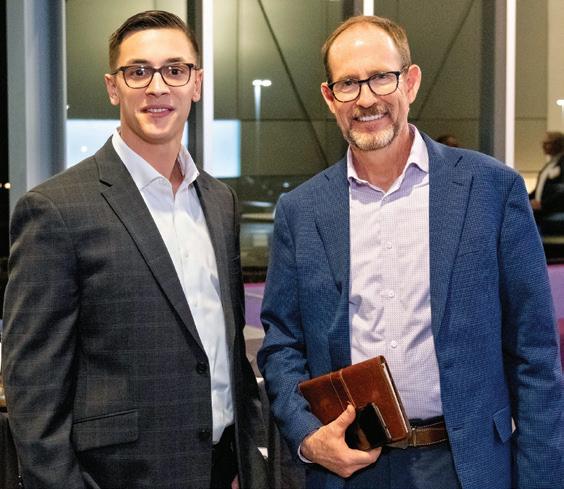





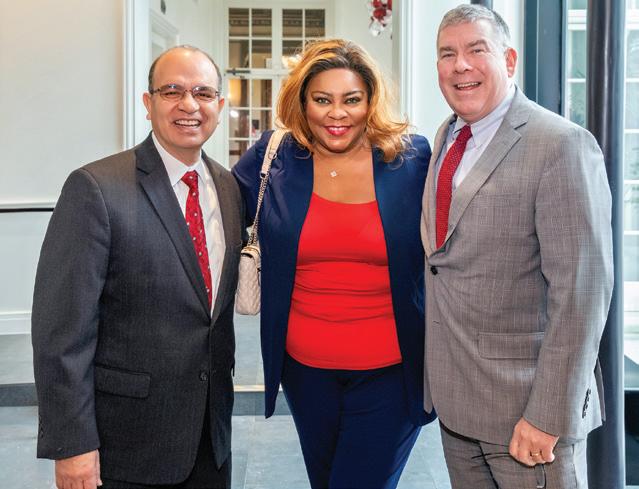
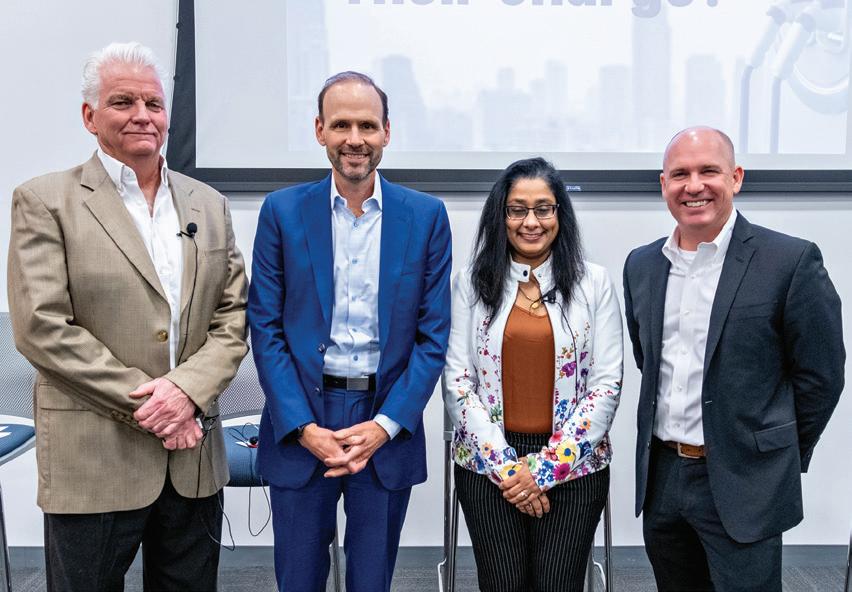

PATRICK GLORIA
As part of a documentary film to be called “Detroit: The City of Chefs” — to be released later this year on Detroit Public Television by Keith Famie, executive producer and director, and his team at Visionalist Entertainment Productions in Wixom — The Legends of the Stove took place at the Detroit Athletic Club on Jan. 15. The historic gathering of iconic chefs, restauranteurs, and front-of-the-house legends from metro Detroit featured some 40 culinary masters. The evening, which included gourmet cuisine and wine, benefited Gilda’s Club Metro Detroit, Rising Stars Academy, and the Rainbow Collection.
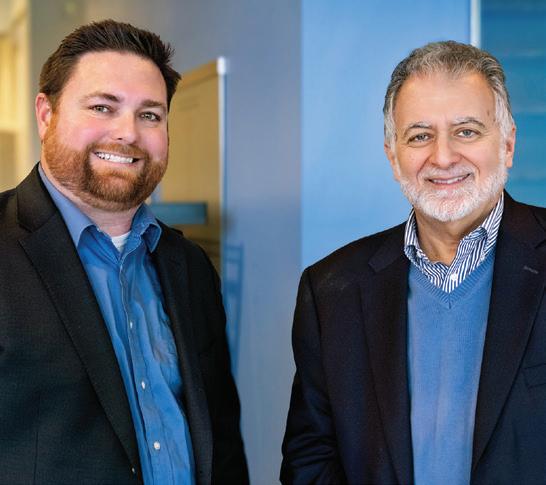
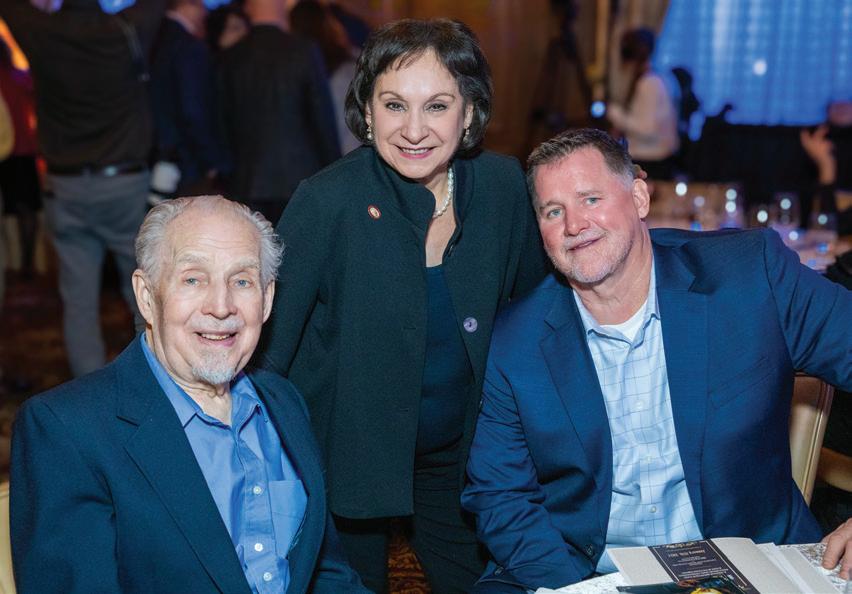


PATRICK GLORIA
ACG Detroit hosted a panel discussion, “Are EVs Losing Their Charge,” on Jan. 11 at Walsh College in Troy. The event featured experts from the auto industry discussing the opportunities and challenges that lie ahead when it comes to EV technology. It was moderated by Clayton Vanderpool, senior vice president – Native American gaming division for PNC Bank. Speakers included Steve Wybo, senior managing director for Riveron; Pina Bennett, marketing director for DTE; and Mark Heusel, equity member and international practice group chair for the Dickinson Wright law firm.
6. Joe Marek, John Klehm, Jeremy Ventrone
7. Mark Fischer, Mark Heusel, Pina Bennett, Clayton Vanderpool
8. Forrest Manning, Todd Deindoerfer
9. Diane Forrest, Ryan Keating, Je Chappell
10. Marty Rathsburg, Mark Cory


 11. Chef Milo Cihelka, Madeline Tri on, Steve Allen
12. Chef Tricia Holt, Chef Terence Tarver
13. Chef Jim Oppat, Chef Mike Osinski
14. Je Baldwin, Chef Michael Baldwin, Chef Gabriella Baldwin
11. Chef Milo Cihelka, Madeline Tri on, Steve Allen
12. Chef Tricia Holt, Chef Terence Tarver
13. Chef Jim Oppat, Chef Mike Osinski
14. Je Baldwin, Chef Michael Baldwin, Chef Gabriella Baldwin


March 8, 8 a.m. - 11 a.m. | unitedwaysem.org/womenofinfluence
United Way for Southeastern Michigan’s eighth annual Women of Influence Summit is set for Friday, March 8, at Motor City Casino.

Each year, the United Way celebrates International Women’s Day and raises funds for early childhood education during this event, hosted by United Way for Southeastern Michigan’s Women United philanthropic group. Since its inception in 2017, the Women of Influence Summit has raised more than $1 million to support children, families, and caregivers in Macomb, Oakland, Washtenaw, and Wayne counties. Don’t miss your chance to join regional business owners, executives, thought leaders, and corporate and community partners for a morning of reflection, networking, and interesting discussion!
April 20, 6 p.m. - 11:30 p.m. | foundation.ascension.org/michigan/providence-foundation/events/friends-ball

The Ascension Providence Foundation presents the 2024 Friends’ Ball on Saturday, April 20, at the Suburban Collection Showplace in Novi. This special event benefits women’s heart health at Ascension Providence Hospital and its outpatient clinics. Proceeds will help the hospital and medical team care for women with cardiovascular disease and those at risk. Heart disease ranks as the No. 1 killer of American women; it’s responsible for more deaths in women than all types of cancer combined. The goal is to ensure that advanced diagnostics and treatment therapies are available to help all women in the community achieve and maintain cardiovascular health, regardless of their ability to pay. At the event, which will be emceed by Carolyn Clifford of WXYZ-TV, The Caduceus Society Physicians of the Year, Dr. Lakshmi and Dr. Vinaya Gavini, and Dr. Michael Jacobs, as ell as other important community members will be recognized. For tickets and sponsorship opportunities, please email specialevents@ascension.org.
April 25, 4 p.m. - 10 p.m. | bbbs.org
The NFL Draft is coming to Detroit in April! It’s a once-in-a-lifetime event, and an opportunity to engage and entertain your clients, colleagues, family, and friends. Join Big Brothers Big Sisters (BBBS) of Southeast Michigan at The Big Draft Watch Party on Thursday, April 25, at Comerica Park — your home base for the draft in Detroit!

From logistics like parking, food, drinks, and indoor shelter to games, athlete appearances, and ballpark tours, The Big Draft Watch Party is an incredible, turnkey opportunity located just steps from the heart of all the action in Campus Martius. Casual yet sophisticated, this event allows sponsors to focus on their guests, not details, while supporting the BBBS mission: to create and support one-to-one mentoring relationships to ignite the power and promise of youth. In the first-ever draft in Detroit, BBBS of Southeast Michigan wants you to join their team! Sign up today at bbbssoutheastmi.org.
March 21, 3:30 p.m. - 8 p.m. | acg.org/detroit/events
Watch the first round of March Madness with ACG Detroit members on Thursday, March 21, at The Dow. Guests will have the opportunity to participate in a friendly March Madness bracket competition for a chance to win various prizes throughout the event. Food and drinks (limited) are included with registration.
April 20/21, 9 p.m. - 2 a.m. | wolverinebar.org/programs/barristers-ball

It’s time for Detroit’s most highly anticipated party with a purpose! The Wolverine Bar Association and Wolverine Bar Foundation will host its annual signature black-tie charity fundraising gala, the 62nd Annual Barristers’ Ball, on Saturday, April 20, at the Marriott Renaissance Center. Every year, more than 1,500 leaders from the legal, business, education, civic, and political communities attend the Barristers’ Ball to celebrate the best of the southeastern Michigan community.

This year’s theme is “Motown: Back Down Memory Lane.” It celebrates and restores, for one night, that fabled entertainment and business district of old Detroit. The 62nd Annual Barristers’ Ball will begin with a Motown-style paparazzi red carpet experience, followed by the President’s Reception. The event features live musical entertainment from a special guest, a silent auction, networking, flavorful hors d’oeuvres, and signature cocktails powered by Hennessy and Moet. Proceeds from the annual Barristers’ Ball support the Wolverine Bar Association’s and Wolverine Bar Foundation’s student externships, internships, scholarships, education courses, and mentoring, as well as legal information and representation for the underrepresented. For tickets and sponsorship opportunities, visit wolverinebar.org/programs/barristers-ball/.
April 25, 7 p.m. - 11 p.m. | givebutter.com/detroitdraftparty
The 15th Annual Detroit Draft Party, hosted by the NFL Alumni Association Detroit Chapter, is a premier event celebrating the induction of new NFL talent while supporting a great cause. Held at The Norwood, this much-anticipated gala brings together local and national celebrities, sports enthusiasts, and NFL alumni for an unforgettable evening of camaraderie and excitement. As the draft unfolds in real time, attendees will have the unique opportunity to meet and greet former NFL players, share in the thrill of the draft picks, and contribute to the NFL Alumni Association Detroit Chapter Student Athlete Scholarship Fund. This event isn’t just a party; it’s a chance to be at the heart of the action in Detroit, network with like-minded individuals, and support the future of young athletes. For more information, visit givebutter.com/detroitdraftparty.

PATRICK GLORIA
The Halfway to Mackinac Party took place on Jan. 19 at the Bayview Yacht Club in Detroit to celebrate the halfway point to the 100th Bayview Mackinac Race Presented by National Fleet Services. The race is scheduled to begin on July 20 in Port Huron. As part of the event, a dinner featuring some of Mackinac Island’s favorite dishes was prepared by chefs from the Bayview Yacht Club, the Pink Pony restaurant in the Chippewa Hotel on Mackinac Island, and Mission Point Resort. Guests also enjoyed live music from the band Slowfoot.
1. Daniel Mercier, Barara Grossi
2. Mary Stanford, Eric Szuch, Commodore Lynn Kotrvicki
3. Karen Eger, Shawn McCrindle, Kim Gmeiner
4. Peter and Melissa Wenzler
5. Blake Stackpoole, Torrey and Harold Stackpoole

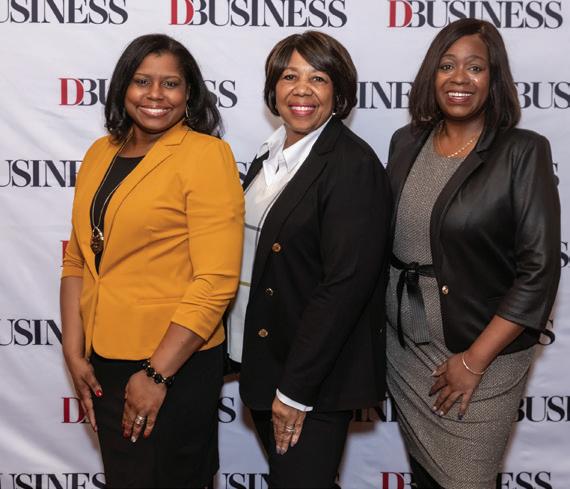


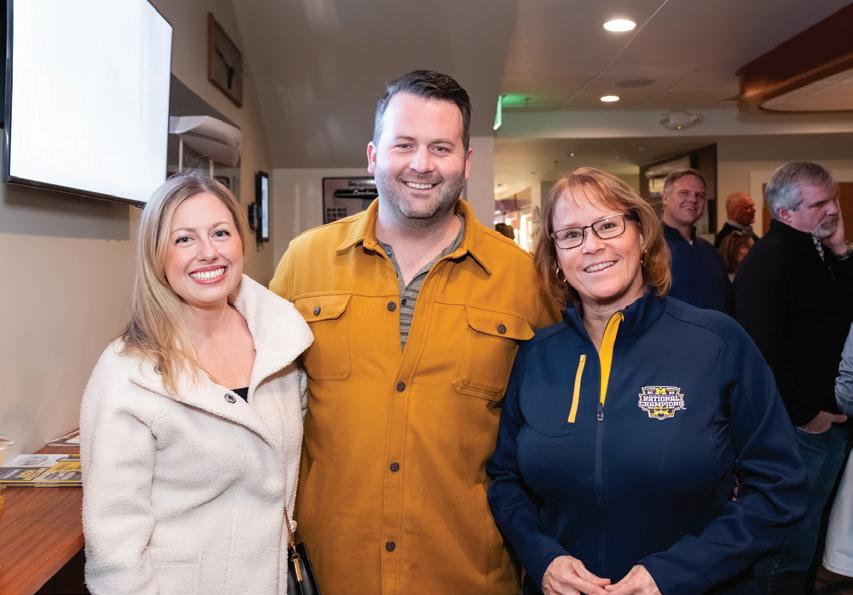

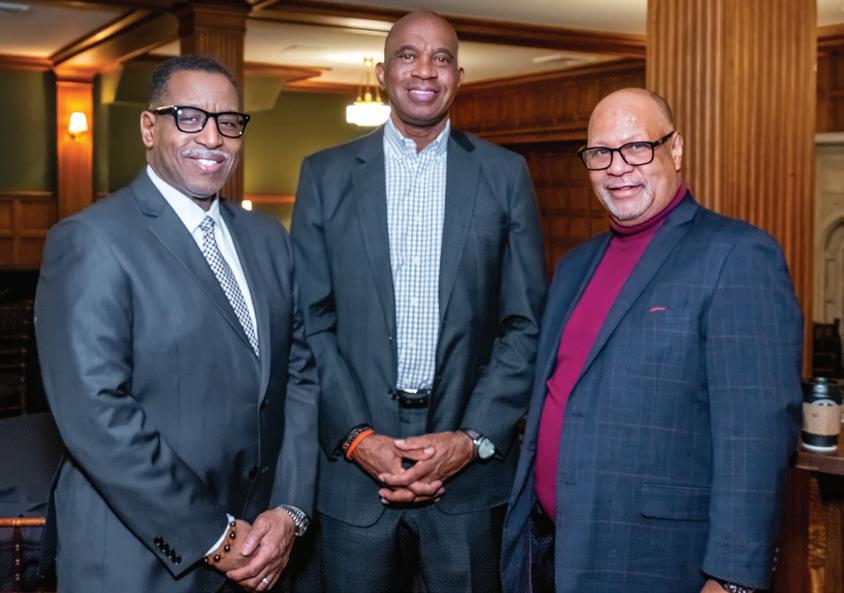
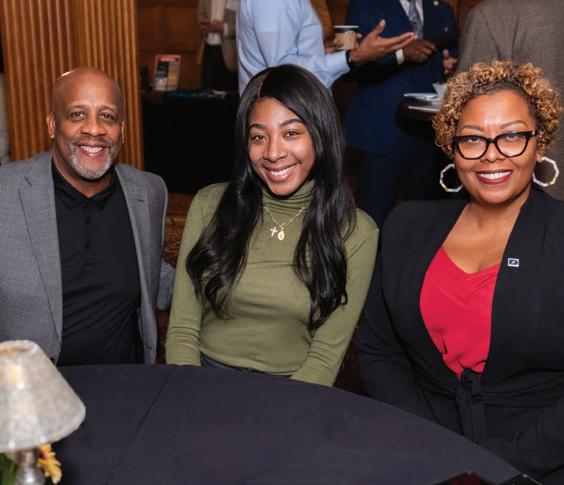
PATRICK GLORIA
The Bates Street Society Dinner took place Feb. 10 at The Community House in Birmingham. The society, created in 2015, recognized The Community House’s annual “pillars of vibrancy” in business, education, culture, health and wellness, and philanthropy. This year’s dinner honorees included Michael Bickers, Dr. Perry Greene, Paul Gross, Diana Lewis, Glenda Lewis, Dr. Charles Main, Salvador Salort-Pons, Michelle Saroki, and the late Florine Mark.
11. Sarah Pobocik, Michael Milkiewicz, Mara Farmer
12. Jared Gross, Nancy Gross, Paul Gross, Adam Gross
13. Glenda Lewis, Diana Lewis
14. Alexandra May, Brenda Rosenberg, Salvador Salort-Pons
15. Michelle and Victor Saroki




PATRICK GLORIA
The DBusiness Breakfast Series Scaling Minority Owned Businesses event took place on Jan. 25 at the Gem Theatre in downtown Detroit. The event was co-hosted by the Detroit Black Chamber of Commerce and featured breakfast and networking before a panel discussion led by Ken Harris, president and CEO of the National Business League. The panelists included Rachael Allen, founder and CEO of Operations School | OPSIDIA; Reginald Dozier, president and CEO of Lewis & Munday; Natalie King, founder and CEO of Dunamis Clean Energy Partners; and Derron Sanders, founder and CEO of SG Cos. Sponsors included ACG Detroit, Alan C. Young & Associates, the Detroit Pistons, EO, PNC Bank, and Lewis & Munday.
6. Chad Rhodes, Donovan White, Dave Logan
7. Reginald Dozier, Bernard White, Harold Clay
8. Dichondra Johnson, Tish Lewis-Turner, Soummer Crawford
9. Derrick Beele, Madison King, Trinette Jordan 10. Ken Harris, Natalie King

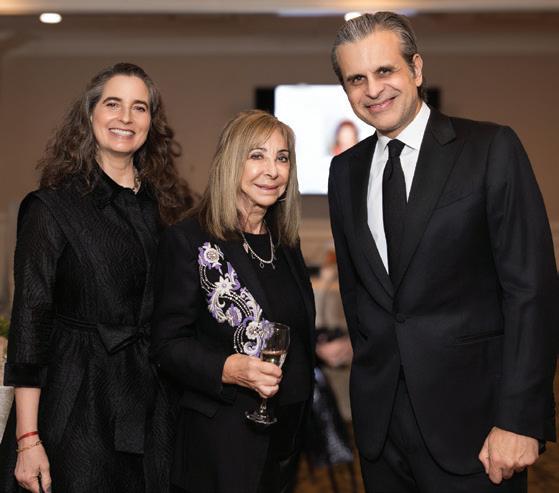
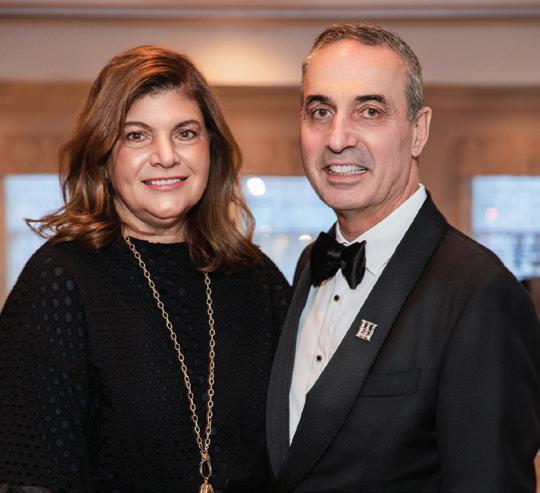


TimothyMasterswasonlyfifteenwhenhestumbledacrossthemutilatedcorpse ofPeggyHettrickinafieldonhiswaytoschool.Almostassoonasthepoliceset eyesonhim,theyweresurehewasthekiller—evenwithnothingbutacollection ofgorydrawingshe’dcreatedasateenagehorrorfanasevidence. Fortenyearstheyhoundedhim,until—withthehelpofanastoundingamount ofmisconduct—theyfinallysucceededinputtinghimbehindbars.
In DrawntoInjustice,Timrecountshisjourneytoexoneratehimselfforacrime hedidn’tcommitand,intheprocess,laysbarethecorruptionthatenabledthe criminaljusticesystemtorailroadaninnocentman.

ReprisedEdition
TheWrongfulConvictionof TimothyMasters










The community lender large enough to provide big options for your business and small enough to know you by name.






You know your business, the area, its challenges, and its advantages. So do we. Partner with the community lender with a history of crafting custom lending solutions and expertise in commercial real estate, working capital, and equipment financing.










Masters was only fifteen when he stumbled across a mutilated corpse lying in a field. For ten years, the police hounded him until – with the help of an astounding amount of misconduct – they finally succeeded in putting him behind bars. Drawn to Injustice recounts his journey to exonerate himself for a crime he didn’t commit.
available at momentumbooks.com

Michigan | Illinois | Wisconsin adviacu.org/commercialloans
$4,050,000 Financed Manufactured Home Community in Caro, MI



 Timothy
Timothy
BAKER COLLEGE
CADILLAC, JACKSON, MUSKEGON, OWOSSO, ROYAL OAK | Private, Not-for-profit
Undergrad programs: Bachelor’s and 4+1 accelerated BBA/MBA degree programs including accounting, business administration, finance, human resource management, information technology, logistics, marketing, and more. Over 40 programs are offered 100 percent online. Transfer students can apply at no cost. baker.edu; 855-487-7888
CLEARY UNIVERSITY
DETROIT, HOWELL | Private
Undergrad programs: BBA programs including business communication, business ethics, business management, corporate accounting, corporate finance, digital marketing, human resource management, nonprofit management, project management, public accounting, and sports promotion and management. cleary.edu; 800-686-1883
CONCORDIA UNIVERSITY
ANN ARBOR | Private Christian University
Undergrad programs: BBA and BA programs in management and analytics, and change management, health care management, human resource management, public service – leadership, public service – management of criminal justice, and accounting. cuaa.edu/business; 734-995-7300
DAVENPORT UNIVERSITY
DETROIT | Private
Undergrad programs: BBA programs that focus on accounting, accounting fraud investigation, industrial project management, human resource management, general business, finance, management, marketing, and sports management. Associate degrees in business administration are available in finance, human resources, accounting, and general business administration. davenport.edu; 800-686-1600
EASTERN MICHIGAN UNIVERSITY
YPSILANTI
Undergrad programs: BBAs in general business, international business –accounting information systems, accounting, computer information systems, economics, entrepreneurship, finance, management, marketing, and supply chain management. An undergraduate certificate in business analytics is also available. emich edu; 734-487-1849
HENRY FORD COLLEGE
DEARBORN
Undergrad programs: Associate degrees in 150 programs including business, health sciences, nursing, STEM, and liberal arts fields. Bachelor’s degree in culinary arts. hfcc edu; 313-845-9600
LAWRENCE TECHNOLOGICAL
UNIVERSITY
SOUTHFIELD | Private
Undergrad programs: BBAs with concentrations in business administration, accounting, finance, general business, information technology, marketing, and business data analytics. ltu edu; 248-204-4000
MACOMB COMMUNITY COLLEGE
CLINTON TOWNSHIP, WARREN
Undergrad programs: Associate degrees in business administration are available with concentrations in accounting,
business communications, business management, construction management, entrepreneurship, small business management, general business, global supply chain management, hospitality management, marketing, project management, and restaurant management. macomb edu; 586-445-7999
MADONNA UNIVERSITY
LIVONIA | Private
Undergrad programs: Bachelor’s degrees in accounting, business administration, and sports management. madonna edu; 734-432-5300
MICHIGAN STATE UNIVERSITY EAST LANSING
Undergrad programs: Bachelor’s degrees in accounting, finance, hospitality, human resource management, marketing, management, and supply chain management. broad msu edu; 517-355-7605
NORTHWOOD UNIVERSITY MIDLAND | Private
Undergrad programs: Bachelor’s degrees in accounting, aftermarket management, automotive marketing management, entrepreneurship, e-sports management, economics, computer science, cybersecurity management, finance, health care management, hospitality management, marketing, operations and supply chain management, sports management, and more. northwood edu; 800-622-9000
OAKLAND COMMUNITY COLLEGE AUBURN HILLS, FARMINGTON HILLS, ORCHARD RIDGE, ROYAL OAK, SOUTHFIELD, WATERFORD TOWNSHIP
Undergrad programs: Associate degrees in business administration, accounting, computer information systems, culinary arts, health care administration, international
commerce, management development, and more. oaklandcc edu; 248-341-2000
OAKLAND UNIVERSITY
ROCHESTER HILLS
Undergrad programs: Bachelor’s degrees in accounting, actuarial science, economics, finance, general management, human resource management, management information systems, marketing, and operations management. Also home of the Southeastern Michigan Economic Data Center, and the Center for Data Science and Big Data Analytics. oakland.edu/business; 248-370-3360
ROCHESTER UNIVERSITY
ROCHESTER HILLS | Private
Undergrad programs: Bachelor’s degrees in accounting, computer information systems, information systems – programming, management, nonprofit management, sports management, sports management –e-sports and gaming administration, and strategic leadership. Computer information systems, management, and strategic leadership are offered in RU’s accelerated degree completion format.
rochesteru edu/business; 248-218-2000
SCHOOLCRAFT COLLEGE
GARDEN CITY, LIVONIA
Undergrad programs: Associate degrees in accounting, general business, business administration,
business information technology, computer information systems, cosmetology management, economics, finance, real estate property management, supply chain management, and more. schoolcraft edu; 734-462-4426
UNIVERSITY OF DETROIT MERCY
DETROIT | Private
Undergrad programs: BBAs in accounting or general business, with concentrations in accounting, business law, decision sciences, finance, human resources management, social entrepreneurship, international business, management, marketing, business intelligence, and sports management. Students can qualify for an accelerated, five-year BSBA/MBA program.
udmercy.edu; 313-993-1245
UNIVERSITY OF MICHIGAN
ANN ARBOR
Undergrad programs at the Ross School of Business: Bachelor’s in accounting, business economics and public policy, finance, business law, business communication, management and organizations, and technology and operations. michiganross.umich.edu; 734-764-7433
UNIVERSITY OF MICHIGAN
DEARBORN
Undergrad programs: BBAs with majors in accounting, digital marketing, finance, general business, human
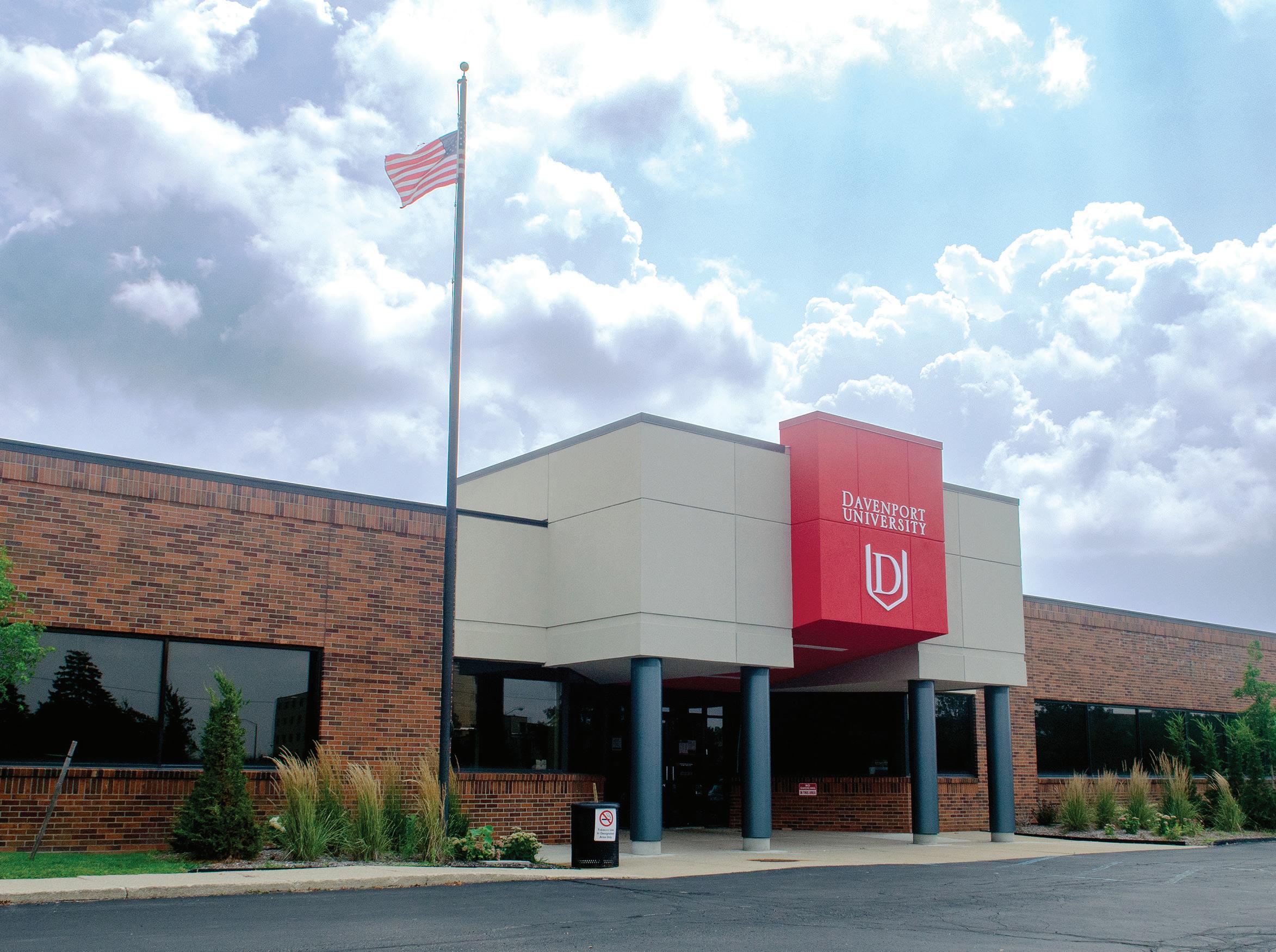
DAVENPORT UNIVERSITY DETROIT
From the Top
resource management, information systems management, marketing, small business management, and supply chain management.
umdearborn.edu/cob; 313-593-5460
UNIVERSITY OF PHOENIX
DETROIT
Undergrad programs: Bachelor’s in business and business management. phoenix.edu; 313-324-3900
WALSH COLLEGE TROY | Private
Undergrad programs: Online and on-campus bachelor’s programs in accountancy, finance, general business, human resource management, management, marketing, applied management, and information technology. walshcollege.edu; 248-823-1600
WAYNE STATE UNIVERSITY DETROIT
Undergrad programs at the Mike Ilitch School of Business: Bachelor’s degrees with concentrations in accounting, entrepreneurship and innovation, finance, global supply chain management, information systems management, management, and marketing.
ilitchbusiness.wayne.edu; 313-577-4505
Sources: Listings reflect programs offered by a college’s business school, where such business schools exist. This list does not include certificate programs or minors. All universities are public unless otherwise noted.
BAKER CENTER FOR GRADUATE STUDIES
CADILLAC, JACKSON, MUSKEGON, OWOSSO, ROYAL OAK | Private
Graduate programs: MBAs in accounting, business administration, business intelligence, finance, health care management, human resource management, information systems, and leadership studies. baker.edu; 855-487-7888
CLEARY UNIVERSITY
DETROIT, HOWELL | Private
Graduate programs: MBA and MS degrees are offered 100 percent online. Master’s degree focuses include analytical efficiency; financial planning; health care leadership; strategic leadership; women’s leadership; human resources management; and culture, change, and leadership. cleary.edu; 800-686-1883
CONCORDIA UNIVERSITY
ANN ARBOR | Private Christian University
Graduate programs: A doctorate in business administration (DBA) is available, along with MBAs with specializations in accounting, communications and public relations, finance, health care administration, human resources management, information science and digital technologies, innovation and entrepreneurship, leadership, management, management information systems, nonprofit management and public administration, sports and entertainment business, and more. cuaa.edu/business; 734-995-7300
DAVENPORT UNIVERSITY
DETROIT | Private
Graduate programs: MBA programs with specializations in general business, administration and finance, health care management, human resource management, managerial accounting, marketing, data mining, leadership strategies, predictive analytics and data visualizations, and
strategy management. A Master of Management is available, along with a Master of Accountancy. davenport.edu; 800-686-1600
EASTERN MICHIGAN UNIVERSITY
YPSILANTI
Graduate programs: MBAs with 14 different areas of specialization; MS degrees in accounting, arts administration, clinical research administration, finance, human resources management and organizational development, information systems, integrated marketing communications, taxation, and more. emich.edu/cob; 734-487-0042
LAWRENCE TECHNOLOGICAL UNIVERSITY
SOUTHFIELD | Private
Graduate programs: MBA programs are offered both online and on campus with concentrations in business administration, architecture, engineering management, information technology, and business data analytics. Students also have the option to pursue a general MBA where they can choose any combination of three graduate-level elective courses, providing the broadest range of knowledge. ltu.edu; 248-204-3050
MADONNA UNIVERSITY
LIVONIA | Private
Graduate programs: MBA offered in business administration and MS offered in accountancy, business leadership, and health services administration. madonna.edu; 734-432-5354
MICHIGAN STATE UNIVERSITY
EAST LANSING
Graduate programs: MBA programs offered in person, online, or hybrid. Full-time MBA programs in accounting; business administration; business analytics; finance; health care management; management, strategy, leadership; and marketing research.
Executive education: Executive MBA offered in Troy, East Lansing, and
online one weekend/month. A wide range of non-degree, open-enrollment programs are available, specializing in business tools and techniques, finance, leadership, and more.
Full-time MBA: 517-355-7604
Executive MBA: 517-355-7603
Executive Development Programs: 517-353-8711
msu.edu; 517-355-1855
NORTHWOOD UNIVERSITY –DEVOS GRADUATE SCHOOL MIDLAND | Private
Graduate programs: Accelerated, online, and evening MBA programs; MS in organizational leadership, business analytics, finance, and a Doctor of Business Administration are offered. devos.northwood.edu; 800-622-9000
OAKLAND UNIVERSITY
ROCHESTER HILLS
Graduate programs: Online and on-campus master’s programs include 100-percent online MBAs, part-time MBAs geared for working professionals, weekend executive MBAs for experienced professionals, and a Master of Accounting. MS degrees are offered in business analytics and information technology management. Graduate certificates include business analytics, finance, FinTech, human resource management, information security management, leadership, and marketing.
Executive education: Career-advancing educational opportunities available.
MBA: oakland.edu/business; 248-370-3287
PACE: oakland.edu/pace; 248-370-3177
UNIVERSITY OF DETROIT MERCY
DETROIT | Private Graduate programs: An MBA program geared toward working professionals is offered evenings and weekends, and may be completed in one year with a full-time class schedule. Concentrations include business administration and health services administration. Certificates in ethical leadership and business turnaround management are offered. Dual-degree programs are also available in law, computer and information systems,
and health services administration. business.udmercy.edu; 313-993-1245
UNIVERSITY OF MICHIGAN
ANN ARBOR
Graduate programs at the Ross School of Business: Full-time MBA program; part-time evening, online, and weekend MBA programs; and an executive MBA program are available in Ann Arbor. The school also offers master’s degrees in management, accounting, and supply chain management.
Executive education: There are a wide range of customized and open-enrollment programs designed to develop individual specializations and strengthen organizations. MBA: michiganross.umich.edu; 734-615-5002
Executive education: michiganross.umich.edu/programs/ executive-education; 734-763-1000
UNIVERSITY OF MICHIGAN
DEARBORN
Graduate programs: Earn master’s degrees with courses available weekday evenings, online, or through a combination of the two. MBA and MS programs are offered in accounting, business administration, business analytics, finance, information systems, marketing, and supply chain management. Dual-degree options are also available. umdearborn.edu/cob/ grad-programs; 313-593-4776
CONCORDIA UNIVERSITY
ANN ARBOR

Graduate programs: Master of Business Administration online and in person, along with a Master of Management.
phoenix.edu; 313-324-3900
TROY | Private
Graduate programs: Online and on-campus master’s programs including a Master of Business Administration, four MBA dual-degree programs, a cyber MBA, the Walsh/ Kettering tech MBA, and the INSOFE International Tech MBA with a concentration in data science. MS programs include accountancy, data analytics, finance, information technology and IT leadership,
management, marketing, and taxation. A Doctor of Business Administration is available. Executive education: Custom training including professional development, test prep, and continuing education for business certifications.
walshcollege.edu; 248-823-1600
DETROIT
Graduate programs at the Mike Ilitch School of Business: MBAs offered part-time and evenings, with 13 concentrations available online or on-site in accounting systems, entrepreneurship and innovation, sports and entertainment management, and health care supply chain management. The school also offers master’s degrees in accounting,
finance, data science and business analytics, and automotive supply chain management. Ph.Ds. are also available.
ilitchbusiness.wayne.edu; 313-577-4723
Sources: Listings reflect programs offered by a college’s business school, where such business schools exist. This list does not include certificate programs or minors. All universities are public unless otherwise noted.
1. UNITED WHOLESALE MORTGAGE
585 South Blvd. E Pontiac 800-981-8898
uwm.com
Top local executive: Mat Ishbia, president & CEO
Total residential loan volume (2023): $89.9B (through Q3-23)
Total residential loan volume (2022): $127.2B
Loans closed (2023): 225,970 (through Q3-23)
Loans closed (2022): 348,499
2. ROCKET MORTGAGE CO.
1050 Woodward Ave. Detroit
800-610-5499
quickenloans.com
Top local executives:
Dan Gilbert, founder and chairman; Bob Walters, CEO
Total residential loan volume (2023): $61.5B (through Q3-23)
Total residential loan volume (2022): $133.1B
Loans closed (2023): NA
Loans closed (2022): NA
3. NORTHPOINTE BANK
3333 Deposit Drive NE Grand Rapids 888-672-5626
northpointe.com
Top local executive: Charles Williams, founder, president, CEO
Total residential loan volume (2023): $8.8B
Total residential loan volume (2022): $12.4B
Loans closed (2023): 25,154
Loans closed (2022): 42,065
4. SUCCESS MORTGAGE PARTNERS*
1200 S. Sheldon Rd., Ste. 150 Plymouth 734-259-0880
successmortgagepartners.com
Top local executive: Allison Johnston, president
Total residential loan volume (2023): NA
Total residential loan volume (2022): $2.07B
Loans closed (2023): NA
Loans closed (2022): 7,689
5. VANDYK MORTGAGE CORP.
2449 Camelot Court SE Grand Rapids 888-482-6395
vandykmortgage.com
Top local executives:
Tom VanDyk, founder & chairman
Total residential loan volume (2023): $1.5B
Total residential loan volume (2022): $2.5B
Loans closed (2023): 5,377
Loans closed (2022): 9,923
6. FIRST NATIONAL BANK OF AMERICA
241 E. Saginaw St. East Lansing 800-266-7661
fnba.com.com
Top local executive:
Bruce Maguire, vice president
Total residential loan volume (2023): $1.2B
Total residential loan volume (2022): NA
Loans closed (2023): 4,749
Loans closed (2022): NA
7. TOWNE MORTGAGE CO.* 2170 E. Big Beaver Rd., Ste. A Troy 888-778-9700
townemortgage.com
Top local executive: Mark Janssen, CEO
Total
Total
(2022):
Loans
Loans closed (2022):
8.
Southfield
248-208-3902
johnadamsmortgage.com
Top local executive:
Larry Bsharah, president
Total residential loan volume (2023): $427.8M
Total residential loan volume (2022): $529.6M
Loans closed (2023): 1,734
Loans closed (2022): 2,028
9. CAPITAL MORTGAGE FUNDING
17170 W. 12 Mile Rd. Southfield 248-569-7283
lowrateonline.com
Top local executive: Harry J. Glanz,
president & co-founder
Total residential loan volume (2023): $267.3M
Total residential loan volume (2022): $319.9M
Loans closed (2023): 997
Loans closed (2022): 1,333
10. HORIZON FINANCIAL GROUP
A division of First Securities Financial Services
30150 Telegraph Rd., Ste. 320 Bingham Farms
248-538-7162
horizonfinancialgroup.com
Top local executive:
Joshua M. Rubin, president
Total residential loan volume (2023): $40.2M
Total residential loan volume (2022): $52.6M
Loans closed (2023): 138
Loans closed (2022): 183
*Did not respond to inquiries.
Source: DBusiness research
7. TOLL BROTHERS
26200 Town Center Dr., Ste. 200 Novi 248-305-4000
Permits: 48
Permit value: $21M
8. WADE JURNEY HOMES (CENTURY COMMUNITIES)
41210 Bridge St. Novi 248-621-2895
Permits: 43
Permit value: $13.6M
9. WINDMILL GROUP INC.
31333 W. 13 Mile Rd., Ste. 200 Farmington Hills 248-538-7000
Permits: 38
Permit value: $13.1M
10. PREMIER CONSTRUCTION CO. 34975 W. 12 Mile Rd. Farmington Hills 248-324-5000
Permits: 43
Permit value: $11.2M
11. INFINITY HOMES AND CO. 42400 Grand River, Ste. 112 Novi 248-449-8084
Permits: 44
Permit value: $9.9M
12. HUNTER PASTEUR 32300 Northwestern Hwy., Ste. 230 Farmington Hills 248-539-5511
Permits: 37
Permit value: $9.8M
13. VESTA HOMES INC. 3140 Kendall, Ste. A Fraser 586-889-8130
Permits: 24
Permit value: $7.3M
14. ALLEN EDWIN HOME BUILDERS 2186 East Centre St. Portage 269-321-2610
Permits: 29
Permit value: $7.2M
15. BELAGGIO HOMES, LLC 37771 W. Seven Mile Rd. Livonia
734-469-4894
Permits: 17
Permit value: $4.7M
16. MONDRIAN PROPERTIES 2113 Kohli Dr. Troy 248-680-9074
Permits: 18
Permit value: $4.6M
17. GOLDEN HOMES INC. 48661 Hayes Rd. Shelby Township 586-566-8990
Permits: 23
Permit value: $4.5M
18. PH HOMES 8255 Cascade St. Commerce Township 248-242-6838
Permits: 18
Permit value: $4.3M
19. KENSINGTON HOMES 28317 Beck Rd., Ste. E17 Wixom 248-965-0123
Permits: 19
Permit value: $3.1M
20. LASANT BUILDING INC.
7754 Hidden Ridge Lane Northville 313-920-6527
Permits: 18
Permit value: $1.5M
Source: Home Builders Association of Southeastern Michigan

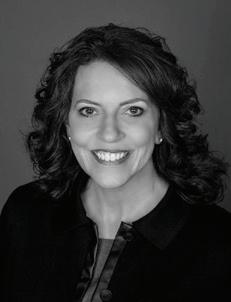
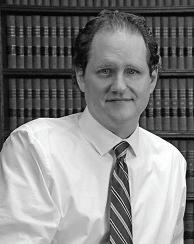


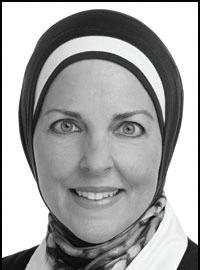

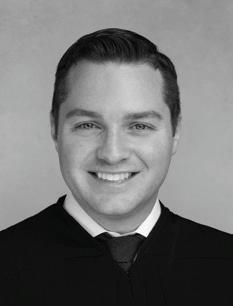



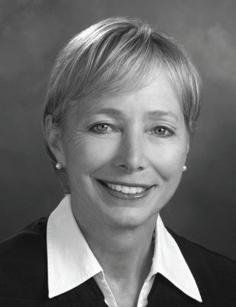


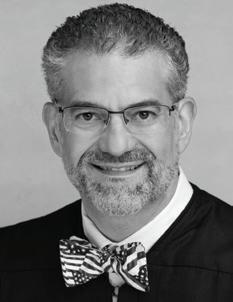






William Lambert, a Black tailor in Detroit, tapped his entrepreneurial spirit to advance the Underground Railroad.
BY RONALD AHRENSAll races joined together on May 1, 1890, as the procession of carriages left Christ Church Detroit along E. Jefferson Avenue and headed east to Elmwood Cemetery for the burial of William Lambert.
Tokens of respect included a floral piece called “The Gates Ajar,” an offering from the ladies of St. Matthew’s Episcopal Church, of which Lambert had been a founding member. The Odd Fellows honored their deceased brother with a floral representation of the order’s symbol: three interlocking links.
It was a fitting tribute for Lambert, whom the Detroit Free Press called the city’s “most prominent and distinguished colored citizen.”
Born free in Trenton, N.J., in 1817, Lambert was educated by a Quaker benefactor who opposed slavery. As a teenager, he worked as a cabin boy on various Great Lakes ships. By 1838, Lambert had set roots in Detroit, taking employment in a tailoring shop.
During this period, he met George DeBaptiste, a businessman and activist. The Detroit Anti-Slavery Society had already been organized in 1837, the year of Michigan’s statehood, and other such societies were taking root around the state.
While honing his craft, Lambert secretly participated in conducting Southern slaves on the Underground Railroad, the network of safehouses that helped escapees reach freedom in Canada.
Jamon Jordan, official historian for the City of Detroit, estimates 40,000 people came through southeast Michigan en route to Canada, and notes that the activities of the Underground Railroad were often carried out within the purview of legal authorities.
“In some cases, officials were abolitionists themselves, not willing to make arrests,” Jordan says. “In other cases, they didn’t believe the costs were worth it.” Mobs would form to protect the so-called cargo. “Even if the sheriff (or) the deputy won in the end, they were going to lose some people,” Jordan adds.

In one memorable episode, Lambert’s influence came to bear on behalf of Robert Cromwell, a fugitive slave on the run. With Cromwell’s owner, John Dun, in close pursuit, Lambert had Dun jailed until Cromwell made it into Canada.
Prior to the Civil War, Lambert had opened a small tailor and dry-cleaning shop at the corner of Brush and Larned streets. The Free Press recorded he “carried on business in a modest, unpretentious way for a number of years. Subsequently he moved to 273 Jefferson Ave.” Furthermore: “Mr. Lambert was a man of wide information, a student all of his life, and exercised the facility of expressing his ideas and opinions with more than ordinary felicity.”
He contributed articles to the Voice of the Fugitive, Canada’s first newspaper for a Black audience, which was published from 1851 to 1853 in Windsor, Ontario. He also was active in Colored Citizens of Detroit and signed the group’s letter of tribute to Sen. Jacob Howard, the abolitionist pioneer of the Republican party who died in 1871.
Another notable moment had occurred on March 12, 1859, when anti-slavery crusader John Brown arrived in Detroit with 14 runaway slaves from Missouri. Frederick Douglass, the former slave who wrote
A leader of the Underground Railroad in Detroit, William Lambert helped develop an oath among runaway slaves looking to escape to the North. Other rituals included the use of code words such as midnight, meaning “freedom,” and hand signals utilizing knuckles and forefingers.
on the cause of abolition, gave a lecture that was attended by DeBaptiste, Lambert, and others. Later that evening, Brown revealed his plan for a large-scale uprising, and seven months later he conducted his disastrous raid at Harper’s Ferry, W.V.
After the Civil War, Lambert continued to prosper, but in his old age, a doctor diagnosed him with a condition called “incipient softening of the brain.” During the last three months of his life, he “seemed to be losing his mental grasp.” At times, Lambert would be found wandering at night from his “cozy” home at 497 E. Larned St. In the end, he took his own life by hanging himself in the woodshed on his property.
The Free Press said, “Mr. Lambert had accumulated a handsome property, which is estimated at about $75,000.” Survived by his wife (unnamed in contemporary articles) and their six children, he was an enduring model of enterprise and commitment who helped lead Detroit through a turbulent time.

With unique lounges, a resort-style spa, signature restaurants, a luxury 400 room hotel and 30,000 square feet of flexible event space, we make the attendee experience GRAND.
















